SUSTAINABILITY
THE 2024 MISSION REPORT










































1/3
We bring full-scope traceability to life in our Origins label products with traceable lab-grown diamonds and artisanal and small-scale gold, with one-third of the collection containing gold and diamonds covered to date
66000 66000
HOURS OF EDUCATION TO UNDERSERVED COMMUNITIES
We contributed to our supply chain communities globally with over 66‘000 hours of tailored education for underserved communities to date

We were awarded the best employer in Switzerland by Handelszeitung and certified as a Top Employer
-4 TONS
WE REMOVED OR RECYCLED 4 TONS OF PLASTIC WASTE IN THE REPORTING CYCLE
We reduced our plastic waste in operations by engaging our employees and suppliers and co-creating waste reduction actions

VALIDATED SCIENCE-BASED TARGETS ACROSS THE VALUE CHAIN FOR CLIMATE ACTION
We validated our Science Based Targets initiative (SBTi) Corporate Net Zero Standard targets and are working to reduce our own emissions by 80% and value chain emissions by 46.2% by 2032, and achieve net zero emissions by 2050 latest
-21.6%
1.7 M CHF
SOCIAL AND ENVIRONMENTAL SUPPORT
We contributed 1.7 million CHF in funds to support social and environmental impact across our supply chain and with our partners in the reporting cycle

TASKFORCE ON NATURE-RELATED FINANCIAL DISCLOSURES EARLY ADOPTER
We expanded our efforts for nature as an early adopter of the Taskforce for Nature-related Financial Disclosures and issue our first report in the planet chapter
SCOPE 1 & 2 EMISSIONS REDUCED BY 21.6% COMPARED TO TWO YEARS AGO
We progressed on our scope 1 & 2 SBTi target and increased our purchase of renewable energy in key global markets through energy attribute certificates, reducing FY22 baseline emissions by 21.6%

FIRST EUROPEAN SUSTAINABILITY REPORTING STANDARDS ALIGNED REPORT IN THE INDUSTRY
We took the lead in transparency, publishing the first report in the industry aligned to the European Sustainability Reporting Standards (ESRS)


Throughout this anniversary year, we’re celebrating “140 Years of Firsts,” and our sustainability efforts are no exception. This milestone offers a chance to reflect on what it means to have a pioneering spirit in sustainability. Why is it important to go first, to carve a path, and to move beyond the status quo? Society progresses because of the pioneering spirit, and that desire to find a better way is a treasure of humanity.
The challenge and opportunity of sustainability calls on each of us to become pioneers and find new opportunities to contribute to our shared prosperity. This report highlights not only our work but also inspiring individuals leading change locally and globally. Their efforts showcase commitment, hard work, vision, and the ability to create change through partnership, trust, and conviction.
Meanwhile, as we look back on our own firsts in the field of sustainability, we recognize that we cannot act alone and that this pioneering spirit calls on us to act in concert to achieve results. Each of our firsts is the result of extraordinary efforts among Squad Members within and beyond Breitling, in local communities and along our value chain who are dedicated to their mission. Our industry-leading transition to fully traceable lab-grown diamonds and artisanal gold from responsible suppliers is well on track. Plastic waste in
our operations have been reduced. And as a result of the actions we are all taking, we have been ranked the Best Employer in Switzerland by Handelszeitung.
These actions embody the inclusive and sustainable aspects of the neo-luxury paradigm and the purpose with which we operate. By contributing to the well-being of nature and local communities we develop shared resiliency in our supply chain while building brand value among a customer base increasingly sensitized to sustainability. Product responsibility continues for us throughout the lifecycle, from conceptualization to repair or resale. Through these and other factors, we are able to realize tangible value creation for our brand and for our stakeholders.
These highlights are just a glimpse of our sustainability efforts at Breitling. Keep reading to discover more. I acknowledge with gratitude each individual in our “Squad on a Mission To Do Better” and look forward to all that is still to come with a sense of urgency—and tremendous opportunity.
GEORGES KERN, CEO


Our sustainability mission is a key element of our purpose and a driver to create value for our brand, our products, and our stakeholders across our pillars.
We base this in our principles for progress and implement across planet, people and governance. This ultimately impacts shared prosperity and translates our values into tangible outcomes for our products and in local communities across our sphere of influence.
PROSPERITY
We work with traceable, community-based and circular supply chains to achieve shared prosperity for all our stakeholders.
We respect natural resources across climate, water and biodiversity to develop a regenerative approach to nature and take tangible action, including on reducing plastic waste.
We engage people to take action for sustainability and support personal development to empower resilient transformation.
We conduct our business and engage with our stakeholders with the highest ethical standards and secure their privacy.
We transparently communicate our progress across the value chain to build trust among our stakeholders, who we engage in an inclusive manner throughout our efforts.
Our purpose is to inspire the dream of a casual, uplifting and meaningful life through sustainable products and a tasteful yet approachable luxury style.

Installation of solar photovoltaic panels at the Breitling warehouse in Grenchen, which produce about 600 MWh of electricity annually that is fed into the grid
PLANET
JUL 2014
Breitling commences its partnership with Ocean Conservancy, which continues for five years to February 2023, supporting their mission to create science-based solutions for a healthy ocean
PROSPERITY
MAR 2018
SETTING THE GROUNDWORK FOR SUSTAINABILITY
20132018
PLANET
Breitling Chronometrie energy consumption reduced by 50% between 2013-2018
JUL 2017 PROSPERITY
Sale of Breitling to CVC Capital Partners, a firm focused on creating sustainable value
APR 2018 PROSPERITY PROSPERITY
Launch of the Breitling Squad on a Mission campaign and neo-luxury concept: Casual, inclusive and sustainable
PROSPERITY
OCT 2018
Building upon its longstanding support of the pioneering missions of Swiss explorer Bertrand Piccard, Breitling and Solar Impulse commence a partnership that continues still today to identify and promote clean and profitable solutions for the environment
JUL 2019 PROSPERITY
Mission
PROSPERITY
AUG 2019
Breitling commences its partnership with Qhubeka to help people earn and receive bicycles, including through its sponsorship of the Double Century bike race in South Africa, with the core partnership continuing through November 2022

INDUSTRY FIRST
Each Breitling watch comes with its own NFT, a blockchainbacked proof of ownership with many benefits, including enablement of circularity by supporting “tradeability”
Breitling joins the Swiss Better Gold Association and begins work on its commitment to source artisanal and small-scale gold to achieve social and environmental impact along the value chain and support product integrity
MAR 2020
INDUSTRY FIRST
Breitling completes its inaugural EcoVadis assessment to establish a baseline measure of its sustainability performance, benchmarked against companies globally
Breitling hosts its inaugural corporate volunteering event in La Chaux-de-Fonds in cooperation with the local forestry office SEP 2020 PROGRESS
NOV 2020
Breitling joins the United Nations Global Compact Network Switzerland and Liechtenstein to advance its efforts towards responsible business practices, stakeholder dialogue, and capacity building for corporate responsibility and sustainability PROGRESS
SEP 2021
FORMALIZING OUR APPROACH, SETTING TARGETS AND REALIZING FIRST TANGIBLE ACTIONS
APR 2020 PROGRESS
Breitling hires its inaugural Head of Sustainability and begins its first double materiality assessment, engaging its global stakeholders to determine its sustainability priorities, and steadily advancing the role to global director of sustainability followed by chief sustainability officer
OCT 2020
INDUSTRY FIRST
Launch of the Breitling watch box made of upcycled plastic bottles - its small, sleek size and a change in logistics management also means that the environmental impact is reduced by almost 90% on a materials basis
DEC 2020
Breitling begins its first full-scope greenhouse gas emissions inventory
INDUSTRY FIRST
Breitling launches its inaugural Sustainability Mission Report aligned to the World Economic Forum / International Business Council Stakeholder Capitalism Metrics
Breitling commits to the validation of its greenhouse gas emissions reduction targets within two years by the Science Based Targets initiative

Breitling launches a sustainability-linked loan tied to three key targets related to plastic waste reduction, greenhouse gas reduction targets, and overall sustainability benchmarking
OCT 2021
City of Grenchen and Breitling agree to the restoration of a historic clock at the Grenchen public pool financially supported by Breitling
APR 2022
MAR 2022
JUN 2022
INDUSTRY FIRST
Breitling commits to purchase sustainable aviation fuel from Swiss International Airlines for all business travel
Citing its fundamental transformation and value potential, Partners Group increases its stake in Breitling, becoming its largest shareholder
Breitling welcomes its first Apprentices: Two in watchmaking, three in commerce and one in retail; the total number of apprentices later doubled in 2024 and is expected to double again by 2027
DEC 2022
AUG 2023
IMPLEMENTING KEY INNOVATIONS AND TRANSFORMATIVE CHANGE WITH SEP 2022
OCT 2022
APR 2023
Breitling commences support for agencies working to address the harm caused through the war in Ukraine, which is soon followed by its support of Ukrainian refugees in Grenchen, the city of its headquarters
Together with the City of Grenchen, Breitling launches street art display with renowned artist Fabian “Bane” Florin Fabe at its headquarter operations, supporting a key local revitalization project
Breitling launches its Squad on a Mission to do Better campaign
Breitling launches its partnership with Surfrider Foundation, a non-governmental organization devoted to fighting for coastal preservation and clean oceans
SEP 2023
INDUSTRY FIRST
Breitling awarded the global “Universal Fair Pay” certificate for equal pay
INDUSTRY FIRST
Breitling launches its first traceable watch, the Super Chronomat 38 Origins, with traceable artisanal and small-scale gold and lab-grown diamonds, accompanied by an enhanced traceability NFT

INDUSTRY FIRST
Breitling’s greenhouse gas emission reduction targets, aligned to the most ambitious Corporate Net Zero Standard, are validated by the Science Based Targets initiative
WITH STAKEHOLDERS
OCT 2023
DEC 2023
JAN 2024
INDUSTRY FIRST
INDUSTRY FIRST
Breitling awarded best employer in Switzerland by Handelszeitung, following its ranking as #4 in 2023 and #9 in 2022 PEOPLE PROGRESS
FEB 2024
INDUSTRY FIRST
Breitling announces 12-year partnership with Climeworks to purchase carbon removal focused on direct air capture
APR 2024
MAR 2024
INDUSTRY FIRST
Industry first: Breitling wins in the category “Best sustainable watch” in the Temporis International Awards
Breitling launches inaugural class of social impact leaders in Better Diamond Fund training program with Amani Institute in western India, where it sources lab-grown diamonds
Launch of Climate Impulse with Swiss explorer Bertrand Piccard with Breitling as official partner
Breitling reduces mismanaged plastic waste waste across operations by over 95% and scope 1 and 2 greenhouse gas emissions by over 20% compared to its baseline measurement established in 2022
INDUSTRY FIRST
Breitling publishes its first Sustainability Mission Report aligned to the European Sustainability Reporting Standards and including a Taskforce on Naturerelated Financial Disclosures report, continuing its commitment to being at the forefront of transparency
SEP 2024
JUL 2024
Breitling elected to the board of the United Nations Global Compact Network Switzerland & Liechtenstein, represented by its Chief Sustainability Officer

Our targets are aligned to our material topics which are introduced on page 25 of the report and to the United Nations Sustainable Development Goals (SDGs). For more information about these and the goals
INDICATOR
represented by the numbers noted here, please visit: THE 17 GOALS | Sustainable Development
Material topics addressed: Most material topics referenced in the target related to this full-scope assessment
Achieve EcoVadis platinum medal (top 1% globally) by end FY28 Silver medal (Top 25% globally)
Material topics addressed:
Achieve Carbon Disclosure Project (CDP) A list status in Climate by end FY28 and end FY30 for Water and Forests
Achieve 100% renewable energy for electricity globally by end FY26
Generate 0% mismanaged plastic waste across operations by end FY26
– Bronze medal (FY21)
Transition to a fully electric fleet by end FY26
Reduce Scope 1 and 2 emissions by 80% by FY32 from an FY22 baseline (market-based)
Climate: B Water: NA Forests: NA Climate: D (FY22) Water: FY25 Forests: FY25
Reduce Scope 3 emissions by 46.2% by FY32
(253 kg)
(268kg – FY23)
On track: The target has been revised to specify mismanaged plastic waste to ensure that no waste is improperly handled. It applies to our global operations activities.
– new target
tCO2e (FY22) On track: Emissions reduced by 21.6% in the reporting cycle due to the uptake of renewable energy in key markets facilitated by energy attribute certificates
tCO2e FY22: 19’282 tCO2e On track: Emissions increased due to a change in the methodology and the emissions factor, but roadmaps are in place with supply chain partners and the Breitling carbon fund is supporting transformation
14, 15

INDICATOR
Establish Science Based Targets for Nature across the value chain by end FY26
Total emissions scope 1–3 market based
People
Material topics addressed:
FY25
21’574tCO2e
tCO2e
• S1 Own workforce – Working conditions
– new target 13, 14, 15
• S1 Own workforce – Equal treatment and opportunities for all
• S2 Workers in the value chain – Working conditions
• S2 Workers in the value chain – Other work-related rights
Improve the overall EcoVadis performance for suppliers by 15% (or average score of 61) by end FY26 58 49 (FY22)
Top 25% of the global benchmark in the Glint Engagement Survey by end FY26 75 75 (FY23)
20,000 hours of stakeholder sustainability engagement (this includes, among others, sustainability training, awareness raising, and corporate volunteering events) by end FY26
35% of the Breitling workforce are active learners by end FY25
(FY23)
40% women in management positions by end FY28
(FY23)
On track: In concert with our suppliers, we have improved through exchange of best practices and performance monitoring 8, 12
Employee engagement is measured by the average score of the employees’ responses to the following 2 questions: 1/ How happy are you working at Breitling. 2/ I would recommend Breitling as a great place to work. It is benchmarked against 900 companies using Glint survey
On track: Many activities have taken place including a listening tour with 200 employees to date, with many more planned to address this ambitious and important target
Target on track: An active Learner is a person that uses Breitling’s training offerings at least once in the reporting period. Active learners are compared to average FTE for the reporting period

INDICATOR
Governance
Material topics addressed: • G1 Corporate culture
• G1 Management of relationships with suppliers including payment practices
• G1 Corruption and bribery
Prosperity
Material topics addressed:
• E1 Climate change mitigation
• E3 Water
• E4 Direct impact drivers of biodiversity loss
• E5 Resources inflows, including resource use
• S2 Workers in the value chain – Working conditions
• S2 Workers in the value chain – Other work-related rights
• S3 Community rights
• S3 Rights of Indigenous Peoples
• S4 Information-related impacts for consumers and/or end-users
Issue an enhanced traceability NFT for all main collection products containing gold and diamonds by end FY26
Integrate traceable artisanal and small-scale mined (ASM) gold across all main collection products by end FY26
(Note: Integrated goal consisting of prior targets to Achieve 100% traceable gold to support product integrity and Allocate 100% of our gold purchases to selected responsible ASGM production) 34% (net weight gold purchases)
Source lab-grown diamonds for all new main collection products by end FY26
Note: insertion of “main
(FY22)
Supply chain transformation processes advancing
On track: Transformational efforts are underway to harmonize supply chain operations and physically integrate traceable gold
(FY22)
(carats purchased)
On track: Stable supply chain in place, products made with mined diamonds before the transition completing phase-out
biogas at headquarters and production facilities
Over 75% of direct suppliers engaged in sustainability, including through annual EcoVadis assessments Gender equal pay


Breitling employees at a corporate volunteering day to support biodiversity in the
Our sustainability value creation looks beyond profit to incorporate as well planetary health and societal wellbeing. Through this approach, we are taking the first steps to create shared prosperity – and resiliency – within our sphere of influence.
strong positive effect little and no effect negative effect strong negative effect positive effect
anticipated effect based on third-party research (applies across all degrees indicated)
E1 - Climate change
E3 - Water & marine resources
E4 - Biodiversity & ecosystems
E5 - Circular economy
S1 - Own worforce
S2 - Workers in the value chain
S3 - Affected communities
S4 - Consumers and end-users
G G1 - Corporate culture
• Corporate Net Zero Standard targets validated by SBTi
• 140 years of heritage meets sustainable innovation with Climeworks carbon removal
• 100% renewable energy for electricity globally by FY26
• Certified pre-owned for long-term product durability
• Best employer attracts best talent; dedicated ESG Team
• Supplier engagement, traceability, advance compliance
• Shared resiliency through communitydetermined development activities
• Seamless omnichannel & brand institutionalization
• Strong ethical grounding helps business to flourish

BREITLING EFFORTS
• Voluntary price on carbon to disincentivize emissions and fund mitigation activities in value chain
• One of 8 early adopters in Switzerland of the Taskforce on Nature-related Financial Disclosures
• Designing with circularity at the start with upcycled materials to lower impact
First mover advantage amidst growing sustainability consciousness in luxury demand, sustainability linked loan yields margin reduction
Shared resiliency with stakeholders along supply chain, from sourcing to product next life
Shared value with upcycling, heritage development, after-sales service, resale
• “Top Employer” certified; “Best Employer” Switzerland 2024
• Use of accredited mines and responsible lab-grown diamonds
• Promotion of economic development through education, health, economic empowerment
• Blockchain-based passport for customer security, tradeability
• ESG efforts across own operations and value chain
Competitive advantage via investment in best talent
Supply chain reconfiguration anticipated compliance shifts
Building powerful storytelling across global communities rooted in action
Improved loyalty drives sales
Brand perception increases sales likelihood

As outlined in our value creation highlights summary, we look beyond profit to incorporate planetary health and societal wellbeing initiatives to create shared value. Traceability is an important aspect of adding value to our products by building upon their inherent beauty and craftsmanship to tell a global story of their creation. In addition to this, we have many aspects across our sustainability work that create value and through which we have been able to seize a first mover advantage amidst growing sustainability consciousness in luxury demand.
In this reporting period, we have been able to achieve the targets we have set for our sustainability-linked loan, reducing our direct operations, or scope 1 and 2 greenhouse gas emissions, moving towards the elimination of plastic waste across our operations, and improving our full-scope sustainability rating by EcoVadis. The progress we have made towards these objectives is detailed further within this report. It has also been advanced through our valuation of the things that matter – including placing a voluntary price on carbon following the minimum pricing guidance of the Carbon Pricing Leadership Coalition to reduce emissions and create shared value for people and planet along our supply chain. Overall, we have engaged with over 77% of our direct suppliers by spend in sustainability to drive performance across the supply chain.
Durability is also a key contributor to sustainability, and our efforts to design products to last at the outset and take responsibility for them for the long-term are detailed within the circularity section of this chapter. Our efforts to provide both repair and resale services are a fundamental aspect of customer engagement for sustainability and a proactive anticipation of societal demands for increased circularity for more sustainable consumption habits. Of course, none of these activities could occur without the contributions and commitment
of numerous stakeholders across our sphere of influence, particularly in the communities with which we are active through our supply chain engagement activities and whose activities are detailed within this chapter. All these efforts point to the shared resiliency that we can create, together with our stakeholders, to continually increase the integration of planetary health and societal wellbeing in our way of doing business. This in turn, has a positive impact on our revenue and margin development by creating a first mover advantage among a customer base increasingly sensitized to sustainability, strengthening supplier relationships and proactively preparing for an evolving regulatory landscape. Our actions are done so in a way that meets market demands while benefiting the business, as exemplified by our certified pre-owned (CPO) program.
Our efforts to attract the best talent, expand our dedicated ESG Team and engage with workers in the supply chain have been duly recognized as Breitling was awarded best employer in Switzerland for 2024, after many prior years of top rankings. These efforts are further evidenced through our designation as a top employer certified for excellence in employee conditions. It is through such acknowledgments that we gain further credibility in the labor market, which in turn helps us attracting the best talent and increasing this key competitive advantage.
Another important element of our sustainability strategy has been the continued investment into further improving customer engagement. We put our customers first by focusing on a seamless, 360 degrees omnichannel strategy, while preserving a strong ethical and data privacy grounding. Our consumers value that every Breitling watch has a blockchain-based passport, an innovation that improves watch security and tradeablity which is key to facilitating product resale. In turn, this further institutionalizes the Breitling brand and increases customer loyalty.

The ongoing investment into our own workforce shapes how our corporate culture evolves. We cultivate a corporate culture that is characterized by integrity, transparency, and ethical business practices. Through these efforts, we seize a meaningful competitive advantage in an industry for which access to specialized labor can be constrained.
Our approach to tax policy is another aspect of value creation. In line with our corporate culture, we fulfil our tax obligations, and we file all applicable tax returns with due care and prudence. We are committed to complying with all applicable tax laws and regulations without exception. While we aim to be efficient when it comes to tax, we do not enter any artificial arrangements and do not undertake aggressive tax planning. Our localizations are only driven by operational necessities. Also, we recognize that maintaining a transparent and trustworthy tax policy is crucial for brand perception, hence we invite you to explore our tax policy available in the sustainability download section of our website at Breitling.com
A key achievement in this reporting cycle has been the acquisition of Universal Genève, a celebrated watchmaker originating in the late 1800s that was renowned for its in-house movements and mythical models. This contributes to ongoing innovation for the brand, which maintains its relevance. As operations for Universal Genève are developed, they will be included accordingly in our reporting and sustainability activities in the years to come.

We transparently communicate on our progress across the value chain to build trust among our stakeholders, who we engage in an inclusive manner throughout our efforts, starting from the creation of our double materiality assessment through product repair and resale. We adopt the latest approaches to reporting, including the European Sustainability Report Standards (ESRS) or the Taskforce on Nature-related Financial Disclosures. Full-scope targets guide our progress.
European Sustainability Reporting Standards (ESRS) material topics: Progress
Each material topic is addressed in Progress, the pillar in which we outline our approach to full-scope stakeholder engagement.
Environment
Social
Governance
E1 Climate change mitigation; E1 Climate change adaptation; E3 Water; E4 Direct impact drivers of biodiversity loss; E5 Resources inflows, including resource use
S1 Own workforce – Working conditions; S1 Own workforce – Equal treatment and opportunities for all; S2 Workers in the value chain – Working conditions and Other work-related rights; S3 Community rights; S3 Rights of Indigenous Peoples; S4 Information-related impacts for consumers and/or end-users
G1 Corporate Culture; G1 Management of relationships with suppliers including payment practices; G1 Corruption and bribery; G1 Animal Welfare
INDICATOR
Material topics addressed: All material topics referenced in the target related to this full-scope assessment
Achieve EcoVadis platinum medal (top 1% globally) by end FY28 Silver medal (Top 25% globally)
Key Performance Indicators
Morningstar Sustainalytics ESG Risk Rating
50/100 –Bronze medal (FY21)
On track: Score improvement of 2% in the last reporting cycle
15.0 - low risk (FY23) Due to an update in the methodological process assigned to our scoring, FY23 is assumed as the baseline year
S&P Global Corporate Sustainability Assessment Rating 31/100 34/100 (FY22)
A change in methodology contributed to a score downgrade. The latest score is based on 2023 Breitling Sustainability Mission Report data. The updated score will be published end of 2024 reflecting our progress made in FY24.
As these ratings assess the full scope of corporate sustainability performance, they relate to a number of SDGs, including 5, 6, 7, 8, 9, 10, 12, 13, 14, 15, 17

DOUBLE MATERIALITY ASSESSMENT
S4 Information-related impacts for consumers and/or end users E1 Climate change adaptation
E4 Direct impact drivers of biodiversity loss;
E5 Resources inflows, including resource use;
E5 Resource outflows related to products and services; E3 Water, E1 Climate change mitigation
S3 Community rights; S3 Rights of Indigenous Peoples
Own workforce – Working conditions; Own workforce – Equal treatment and opportunities for all
S2 Workers in the value chain – Working conditions and other work-related rights
G1 Management of relationships with suppliers including payment practices; G1 Corruption and bribery
G1 Protection of whistleblowers
EUROPEAN SUSTAINABILITY REPORTING STANDARDS (ESRS) & CORPORATE SUSTAINABILITY
TASKFORCE FOR CLIMATE-RELATED FINANCIAL DISCLOSURES (TCFD)
Impact materiality
TASKFORCE FOR NATURE-RELATED FINANCIAL DISCLOSURES (TNFD)
COUNTERPROPOSAL TO THE RESPONSIBLE BUSINESS INITIATIVE (RBI) FURTHER REPORTING STANDARDS WHERE RELEVANT (E.G., WEF/IBC STAKEHOLDER CAPITALISM METRICS, GRI)

We respect natural resources across climate, water, and biodiversity to develop a regenerative approach to nature and take tangible action, including on reducing plastic. We align our efforts with key international frameworks including the Taskforce on Climate-related Financial Disclosures, the Taskforce on Nature-related Financial Disclosures and the Science Based Targets initiative, which has validated our greenhouse gas reduction targets which are aligned to the Corporate Net Zero Standard.

INDICATOR
Material topics addressed: E1 Climate change mitigation; E3 Water; E4 Direct impact drivers of biodiversity loss; S3 Community rights; E5 Resources inflows, including resource use; E1 Climate change adaptation
Achieve Carbon Disclosure Project (CDP) A list status in Climate by end FY28 and end FY30 for Water and Forests
Achieve 100% renewable energy for electricity globally by end FY26
Generate 0% mismanaged plastic waste across operations by end FY26
Climate: B Water: NA Forests: NA
Climate: D (FY22) Water: FY25 Forests: FY25
Climate: on track Water and Forests: Baseline forthcoming 6, 7, 8, 9, 12, 13, 14, 15
(FY22) On track: Increased uptake of renewable energy in key global markets through energy attribute certificates
– FY23)
On track: The target has been revised to specify mismanaged plastic waste to ensure that no waste is improperly handled. It applies to our global operations activities.
13
14, 15
Reduce Scope 1 and 2 emissions by 80% by FY32 from an FY22 baseline (market-based)
Reduce Scope 3 emissions by 46.2% by FY32
On track: Emissions reduced by 21.6% in the reporting cycle due to the uptake of renewable energy in key markets facilitated by energy attribute certificates
On track: Emissions increased due to a change in the methodology and the emissions factor, but roadmaps are in place with supply chain partners and the Breitling carbon fund is supporting transformation
Total emissions scope 1–3 market based
Establish Science Based Targets for Nature across the value chain by end FY26
SCIENCE BASED TARGETS INITIATIVE (SBTI): VALIDATED CORPORATE NET ZERO STANDARD TARETS ACROSS THE VALUE CHAIN FOR CLIMATE ACTION
TASKFORCE FOR CLIMATE-RELATED FINANCIAL DISCLOSURES (TCFD): ALIGNMENT COMPLETED
TASKFORCE ON NATURE-RELATED FINANCIAL DISCLOSURES (TNFD): EARLY ADOPTER AND FIRST REPORT ISSUED

We engage people to take action for sustainability and support personal development to empower resilient transformation. We address material impacts affecting stakeholders across our value chain, from our supply chain partners to our employees, our customers and communities across the globe. We are recognized as a Best Employer in Switzerland by Handelszeitung.


SUPPLIERS: SUPPORT AND PARTNERSHIP FOR CAPACITY BUILDING
COMMUNITIES: ENGAGEMENT AND IMPACT AT A GLOBAL SCALE

SQUAD ON A MISSION TO DO BETTER WE ENGAGE PEOPLE TO TAKE ACTION FOR SUSTAINABILITY AND SUPPORT PERSONAL DEVELOPMENT TO EMPOWER RESILIENT TRANSFORMATION

EMPLOYEES: EDUCATION AND EMPOWERMENT FOR SUSTAINABLE TRANSFORMATION
CUSTOMERS: TRANSPARENCY AND ENGAGEMENT FOR AWARENESS AND BRAND VALUE


We work with traceable, community-based and circular supply chains to achieve shared prosperity for all our stakeholders, from communities in our upstream value chain to Switzerland, where the bulk of our production activities occur and to communities in our global markets. As a quintessential input to our business model that shapes demand for our products, it is in our own interest to contribute to shared global prosperity within our sphere of influence. As a part of our efforts, we partner with several organizations globally to deliver services co-created with communities, including tailored education to under-served populations and environmental action, among others.
Further key topics addressed in prosperity Traceability and transparency Community-based value chains
traceable artisanal and small-scale mined (ASM) gold across all main collection products by end FY26 (note: Integrated goal consisting of prior targets to Achieve 100% traceable gold to support product integrity and allocate 100% of our gold purchases to selected responsible ASGM production)
Source lab-grown diamonds for all new main collection products by end FY26
(net weight gold purchases)
track: Transformational efforts are underway to harmonize supply chain operations and physically integrate traceable gold
(carats purchased) 0% (FY22) On track: Stable supply chain in place, products made with mined diamonds before the transition completing phase-out

Traceability and transparency-based business model
We build trust among our stakeholders through the keystones of traceability and transparency. Our proactive investments since 2020 have placed us in an advanced and industry-leading position to meet consumer demands and regulatory requirements alike.

By knowing the origins of our products, we can engage at the human and ecosystem-level in local communities. Our engagement contributes to shared resiliency.

CIRCULARITY AND PRODUCT RESPONSIBILITY
We take responsibility for our products across their lifespan. We are increasingly integrating upcycled and circular materials, working to design for circularity across our business and offer readily accessible repair and resale services.

We conduct our business and engage with our stakeholders with the highest ethical standards and securing their privacy. We proactively manage sustainability at Breitling, guiding our efforts at the highest management level. Our actions are guided by a full-scope suite of policies publicly available on our website.

AUDIT & RISK COMMITTEE
INTERNAL AUDIT
BREITLING’S GOVERNANCE MODEL WITH FOCUS ON SUSTAINABILITY
SHAREHOLDERS AND GENERAL MEETINGS
BOARD OF DIRECTORS
CHIEF EXECUTIVE OFFICER
ESG COMMITTEE
NOMINATION & COMPENSATION COMMITTEE
EXECUTIVE MANAGEMENT
EXECUTIVE MANAGEMENT MEMBERS ACROSS BREITLING CONTRIBUTE TO FULL-SCOPE SUSTAINABILITY EFFORTS ACROSS THE PRODUCT, COMMERCIAL, MARKETING, OPERATIONS, FINANCE, DIGITAL & TECHNOLOGY, PEOPLE, AND ADMINISTRATION FUNCTIONS.
CHIEF ADMINISTRATIVE OFFICER
CHIEF SUSTAINABILITY OFFICER AND SUSTAINABILITY DEPARTMENT
INTERNAL BREITLING SUBJECT MATTER EXPERTS, EXTERNAL EXPERTS, SUPPLIERS, STANDARD AND CRITERIA SETTERS, VERIFICATION PROVIDERS, AND FURTHER AFFECTED GROUPS



We transparently communicate on our progress across the value chain to build trust among our stakeholders, who we engage in an inclusive manner throughout our efforts, starting from the creation of our double materiality assessment through product repair and resale. We adopt the latest approaches to reporting, including the European Sustainability Report Standards (ESRS) or the Taskforce on Nature-related Financial Disclosures. Full-scope targets guide our progress.
Gender equality
water and sanitation 7 Affordable and clean energy 8 Decent work and economic growth 9 Industries, innovation and infrastructure 10 Reduced inequalities 12 Responsible consumption and production 13 Climate action 14 Life below water 15 Life on land 17 Partnerships for the goals
European Sustainability Reporting Standards (ESRS) material topics: Progress
Each material topic is addressed in Progress, the pillar in which we outline our approach to full-scope stakeholder engagement.
Environment
Social
Governance
INDICATOR
E1 Climate change mitigation; E1 Climate change adaptation; E3 Water; E4 Direct impact drivers of biodiversity loss; E5 Resources inflows, including resource use
S1 Own workforce – Working conditions; S1 Own workforce – Equal treatment and opportunities for all; S2 Workers in the value chain – Working conditions and Other work-related rights; S3 Community rights; S3 Rights of Indigenous Peoples; S4 Information-related impacts for consumers and/or end-users
G1 Corporate Culture; G1 Management of relationships with suppliers including payment practices; G1 Corruption and bribery; G1 Animal Welfare RELATED SUSTAINABLE DEVELOPMENT GOALS (SDGS) 4 Quality education
Material topics addressed: All material topics referenced in the target related to this full-scope assessment
Achieve EcoVadis platinum medal (top 1% globally) by end FY28 Silver medal (Top 25% globally)
Key Performance Indicators
Morningstar Sustainalytics ESG Risk Rating
S&P Global Corporate Sustainability Assessment Rating
50/100 –Bronze medal (FY21) On track: Score improvement of 2% in the last reporting cycle
15.0 - low risk (FY23) Due to an update in the methodological process assigned to our scoring, FY23 is assumed as the baseline year
31/100 34/100 (FY22)
A change in methodology contributed to a score downgrade. The latest score is based on 2023 Breitling Sustainability Mission Report data. The updated score will be published end of 2024 reflecting our progress made in FY24.
As these ratings assess the full scope of corporate sustainability performance, they relate to a number of SDGs, including 5, 6, 7, 8, 9, 10, 12, 13, 14, 15, 17

S4 Information-related impacts for consumers and/or end users
E4 Direct impact drivers of biodiversity loss; E5 Resources inflows, including resource use; E5 Resource outflows related to products and services; E3 Water, E1 Climate change mitigation
S3 Community rights; S3 Rights of Indigenous Peoples
Own workforce – Working conditions; Own workforce – Equal treatment and opportunities for all
S2 Workers in the value chain – Working conditions and other work-related rights
G1 Management of relationships with suppliers including payment practices; G1 Corruption and bribery
G1 Protection of whistleblowers
TASKFORCE FOR CLIMATE-RELATED FINANCIAL DISCLOSURES (TCFD)
COUNTERPROPOSAL TO THE RESPONSIBLE BUSINESS INITIATIVE (RBI) FURTHER REPORTING STANDARDS WHERE RELEVANT (E.G., WEF/IBC STAKEHOLDER CAPITALISM METRICS, GRI) EUROPEAN
TASKFORCE FOR NATURE-RELATED FINANCIAL DISCLOSURES (TNFD)

At Breitling, we are committed to adopting the most forward-looking approaches for sustainability. Among these is our approach to reporting. In this reporting cycle, we have chosen to proactively adopt the European Sustainability Reporting Standards. Since publishing our first Sustainability Mission Report in 2021 in line with the World Economic Forcum (WEF) International Business Council (IBC) Stakeholder Capitalism Metrics and the Task Force on Climate-Related Financial Disclosures (TCFD), we have steadily increased disclosures. While we continue to report in line with the TCFD and now in addition the Taskforce on Nature-related Financial Disclosures (TNFD), this year will be the first report based on the Corporate Sustainability Reporting Standard (CSRD) and the underlying European Sustainability Reporting Standards issued by the European Financial Reporting Advisory Group (EFRAG).
We have chosen to do so in order to uptake what is widely seen to be the new global standard in sustainability reporting and in so doing, expand our approach to transparency following this rigorous framework. We issue this first report based on the CSRD in advance of our regulatory requirement which commences from 2026.
Breitling is first and foremost a Swiss-based company, with the vast majority of value addition occurring in Switzerland. We also have key material impacts occurring, including in material sourcing, that are detailed herein.
The data provided in this Sustainability Mission Report corresponds to Fiscal Year 2024 (April 2023 – March 2024) and is consolidated according to the same principles as the financial disclosures, covering Breitling SA, each of its subsidiaries, and each employee thereof.
With the adoption of the counterproposal to the Responsible Business Initiative (RBI) new due diligence obligations are introduced to Swiss legislation (Art. 964j-l of the Swiss Code of Obligations) addressing conflict minerals and metals as well as child labor. With the counterproposal to the RBI, Swiss companies will face non-financial reporting obligations related to the aforementioned topics starting with the 2023 financial year. Companies dealing with conflict minerals or metals or at risk of child labor are required to perform additional due diligence. Art. 964j para. 4 of the Swiss Code of Obligations provides for an exemption from due diligence and reporting obligations by following internationally recognized equivalent regulations. The ESG Policy contains pertinent disclosures on conflict minerals and metals, while the approach to child labor is outlined in the People chapter, including the adoption of the ESG Policy as an implementation measure. In doing so, we apply the previously indicated exemption by referencing relevant and internationally recognized regulations.

The double materiality assessment allows us to assess both our impact on people and planet alongside the impacts, risks and opportunities these entail for our stakeholders and for Breitling itself. It is a vital tool to ensure regulatory compliance, steer our sustainability strategy in the right direction, and foster long-term value creation. This foundational element guides our actions and informs our reporting structure. In adopting the ESRS, we have in turn updated our assessment, which is described in this chapter.
We have aligned our double materiality assessment (DMA) for the first time this year with the guidance and definitions outlined in the European Union Corporate Sustainability Reporting Directive’s European Sustainability Reporting Standards (ESRS) 1: General Requirements, released on July 31, 2023. Building upon our experience gathered from past materiality assessments applied since 2020, we have adopted this fundamental transformation in our non-financial reporting.
The DMA process began in January 2024, closely following the guidance provided by ESRS 1: General Requirements and included the step-by-step process of understanding, identifying, assessing, and determining impacts, risks, and opportunities (IROs) to our business according to financial materiality, or the impact that could be experienced by the Breitling Group and impact materiality, or the impact that could be experienced by Breitling Group stakeholders.
During the process 26 internal subject matter experts were included at various stages of the process to ensure a complete understanding of actual and potential IROs across our value chain. The identification made of material topics, according to financial and impact materiality, was then expanded to a broad external stakeholder group to further assess impact materiality.
As laid out by the ESRS, an initial step included the identification and classification of two stakeholder groups. Firstly, the affected stakeholders who are individuals or groups whose interests are affected or could be affected by our activities across the value chain. Secondly, users (e.g., readers) of a sustainability statement, who can affect Breitling and/or are primary users of our sustainability statement, such as the annual Breitling Sustainability Mission Report.
Following a stakeholder mapping we identified internal and external stakeholders for both stakeholder groups who were to be included in the assessment, based on the impact Breitling has on the stakeholder and the influence the stakeholder has on Breitling. All stakeholders were scored on a scale from 1 to 10 regarding the extent to which the stakeholders are or could be affected by Breitling and the extent to which the stakeholders affect or could affect Breitling. For the purpose of the DMA, a prioritization of stakeholder groups was done by including stakeholders with a higher score on one or both of the criteria (>5). The prioritization of stakeholders is set to include the most affected stakeholders and stakeholders that can most affect Breitling.
Our affected stakeholders include our employees (internal), customers (external), local communities (external), suppliers (external) and workers in the value chain (external). Secondly, Breitling management (internal), investors (external), Breitling sustainability representatives (internal), Breitling subject matter experts (internal), and suppliers (external) were considered to have an influence on Breitling.

The DMA process is fundamental, and in concert with our stakeholders , and with the support of PwC Switzerland, we deeply engaged in the effort in order to ensure a robust outcome. To support this approach, prior to conducting the assessment, an extensive list of potentially material sustainability matters was created to establish the structure of, and scope the assessment. In this process, a long-list of sustainability matters (topics, sub-(sub-)topics) was created including sectoragnostic sustainability matters covered in topical ESRS, sector-specific topics from the Sustainability Accounting Standards Board (SASB), which establishes industrybased sustainability disclosures, entity-specific sustainability matters from internal documentation and external sources, and previously conducted impact and risk assessments. This was complemented by insights from ongoing stakeholder engagement that was guided by the ESRS framework. Once this step was complete, we combined related and overlapping sub-topics and sub-sub-topics into sustainability clusters (topics).
Once the sustainability matters were clustered, we determined focus areas across the value chain, namely, upstream, own operations, and downstream, and business segments (watches & indirect procurement materials, food, beverage and entertainment as well as cross-activities) for each of these clusters. Thereby, we considered where impacts, risks and opportunities are likely to arise, based on the nature of our activities, business relationships, geographies, and other risk factors. This enabled us to visualize the sustainability clusters along the value chain and obtain a list of sustainability clusters and corresponding sustainability matters that are potentially relevant and established the foundation of the second step, the identification of impacts, risks and opportunities (IROs) where we identified IROs for each sustainability matter.
Impacts in relation to environmental, social and governance matters were considered. This implies, for example, that for a given environmental sub-(sub-)topic there can be an impact on the environment and/or people. Impacts are defined as an impact on either the stakeholder group or the environment or on the effect on wellbeing, welfare, human rights, or state of the environment through our business activities or those of business partners. These are caused directly or contributed to by Breitling or can be linked to our operations, products, and services. Impacts can either be positive or negative, and it is important to mention that negative impacts cannot be “offset” by positive impacts.
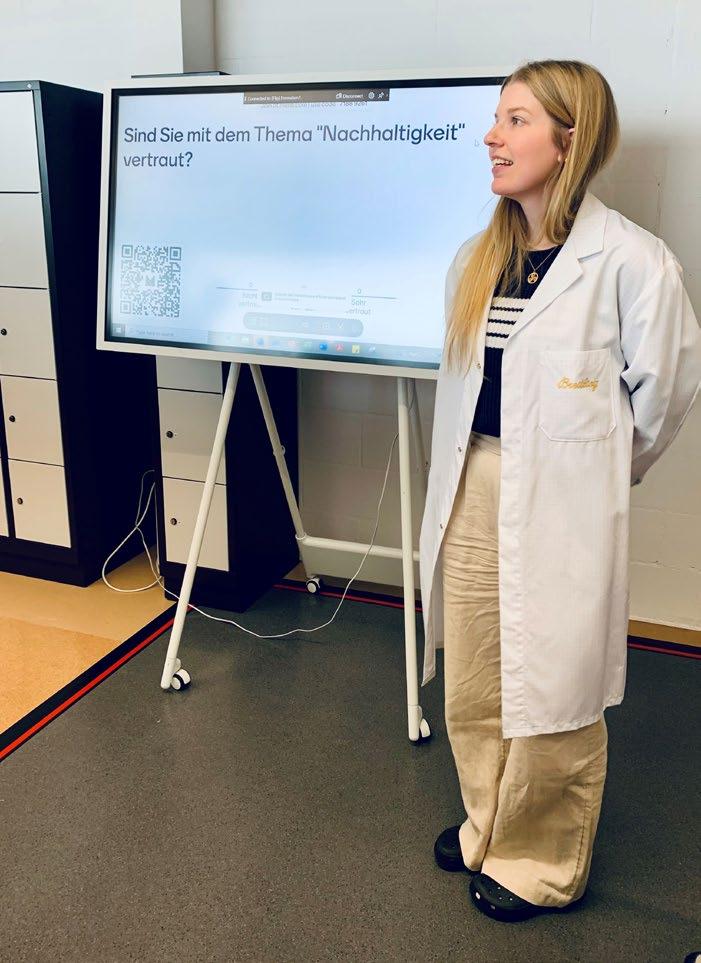
Pauline Braun, Sustainability Specialist at Breitling, facilitates an on-site session on sustainability in German, one of our three official languages at headquarters, in an assembly workshop of Breitling in Grenchen, Switzerland

Positive impacts are benefits for people and/or the environment caused or contributed to by Breitling, and which have a direct link to our own operations, products, services or our business relationships.
Additionally, a positive or negative impact can be either actual or potential. An impact that has already occurred is defined as actual and an impact which could occur in the future is described as potential.
Risks and opportunities consider exogenous factors and act as the “outside-in lens” of the DMA. Risks are mostly correlated to business performance and could lead to a negative deviation in future expected cash inflows or increase in deviation in future expected cash outflows. Opportunities represent the opposite and contribute to positive deviation in future expected cash inflows or decrease in deviation in future cash outflows. Both risks and opportunities can be derived from past or future events and can be trigger-effects by influencing the ability to continue to use or obtain the resources needed and by affecting the ability to rely on relationships needed in business processes on acceptable terms.
Based on these indicators the core DMA project team, consisting of the sustainability team and key subject matter experts pre-identified IROs based on existing sustainability documentation, Taskforce on Climate and Nature-related Financial Disclosures, risk assessments and previously completed stakeholder consultations. The identification of IROs was further completed by making sure all parts of the value chain were covered per sustainability matter. During workshops with internal subject matter experts this list was further expanded through comprehensive reviews of the pre-identified IROs based on completeness, relevance, and correctness, and adding any missing or deleting any irrelevant IROs. Through this comprehensive approach, we feel confident in the robustness of this DMA baseline, which we will continue to revisit to ensure it is up to date.
As for the previous stage, a pre-assessment of all IROs was completed to the extent possible by the core DMA project team and internal experts were assigned to review the assessment when completed. Additionally, internal experts were consulted in their area of expertise to provide their assessments. Further adjustments to the assessment were done in workshops to reduce bias from specific functions. Lastly, the complete assessment of IROs was shared with the Enterprise Risk Management team for final review, given their similar work on risks faced by Breitling.
The identified impacts have been scored using the parameters of “scale”, “scope”, “irremediable character” (in case of negative impact) and “likelihood” (in case of potential impacts), with the assessment following ESRS guidance. All parameters were assessed on a scale from zero to five.
When assessing the “scale”, we analyzed how grave the negative impact is or how beneficial the positive impact is for the people or the environment. “Scope” assesses how widespread the impact is. This could range from a location specific environmental impact affecting a low number of people up to having a global environmental impact or impacting a substantial number of people. When assessing the “remediable character”, we analyzed the difficulty of counteracting the negative impact which could range from being relatively easy to remedy, up to non-remediable or irreversible. The likelihood scale followed existing internal precedent developed in stakeholder consultations by our risk management team and in line with other risks assessments conducted internally.

For each impact, the scale, scope and remediable character were added, the sum divided by three (if negative) or two (if positive) and multiplied by the likelihood of the impact occurring. This resulted in the impact materiality of each impact. Negative human rights impacts were always considered to have the highest possible likelihood of one, or 100% in the assessment scale, meaning that they were automatically considered to be an actual impact with a high certainty of occurrence given the magnitude of such impacts.
Assessment parameters for identified risks and opportunities were the magnitude of the financial effect and the likelihood. The assessment of the magnitude of financial effect was measured through the quantitative and qualitative risk/opportunity. While the quantitative risk/opportunity referred to a financial term the qualitative risk/opportunity assessed the threat/ damage or benefit to relationships with stakeholders and reputation. To calculate the financial materiality, the higher score of either the quantitative or the qualitative risk/opportunity was multiplied by the likelihood. All parameters assessing risks and opportunities were aligned with the Breitling Enterprise Risk Management team and previously conducted risk assessments. When assessing risk and opportunities the actual exposure, or the residual risk remaining after risk mitigation actions were taken into account to duly consider the controls that are in place.
Once the assessment was completed, all IROs were aggregated on topic level using the max aggregation method, meaning the highest impact materiality and financial materiality score of the IROs under one sustainability topic was used for the aggregation of that sub-topic instead of using an average calculated approach. This method helped us to prioritize and appropriately represent when setting the thresholds the most critical sustainability issues by ensuring the selection of the highest scoring IROs which are likely to have a significant impact on the business and stakeholders. Furthermore, the maximum aggregation
method is a transparent way to aggregate topics and helps enable stakeholders to gain a clear understanding on the most impactful sustainability topics.
It is a straightforward and simple approach to identify and prioritize material sustainability issues, particularly for stakeholders such as investors who seek a clear understanding of the most impactful sustainability topics.
The aggregation of IROs was made on a sub-topic level and later aggregated to ESRS topic level by taking the maximum value of the sub-topics. The aggregated list of ESRS topics and their materiality scores was shared with internal stakeholders who were involved in the assessment along with the topics mapped out in a matrix against impact materiality and financial materiality. The results positively resounded with the diverse group of internal subject matter experts and the input they provided, thereby confirming the positioning of the material topics. When determining the threshold, a proactive approach was adopted, which resulted in approximately 50% of ESRS sub-topics being considered material. This approach ensures a complete reporting of our material sustainability topics, improved ability to assess ESG risks and a greater alignment with stakeholders’ expectations by integrating horizon sustainability topics at an earlier stage, with the potential to have a positive impact on all who are potentially affected through this proactive approach.
While drafting the report, disclosure requirements that are mandatory irrespective of the outcome of the materiality assessment (ESRS 2) as well as the disclosures for material sustainability matters were considered and an incorporation by reference approach was chosen by including all ESRS disclosures in the sustainability statement chapters of Prosperity, Planet (environmental), People (social) and governance. For more information, please find the full ESRS sub-subtopic index including all mandatory datapoints in the download center

Stakeholder engagement is essential to Breitling. We chose an inclusive approach when defining our sustainability priorities, also to duly reflect our values. We made our external stakeholder consultation available to a diverse set of stakeholders, including our employees, and to the public through a post on the Breitling LinkedIn account. Participants were invited to participate under the condition of anonymity, in order to allow honest and transparent input. In order to include a global perspective, we took the effort to translate the survey into a number of key languages, including English, French, Japanese and Chinese (simplified). Ultimately, over 200 participants provided a diverse set of perspectives which enhance the resiliency of our sustainability strategy.
We used the opportunity to also survey participants on their perceptions of sustainability, areas of hope and concern, material topics, and more. This allows us to better understand stakeholder sentiment regarding sustainability. Overall, our stakeholders indicated a very slightly positive feeling about the outlook for sustainability related topics, with an average of 5.9 on a scale from 1 to 10 (very negative – extremely positive). At the same time, they expressed feeling very empowered to be a part of sustainability transitions, particularly in their private lives.
With regards to sustainability generally (not specific to Breitling), our stakeholders indicated general concern about (plastic) waste, lack of transparency, overconsumption, greenhouse gas emissions, energy consumption, human rights, and marine conservation, among others. Areas of hope were related to growing sustainability commitments, research and development, material innovation, community engagement, setting of SBTi targets, adoption of lab-grown diamonds, transparency, boosting of circular business models, and sensitivity to the topic of sustainability by younger generations. It is worthwhile to note that these areas closely reflect our sustainability actions and provide evidence of a resonance between our actions and the general interests of our stakeholders.
With regards to our material topics, survey participants were asked to assess the impact materiality only and not financial materiality due to the lack of information needed to evaluate material topics from this perspective. For three of our material topics, our stakeholders have ranked the impact materiality to be significantly higher for climate change adaptation (increase of approximately three points), and somewhat higher for animal welfare and corporate culture (increase of approximately one point).
Our survey participants considered our full scope sustainability performance to be above average, with 3.9 on a scale from 1 to 5 (very poor – excellent). We also invited our participants to share areas of improvement. They indicate the need for the continuation of sustainability awareness raising with customers, increasing accessibility to sustainability initiatives, applying circular business models, and improving efforts related to water and biodiversity, among others.
Performance highlights indicated by stakeholders included material sourcing, community investment, employee engagement, supply chain transparency and traceability, ESG reporting, SBTi target validation, and early adoption of recycled materials. Our survey participants also requested more information and exchange, sharing of learnings, and continued stakeholder sustainability engagement within our own workforce and across the value chain.
As a result of this feedback, we will in the ongoing and future reporting cycles consider how we can duly reflect this stakeholder feedback in our efforts. We would like to sincerely thank each participant who took the time to share their highly valued perspective, which is essential as we continue to guide our efforts.

BREITLING CUSTOMER
BREITLING EMPLOYEE
INDUSTRY REPRESENTATIVE
MEDIA REPRESENTATIVE
NON-GOVERNMENTAL ORGANIZATION REPRESENTATIVE
SHAREHOLDER STUDENT INVESTOR
SUPPLIER
SUSTAINABILITY EXPERT
OTHER REPRESENTATIVE OF NATURE
GEOGRAPHIC DISTRIBUTION
AFRICA ASIA EUROPE
NORTH AMERICA
OCEANIA
SOUTH AMERICA
PREFER NOT TO SAY
ETHNIC DISTRIBUTION
ASIAN/PACIFIC ISLANDER BLACK
HISPANIC
INDIGENOUS WHITE/CAUCASIAN MULTIPLE ETHNICITIES
PREFER NOT TO SAY OTHER

GENERATION Z MILLENNIAL GENERATION X
BABY BOOMER
SILENT GENRATION
GREATEST GENERATION
PREFER NOT TO SAY
GENDER DISTRIBUTION
FEMALE MALE NON-BINARY
PREFER NOT TO SAY OTHER
SOCIO-ECONOMIC DISTRIBUTION
LOWER CLASS
MIDDLE CLASS
UPPER CLASS
PREFER NOT TO SAY
OTHER

The change in reporting frameworks from the World Economic Forum International Business Council Stakeholder Capitalism Metrics to ESRS/CSRD is accompanied by a change in methodology, and hence, in material topics. The table below illustrates the material topics we had to date mapped against the new material ESRS topics to ensure comparability with previous reports.
Furthermore, adopted by all United Nations (UN) member states in 2015, the UN Sustainable Development Goals, or
SDGs, are a “universal call to action to end poverty, protect the planet and improve the lives and prospects of everyone, everywhere.” We continually reference the UN SDGs to align our actions with those of the 2030 Agenda for Sustainable Development and mapped them against our new material ESRS topics.

As a part of our overall commitment, we are also a signatory of the United Nations Global Compact (UNGC) Switzerland & Liechtenstein.
MATERIAL TOPICS IN 2023
Social impacts along the value chain
Environmental impacts along the value chain
Product integrity
Climate change
Employee wellbeing, engagement, health and safety
Diversity and inclusion
Customer and community engagement
Business ethics
Business model resilience
Responsible handling of data
ESRS MATERIAL TOPIC 2024
• S2: Working conditions – workers in the value chain
• S2: Other work-related rights – workers in the value chain
• S3: Community rights
• S3: Rights of Indigenous Peoples 3, 4, 5, 6, 8, 9, 10, 11, 16
• E1: Climate change adaptation
• E1: Climate change mitigation
• E3: Water
• E4: Direct impact drivers of biodiversity loss 6, 7, 9, 13, 14, 15
• E5: Resource inflows, including resource use
• E5: Resource outflows related to products and services
• S4: Information-related impacts for consumers and/or end-users
• E1: Climate change adaptation
9, 12
• E1: Climate change mitigation 7, 9, 13, 15
• S1: Working conditions – own workforce 5, 8, 10
• S1: Equal treatment and opportunities for all – own workforce 5, 8, 10
• S4: Information-related impacts for consumers and/or end-users 12
• G1: Corporate culture
• G1: Protection of whistle-blowers
• G1: Animal welfare
• G1: Management of relationships with suppliers
• G1: Corruption and bribery 8, 12, 15
• Business model resilience was fundamentally incorporated into the 2024 Double Materiality Assessment by considering the security of our supply chain resilience and our long-term business plan by addressing social, environmental and political issues -
• Not material according to the 2024 double materiality assessment -

Since formalizing Breitling’s sustainability approach in 2021, we conducted our third materiality assessment in the beginning of 2024.
As can be seen in the materiality matrix below, nine out of ten ESRS topics are material to Breitling at the proactive threshold we have selected. By adopting a proactive approach, we included approximately 50% of ESRS sub-topics, and ensured the inclusion of the most relevant topics while aiming to narrow down the scope. The only ESRS topic currently considered not material is pollution, however the topic is nonetheless assessed in our Taskforce on Nature-related Financial Disclosures reporting in the planet chapter of this report. The DMA was conducted on a sub-topic level and in the following
tables the material topic and sub-topic level impacts, risks, and opportunities are described. For each IRO, we indicate whether they affect our own operations, our upstream or downstream operations (or multiple aspects) and indicate whether the impacts are negative or positive.
There are no significant changes in material topics compared to previous materiality assessments, except for the responsible handling of data which was previously considered material and will not be addressed this year due to it not being material according to this latest double materiality assessment.
Material topics clustered according to their materiality and proximity are indicated by a box

The following table lists all impacts (positive and negative), risks and opportunities that exceeded the threshold for financial and/or impact materiality and are thus considered material. As indicated in the matrix on page 43, nine out of ten ESRS topics are material. The tables below provide details about these IROs on the sub-topic level. For each IRO we indicate its time horizon and the element of the value chain it applies to. In the case of impacts, we further clarify whether they are actual or potential.
E1 - Climate change
Climate change adaptation
Areas subject to extreme weather events
Increase in leather prices
Climate change mitigation
Meeting climate objectives
Increased cost of alternative materials development
Breitling scope 1 and 2 GHG emissions
Breitling scope 3 GHG emissions
Breitling food, beverage, and entertainment business scope 3 GHG emissions
Breitling watches and indirect procurement materials business scope 3 GHG emissions
Reduction of scope 3 GHG emissions
Upstream, own operations, downstream
Upstream, own operations

Disruption

ESRS S2 – Workers in the value chain
Working conditions
Lab-grown diamond sourcing
Health and safety in the mined diamond value chain
Other work-related rights
Forced labor in gold and diamond mines
impact Potential – for the broader gold landscape in the case of non-traceable gold and diamonds
Essential services for workers in the value chain
Child labor in the gold value chain Negative impact Actual – for the broader gold landscape in the case of non-traceable gold
Child labor in the gemstones value chain
Forced labor in the gemstones value chain
ESRS S3 – Affected communities
Promotion of wellbeing and economic development
Commitment to community engagement
Rights of Indigenous Peoples
Mining-related activities
Violation of rights of Indigenous Peoples in mining operations

Information-related
In the following pages of this report, we detail


Participants in local stakeholder engagement for social entrepreneur capacity building in the state of Gujarat in western India

We work with traceable, community-based and circular supply chains to achieve shared prosperity for all our stakeholders, from communities in our upstream value chain to Switzerland, where the bulk of our production activities occur and to communities in our global markets. As a quintessential input to our business model that shapes demand for our products, it is in our own interest to contribute to shared global prosperity within our sphere of influence. As a part of our efforts, we partner with several organizations globally to deliver services co-created with communities, including tailored education to under-served populations and environmental action, among others.
Further key topics addressed in prosperity Traceability and transparency Community-based value chains Circularity and product responsibility
(net
and small-scale mined (ASM)
across all main collection products by end FY26
Integrated goal consisting of prior targets to Achieve 100% traceable gold to support product integrity and allocate 100% of our gold purchases to selected responsible ASGM production)
Source lab-grown diamonds for all new main collection products by end FY26
(carats purchased)
track: Transformational efforts are underway to harmonize supply chain operations and physically integrate traceable gold
(FY22) On track: Stable supply chain in place, products made with mined diamonds before the transition completing phase-out

Traceability and transparency-based business model
We build trust among our stakeholders through the keystones of traceability and transparency. Our proactive investments since 2020 have placed us in an advanced and industry-leading position to meet consumer demands and regulatory requirements alike.

By knowing the origins of our products, we can engage at the human and ecosystem-level in local communities. Our engagement contributes to shared resiliency.

We take responsibility for our products across their lifespan. We are increasingly integrating upcycled and circular materials, working to design for circularity across our business and offer readily accessible repair and resale services.

A keystone of our efforts as a Squad On A Mission To Do Better is enabling traceability to attest to the social and environmental impacts across our sphere of influence. In 2022, we launched this important mission to the public with the release of Super Chronomat 38 Origins, our first watch to contain traceable gold and traceable lab-grown diamonds, the materials within our overall supply chain with the greatest potential to have meaningful social and environmental impact. With this, we released our first enhanced traceability non-fungible token (NFT), complementing that already provided to Breitling owners in an industry-leading move in 2020.
We see traceability as an absolutely essential foundation for our engagement across our pillars of progress, prosperity, planet and people. It enables us to know the communities across our value chain and understand our role as a member of these systems. It allows us to establish high-quality, primary data of our environmental and social impact and establishes the baseline upon which we report. And it enables us to transparently share our efforts with our customers and global stakeholders.
Many materials we source are commodities, and commonly processed in a manner that does not allow for traceability. This has required us, and our value chain partners, to fundamentally redesign operating methods. It is thanks to this pioneering collaboration that we have been able to transform supply chain systems and work towards integrating traceable artisanal gold and lab-grown diamonds across our collection. We see clear near-term and ongoing returns on the proactive investments we have made in terms of consumer and market relevance and regulatory adherence and recognize this as a validation of our industry-leading shift towards the traceability-based business model.
In the reporting cycle, we have been able to make meaningful strides towards achieving supply chain transformation – in concert with our highly valued partners and further industry collaborators. This will enable us to navigate towards our ambitious and industry-leading targets of achieving traceable gold and diamonds across our main collection products by the end of the next reporting cycle, or March 2026. Our decision to transition to a traceability-based business model was based on our values and guided by
the inclusive input of our global stakeholders – internal and external to Breitling – from our inaugural double materiality assessment in 2020. We find it to be futureproofed in several ways. The first concerns societal and consumer interest, which research continually points to be increasing in corporate transparency, including supply chain traceability topics. The second is the introduction of numerous regulations, for which traceability is a key enabling factor for compliance. The proactive investments we have made since 2020 place Breitling in an advanced position in order to facilitate timely uptake of key guidelines, including the Corporate Sustainability Reporting Directive and the Corporate Sustainability Due Diligence Directive, to name just two examples. Finally, traceability underpins the ongoing improvement of full-scope risk mitigation across the supply chain, through the greater understanding we have developed through these efforts.
Given the benefits listed above, we are continuing to expand our approach to the traceability-based business model across our business activities and informed from a risk-based perspective in order to prioritize our efforts to trace and engage with our value chain. We will continue to report on our efforts in our annual Sustainability Mission Report.


In less than two years, we have expanded our Origins Label for watches containing traceable gold and/or lab-grown diamonds beyond the original Super Chronomat Automatic 38 Origins to now over 25 references to date. As a result over 30% of all products containing gold and diamonds now hold our Origins label.
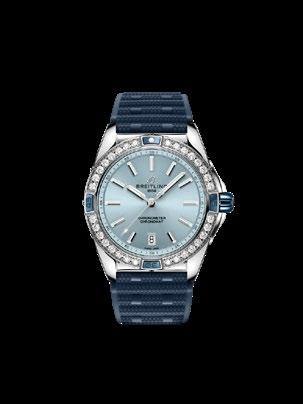
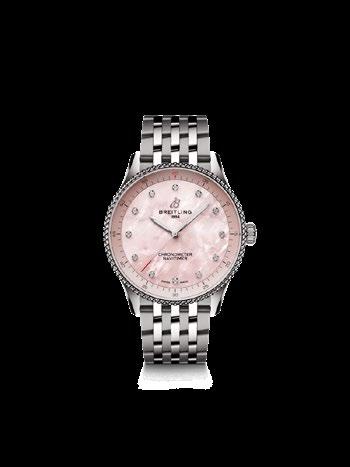


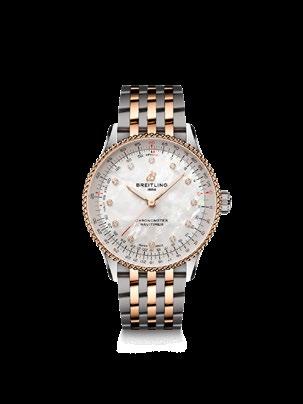



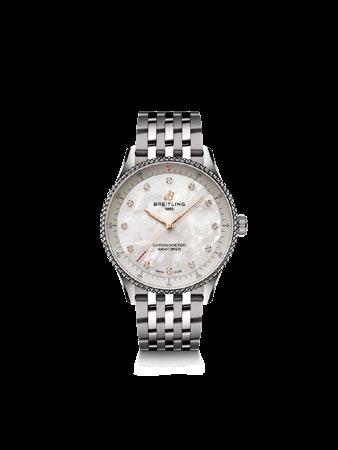

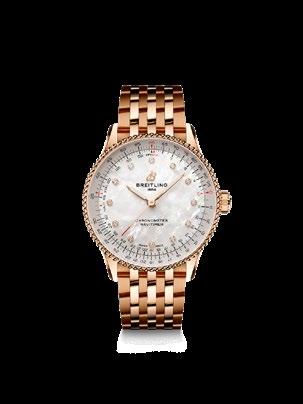
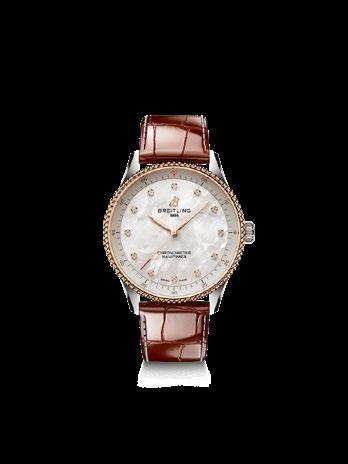
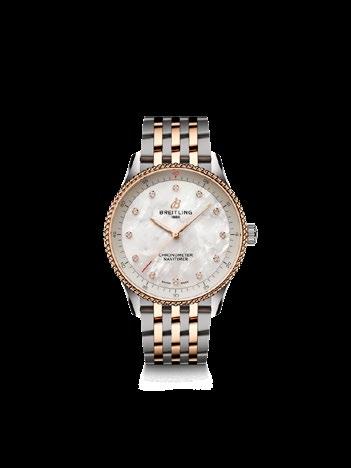





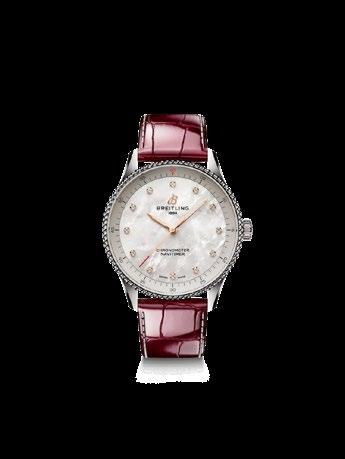
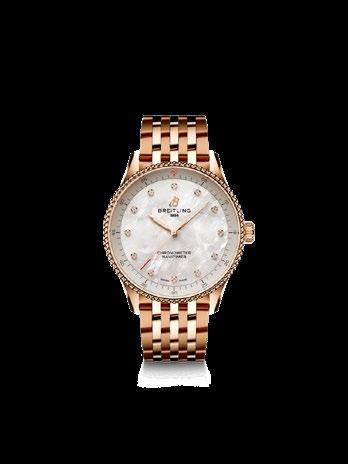


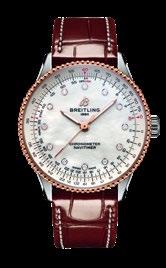
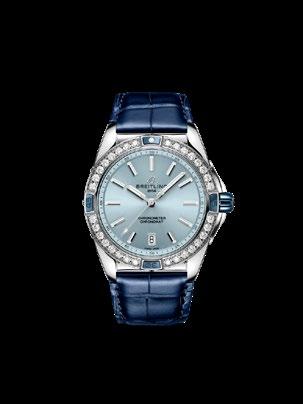



Moving beyond commodity-based to community-based value chains has been key to our efforts to transform our value chain and our means of engagement. By knowing the origins of our products, we can engage at the human and ecosystem-level in local communities and contribute to our shared resiliency. The efforts we have made in this space, originating in 2020, we now see as being a prescient means to begin to address material impacts upon our stakeholders, to meet consumer and other stakeholder group demands, and to be able to align to a number of key regulatory shifts. Most importantly we do so while acting based upon our shared values that we originally identified in our 2020 double materiality assessment.
We adhere to the following principles when engaging with local communities:
1. We will be aware of the impact of our presence and act responsibly.
2. We will act inclusively in seeking and identifying participants.
3. We will consider the full-scope impacts of our engagement and work at the intersection of social and environmental impact, with openness to engage with “unlikely allies.”
4. We will engage Breitling staff locally and globally with our approach.
Firstly, we engage with the communities in which our own operations are located. This includes at our headquarters in Switzerland and our local markets, where numerous community support mechanisms occur. At our own headquarters operations in the reporting cycle, we contributed to a local cultural project, with a graffiti art installation along Leon Breitling-Street in Grenchen, including an environmentally friendly gardening renovation along this central street. In continuation of our commitments established in prior reporting cycles, we continued to sponsor two flats for refugees of the war in Ukraine. We also support local sporting and engagement activities of our own employees and community members.
We also support organizations who enable the local sustainability system in Switzerland. This includes GreenBuzz Zurich, which advances progress for sustainability by providing a forum for regular, informed exchanges between businesses leaders, scientists, entrepreneurs and regulators. We are also a proud member of the Sustainable Switzerland Entrepreneurs Club, an open network for sustainable and futureoriented business in Switzerland. In the reporting cycle we also supported a Responsible Journalism initiative that has primarily supported in the reporting cycle an education initiative at the Neue Zürcher Zeitung, the local paper of Zurich, another education program in Luzern, and a journalism prize in Zurich.
Through our welfare foundation, 5.1 m CHF is available to be disbursed to employees in cases of hardship. In the current reporting cycle, one active recipient benefited directly from the fund. Additionally, the foundation has launched MOVIS Services, a specialized 24h consulting service for all employees to benefit from, providing advice on professional, personal, health, and financial challenges. The purpose of the foundation is to help employees and the surviving members of their families in respect to the financial impact in the context of age, invalidity, death, disease, accident, unemployment, and other forms of distress.
Our focus on community-based supply chains supports two key aspects of our neo-luxury approach, both sustainability and inclusivity. This is because some of the communities with which we engage are located in remote rural areas, sometimes even falling beyond the

remit of state services. Our transitions to communitybased supply chains are most advanced in our lab-grown diamond and artisanal and small-scale gold mining supply chains, which are reported upon in detail below.
In 2021, we committed to source Swiss Better Gold, a target that is well underway thanks to transformational efforts across our supply chain to support this ambitious and industry-leading goal. Together with our partners, we are continuing to develop resilient artisanal and smallscale gold mining (ASGM) supply chains while contributing to meaningful development for workers in the value chain and affected communities.
ASGM is a method of gold extraction based primarily on the use of manual labor. It can be conducted in a formalized manner, such as the integration of informal activities into the formal supply chain by setting and enforcing responsible sourcing standards that benefit the health and safety of workers. Through premium contributions distributed at a rate of $1 per gram of Step 2 gold sourced (note: from May 2024 onwards, $1.35) and a $0.50 voluntary contribution per gram of Step 1 gold sourced that is unique to the Breitling strategy to proactively develop resilient supply chains, we contribute to employees in the mines with resources including training for health and safety or investments in on-site infrastructure, along with the sustainable development of the local communities in which the mines are located.
In the reporting cycle, we supported the establishment of fish farms in the Colombian village of El Pescado in the municipality of Segovia, in the area surrounding the Touchstone mine from which Breitling sourced in previous reporting cycles, thereby contributing to the Better Gold Fund $ 1 per gram of gold sourced. The project was identified and suggested by the local community and co-created with the local authorities, Touchstone mine representatives and the Swiss Better Gold teams. The aim of the project was to provide an alternative income generating activity for the community with lower impacts on the environment compared to the agroforestry which is often carried out informally or even illegally in this area. This project enabled further community engagement to develop other relevant projects such as home gardens and ecological cookstoves.
This is an important public-private partnership with the local government of Segovia to foster the relationship between the government, the community and the private sector while demonstrating the viability of such collaborative initiatives. To date, six families in the village of El Pescado have constructed seven fishponds. These will generate alternative income streams and enhance food security and socio-economic development. Through this project, six families are now self-employed and generating an income, allowing them a certain economic independence that responds to their needs. At the same time, the project has fostered the integration and collaboration among community members.
This project was developed in addition to the educational project serving community members that has been running since 2022. In this remote area close to the Touchstone mine, the lack of educational facilities contributed to additional challenges facing the community, such as a high rate of informal or even illegal activities. Together with Swiss Better Gold and the Corporación Latina as the implementor, we developed a long-term educational project for which the first phase was successfully completed in 2022.
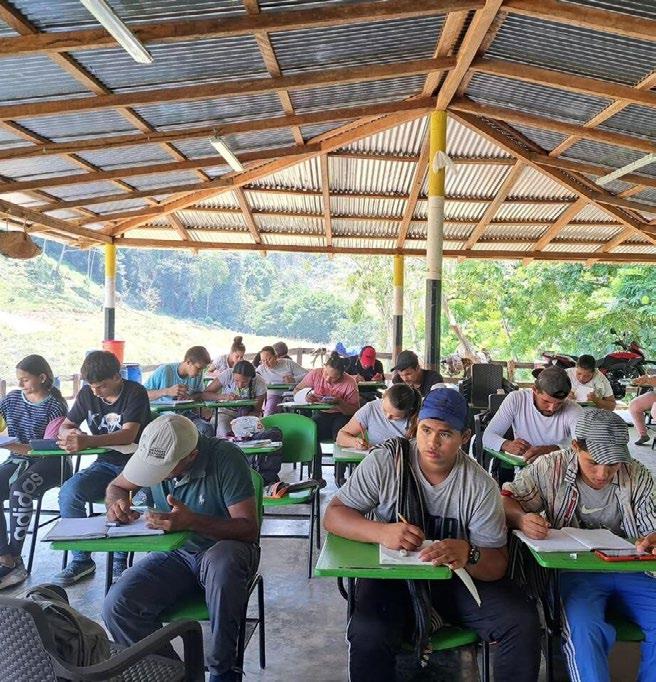

I am grateful to the teachers we have had, I have learned a lot from them. Our current teacher is very good to us, he explains things very well. Thanks to him we know the four basic operations of mathematics. He has also taught us values and I learned to love myself much more and to value others.
PROGRAM PARTICIPANT, 8 YEARS OF AGE
In 2023, the educational project had 30 students enrolled across a range of ages, with class sizes of seven students, far lower than the average in Colombia of 22. Among the various positive impacts of this educational project has been an increase in social cohesion among the community, the biggest beneficiary of the project. The community not only managed to complete the first phase with great success, but also carried out the academic process into the second phase. This underscores the importance community members give to education and the robustness of the program. Our educational program is now a flagship project in the region with the infrastructure of the school serving adults and children during their studies.
We are working to find long-term support for this project in the future in collaboration with the local government so as to ensure its continuity as a recognized space for public education. To this end, Swiss Better Gold has signed an agreement with the municipal authorities as they will assume ownership of the facility in the medium to long term.
Since the program began in the village, the quality of life of the inhabitants began to improve, especially that of my grandchildren who are in the new school. I see they are very happy and you can see that they have learned a lot thanks to the teachers who have been very dedicated.
PROGRAM PARTICIPANT, 62 YEARS OF AGE
This education project in the village has improved the quality of life of many people, especially mine and my family. My son is in the third grade and my wife and I are in continuing education. Previously we did not know how to write or read well. Thanks to this, we now know how to read and write. I am very grateful to the teachers we have had. They have been excellent professionals with an enormous human quality.
PROGRAM PARTICIPANT, 32 YEARS OF AGE

Since shifting to lab-grown diamonds in 2022, we have also been contributing to the local communities in western India from which we source through a voluntary contribution of CHF 30 per carat purchased. In consultations with a diverse group of local community stakeholders active in the impact space, it was determined that the greatest benefit could be derived through the creation of a tailored education program and of a space for which impact leaders can gather.
In January 2024, we were elated to welcome the inaugural class of social impact leaders to the Better Diamond Fund education program. This community-designed initiative is conducted in partnership with Amani Institute, a leading global non-profit organization supporting social impact leaders with high-quality leadership education. To date, 35 have enrolled in this program conducted in the state of Gujarat in western India, where all of our lab-grown diamonds are grown, cut and polished.
The program is sponsored by Breitling and conducted over five modules, culminating in a Social Impact Project Showcase highlighting a project developed by the participants that relates to their work in women´s economic empowerment, social entrepreneurship for economic development, childhood education, and environmental protection. The experience of participants is presented on the next pages by Palak Gadhiya, leader of the Research and Knowledge Management team at the Self-Employed Women’s Association, or SEWA Cooperative Federation.
In addition to the tailored training program, we have also created with the Amani Institute regular gatherings where local impact leaders are invited in response to a key need identified in stakeholder consultations. Both participants in the training program and community members take out the word beyond, community members covers it are invited to these gatherings, providing a platform to support collaboration among individuals working in similar and complementary spaces related to social and environmental impact.


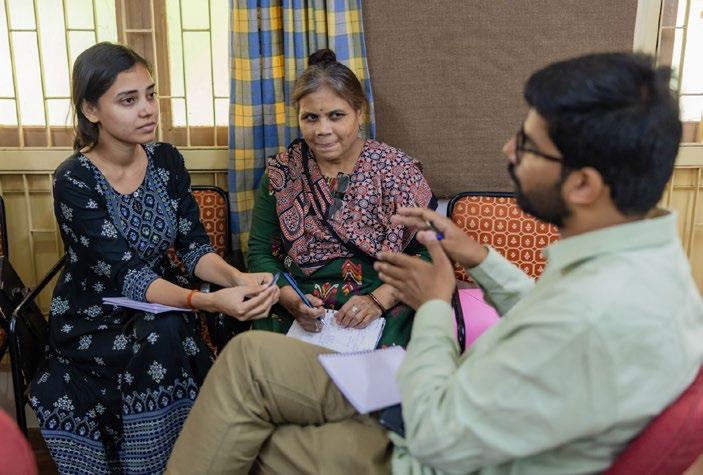
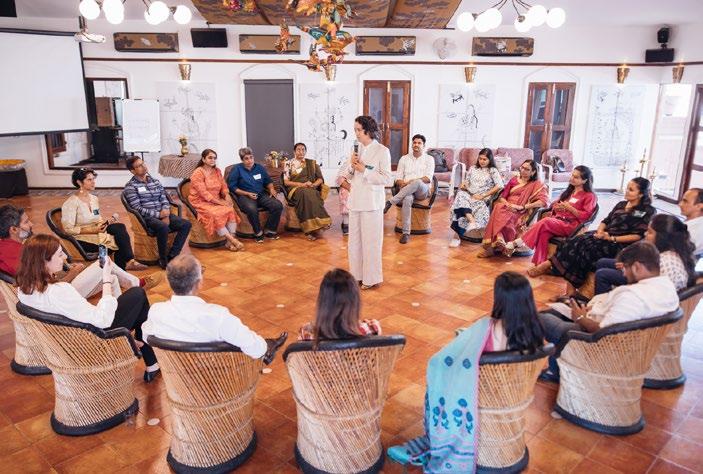
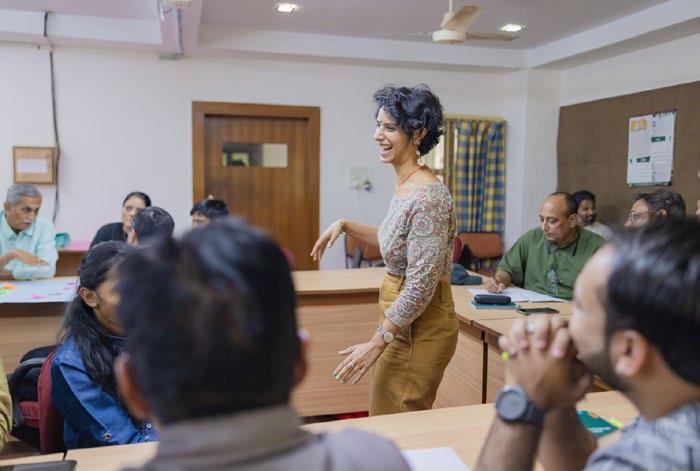

Participants of the Leadership for Growth program in Ahmedabad participating in training sessions which started in January 2024, and in a graduation ceremony for the first cohort of 15 social impact leaders that took place in June 2024
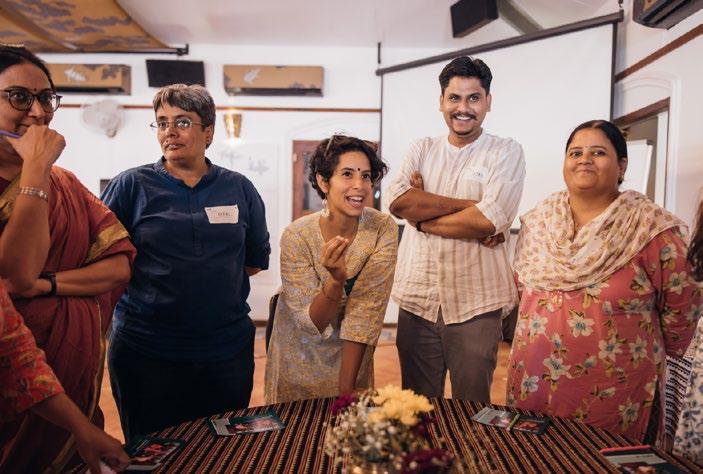
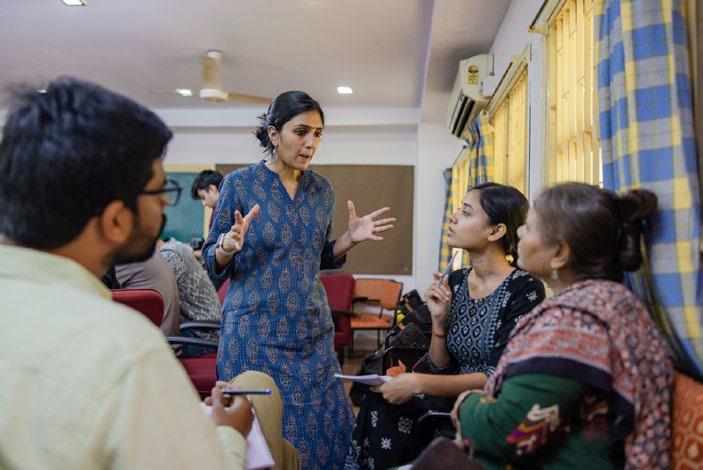


Amani Institute’s Leadership for Growth (L4G) program, funded by Breitling, has had a far-reaching impact on our organization.
Our Federation is a crucial support system for womenowned and women-led cooperatives and collective enterprises across six sectors – agriculture, dairy, handicrafts, services, finance, and vendor and trading. These enterprises are owned, managed, and run by women in the informal economy – those without regular work, income, or social security – and our programs provide them with opportunities for financial sustainability and self-reliance.
Over 32 years, we’ve promoted 112 women’s cooperatives, democratic businesses equally owned and controlled by members. These cooperatives are crucial for creating just, equitable societies and strengthening local economies. They provide flexible solutions to various economic and social issues, demonstrating resilience through shared burdens and benefits, and thereby impacting over 1.7 million women.
We empower women through collective entrepreneurship, offering capacity building, business development, marketing assistance, financial services, research, and communication support. We also build evidence for policy advocacy and stakeholder knowledge sharing. During the COVID-19 pandemic, we distributed 200,000 health and food kits, showcasing our commitment to members during crises.
Challenges persist, including access to finance, developing business mindsets, and market competition. Continuous learning is crucial to overcome these and adapt to changing market needs.
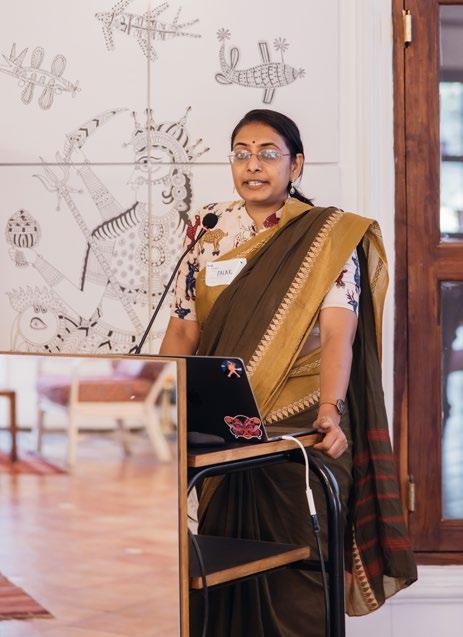
Palak Gadhiya leads the Research and Knowledge Management team at the Self Employed Women’s Association (SEWA) Cooperative Federation
Amani Institute’s Leadership for Growth (L4G) program, funded by Breitling, has had a far-reaching impact on our organization. It has broadened our understanding of leadership and organizational development, and inspired improvements in our internal processes. We’ve implemented new initiatives such as developing a Centralized Data System to better manage our information, and revamped our employee onboarding process to ensure new team members fully align with our mission and values. These improvements strengthen our ability to serve and support women in the informal economy more effectively.
Looking ahead, our vision is clear: we aim to ensure that female informal sector workers achieve full employment and self-reliance through cooperative and collective structures, while actively participating in the cooperative movement. This vision drives our efforts to expand our reach through digital and youth inclusion, address the impacts of climate change on our members’ livelihoods, and advocate for policy changes that support women’s collective enterprises.
Through our work at SEWA Cooperative Federation, we’re not just creating livelihoods. We’re fostering a movement of women’s economic empowerment and solidarity. Every day, we see the transformative power of collective action and the resilience of women who, despite facing numerous challenges, continue to strive for a better future for themselves and their communities.

We actively engage with communities globally, both within and beyond our supply chain. To complement our work with communities along our value chain, we also engage with a select number of organizations globally to support advancements for air, land and sea. Through these highly valued partnerships, we can further contribute to shared prosperity and expand our sphere of influence on areas related to social and environmental sustainability and be a part of broader systemic change. In the reporting cycle, we primarily contributed to the Solar Impulse Foundation, the Surfrider Foundation and SUGi. We have also been proud to make further contributions to a larger round of organizations working on social and environmental sustainability both in their local community and around the globe. In addition to this, we are proud to engage a number of ambassadors around the globe who use their platforms and voices to encourage action on a range of topics related to sustainability.
The Solar Impulse Foundation believes that climate change can be tackled most effectively through the lens of profitability. In 2021, the Foundation reached its ambitious goal of identifying solutions that are profitable for both the environment and our economy by reducing CO2 emissions, pollution, and the use of resources while at the same time creating jobs and growth. As the only evaluation available today that certifies the economic profitability of products and processes that protect the environment (such as Breitling’s own upcycled watch box), it now continues its mission by offering political and economic decisionmakers a Guide to Solutions that can be implemented on a large scale and assists them to establish a roadmap for the adoption of much more ambitious energy and environmental programs. Our support of the Solar Impulse Foundation is an extension of our own commitment to reduce our impact on the environment, which is detailed in the Planet chapter of this report.


On land, we have been proud to contribute to the work of SUGi, whose pocket forests address climate resilience, community, wellbeing and biodiversity in unison. In the reporting cycle, we supported the development of two outdoor classrooms or Miyawaki forests in Sao Paulo, Brazil. Throughout this partnership, we were able to plant a total of 1,800 trees of over 100 native species in two underserved regions of the metropolis and thereby provide an accessible connection to nature to local schoolchildren.
In the ongoing reporting cycle, we are proud to extend our collaboration with Giannis Antetokounmpo. Breitling is making a donation to the Charles Antetokounmpo Family Foundation (CAFF), a public nonprofit founded in June 2022, that was created to honor his late father’s legacy and fuel social impact by uniting individuals and communities to power opportunities globally.


The Surfrider Foundation is dedicated to the protection and enjoyment of the world’s oceans, waves, and beaches for all people. Like Breitling, the Surfrider Foundation is also celebrating its anniversary this year, and with it 40 years of advocating strong policies and winning precedent-setting legal victories in ocean and coastal protection. Through its focus on plastic reduction, ocean protection, beach access, coasts, climate, and clean water, it works to protect our coasts together with its powerful network. Since the beginning of the year, over 15,000 dedicated volunteers of the Surfrider Foundation have removed nearly 205,000 pounds of trash from beaches through chapter-led beach cleanups.
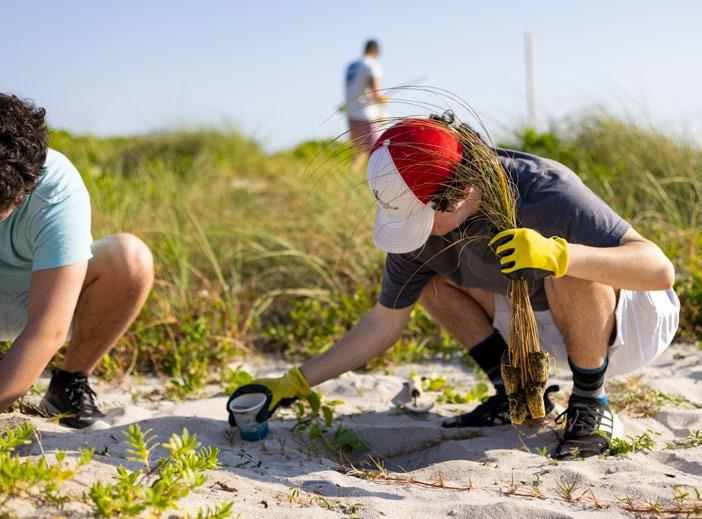

Surfrider has also launched its Climate Action Program in response to rising threats to our coastline to empower chapters to mitigate and adapt to climate change impacts through the implementation of naturebased solutions, such as dune plants, ocean-friendly landscapes, and mangrove restorations. Only since the beginning of the year, almost 5,000 mangrove and dune plants have been installed by the Surfrider Foundation along coastlines around the country, providing resiliency to shorelines. Surfrider also hosts the largest volunteer-led water quality monitoring program in the world with its volunteer-run Blue Water Task Force. So far this year, its volunteers have conducted over 9,500 water quality tests at 567 sites throughout the country,
with data from these tests providing critical public health information to coastal communities. The Surfrider Foundation is also committed to ending single-use plastics by 2035, a goal that echoes well with our own objectives at Breitling to eliminate plastic waste across our operations by 2025. Through our engagement with the Surfrider Foundation, we can amplify our intention to address plastic waste beyond our own operations. Through its Ocean Friendly Restaurants program, 571 restaurants have been keeping over 100,000 single-used plastics out of meals daily, reducing the amount of trash reaching the ocean and supporting change at a broader scale.
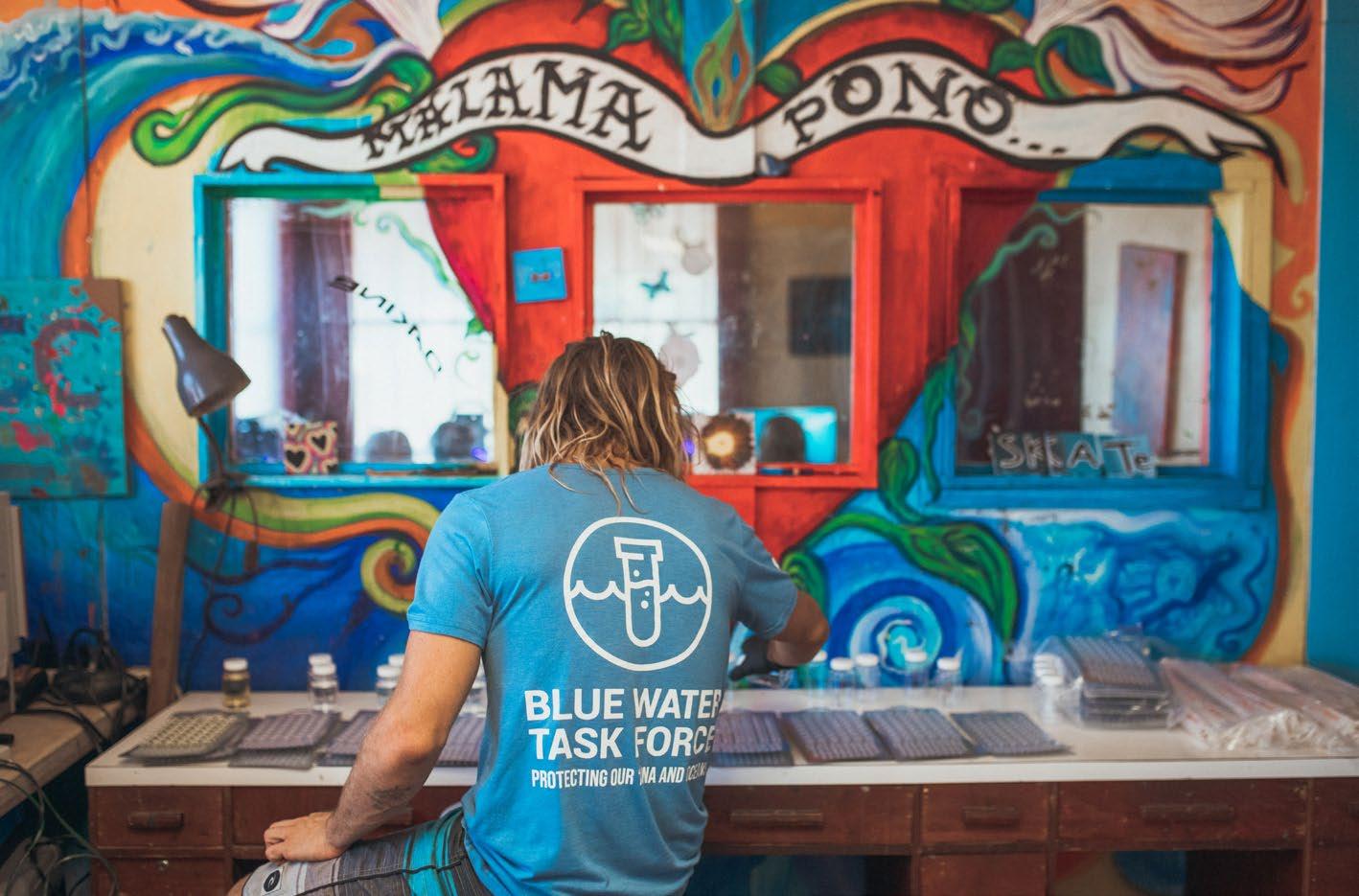

My story illustrates the profound impact that opportunity and community support can have on an individual’s life.
”
GIANNIS ANTETOKOUNMPO
PROFESSIONAL NBA PLAYER, BREITLING BRAND AMBASSADOR
Growing up in Sepolia, a modest neighborhood in Athens, Greece, I experienced firsthand the challenges of poverty and uncertainty. As a child of Nigerian immigrants, I witnessed my parents’ struggles to provide for our family. These early life experiences instilled in me a profound understanding of hardship, and the value of perseverance, community, and support.
Basketball became my escape and my hope for a better future. Through dedication and the unwavering support of my family, I was able to turn my passion into a career. In 2013, my dreams were realized when I was drafted into the NBA. My journey from the streets of Sepolia to becoming an NBA champion is a testament to the power of resilience and the importance of having opportunities.
Despite my great success on the court, I’ve never forgotten my roots or the struggles of those still facing similar challenges. My life story is a constant reminder of the importance of giving back and creating opportunities for others. This belief led me and my family to establish the Charles Antetokounmpo Family Foundation (CAFF), aimed at providing resources and support to underserved communities around the world.
At CAFF we believe in the power of sport to change lives and shape communities. And we also believe that when people’s basic needs are met, they’re more readily able to reach for their higher purpose and potential. We believe that every child deserves the

chance to pursue their dreams, regardless of where they live, the color of their skin, or how much money their family has. By providing scholarships, increasing access to sport experiences and educational programs, and fueling the work of nonprofit partners supporting families’ basic needs, we work to inspire and support the next generation to reach their full potential.
Sustainability and community support are at the core of our work at CAFF. We partner with local organizations to create programs that not only provide immediate assistance but also foster long-term growth and development. Our work in the US, Greece, and Nigeria emphasize the importance of community resilience, echoing my belief that true success is measured by the positive impact we have on others.
I was excited to partner with Breitling, because we share a vision and commitment to sustainability and community. Together, we share a vision of a better, brighter future where everyone has the opportunity to thrive.
My story illustrates the profound impact that opportunity and community support can have on an individual’s life. Through CAFF, my family and I are dedicated to giving back and creating lasting, positive change. I am honored to be part of Breitling’s sustainability efforts, as we work together to make a difference in the lives of many, just as others once did for me.



How does sustainability create value?
Liselotte Kuper :
At Partners Group, our motto “built differently to build differently,” is applied across a global portfolio exceeding $149 billion in assets under management and over 20 years’ experience in building businesses sustainably. When it comes to sustainability, we prioritize tailored strategies for each of our portfolio companies. Our sustainability initiatives take various forms: they can involve yearly investments in energy efficiency, resulting in substantial long-term cost savings, or a strong focus on retaining top talent by company boards, leading to reduced employee turnover and savings in recruitment costs. Our approach rejects a one-size-fits-all mindset, prioritizing tailored solutions for each business.
No matter the topic, our experience shows the key driver for sustainable value creation consistently resides in applying a bespoke approach. Company boards and management teams take ownership and design, measure, test, refine, and iterate initiatives that align with their unique business context, while considering factors such as market dynamics, customer needs, supply chains, regulatory environment, and growth plans.
Chloë Sanders:
At CVC, we are committed to maximizing returns through the creation of sustainable value for our stakeholders, across our global portfolio of $217 billion assets under management. Sustainability is a key part of how we consider material risks and opportunities for companies to create and preserve value, recognising key stakeholders such as employees, communities and the environment. By integrating material sustainability considerations in our investment approach, we are facilitating informed decision making and fostering forward-thinking, resilient businesses. We believe this ultimately contributes to the long-term success of the CVC funds’ and the companies they invest in. CVC’s value creation framework helps ensure a consistent approach to engagement, as well as helping companies to focus on what is material to them.

Why is it important to pioneer and become a leader in sustainability?
Chloë Sanders:
Demonstrating leadership on sustainability with our investment portfolio is important for several reasons. In particular, it enables us to pioneer innovative initiatives with portfolio companies. For instance, we’ve introduced EcoVadis (a sustainability ratings platform) to many portfolio companies, helping them to address sustainability issues that are material to them in line with best practice. supporting the decarbonization journeys of portfolio companies enhances the resilience of the portfolio to climate risks and reduces costs through energy efficiency and smart energy procurement. A focus on decarbonization can also help position companies to seize opportunities in the lowcarbon transition, especially amid growing demands for innovation, regulation, and transparency. CVC was among the first private equity firms to have its decarbonization targets validated by the Science-Based Targets initiative (SBTi), which includes an engagement target for our private equity portfolio.
Liselotte Kuper : We echo many of these efforts. Leadership in sustainability is deeply ingrained in our operating DNA. We were early adopters when in 2008, long before it became a widespread trend, we signed the UN Principles for Responsible Investment (PRI). Today, we run a comprehensive sustainability strategy across our operations and global investment portfolio. Our focus is on understanding long-term trends and sustainability factors that drive growth, as well as identifying winning
business models that can capitalize on this growth. We are continuing and expanding this focus as it underpins our investment success of the past decades.
Pioneering also involves leading through partnership, collaboration, and transparency. Our collaborations with Breitling and CVC exemplify this approach. By doing so and as showcased in the pages ahead, we create value for our stakeholders, contribute to a more sustainable world and address long-term business needs and global challenges, including climate change and social responsibility.
What reflections do Partners Group and CVC have on the progress being made by Breitling?
Liselotte Kuper :
Consistently generating value and sustainability relies on implementing a customized approach, driven by the company’s board and management team. Reflecting on 2024, we applaud Breitling for their remarkable progress toward short-term and long-term Science-Based Targets Initiative (SBTi)-validated goals. Their unwavering focus on supply chain management and strategic partnerships underscores their commitment to sustainable practices.
Chloë Sanders:
Now, more than ever, we see the consideration of material sustainability topics as a key factor in contributing to economic growth. At Breitling, we’re pleased to witness the same growing emphasis on material sustainability topics. We are excited to see a bright and sustainable future ahead for Breitling.

The circular business model plays a critical role in the future success of our business and an integral part of our sustainability journey. With the aim of designing out waste, applying circularity principles, and transitioning to a more circular business model, Breitling has structured its circularity approach into three key dimensions: materials and practices in the broader sense, recycled materials and eco-design, and resource recovery and lifetime extensions. Across these dimensions we apply a multitude of circularity strategies including but not limited to refuse, reduce, reuse, repair, recycle and recover.
Our efforts in guiding our conduct in this regard are reflected in our ESG Policy in the environmental policy and code of conduct where we provide guidance on the transition away from using virgin resources as well as on sustainable sourcing and use of renewable energy on our own premises and our boutiques. In general, recycled materials shall be considered and, whenever feasible, the approach towards circular construction should be considered when our premises are built or refurbished.
We have established dedicated recycling facilities for key materials such as plastic as part of our efforts related to material circularity. We are working with our stakeholders towards our target to generate zero plastic waste across operations by raising awareness, co-creating circular solutions, identifying plastic alternatives and shifting our patterns to remove plastic waste. More information on our efforts to generate zero plastic waste across our operations can be found in the Planet chapter.
While plastic waste reduction across operations remains a key topic for transitioning to a more circular business model, we will continue to expand our circularity efforts beyond our operations by analyzing material flows in areas which are considered material heavy such as, our boutiques, trade marketing, and IT infrastructure with the aim of continuing our path towards circularity.
The first step made towards material circularity through recycling was the introduction of straps made from recycled “ghost” ocean nets in 2019, followed by our watch box made from 100% upcycled plastic bottles in 2020. Additionally, through its foldable, lighter, and smaller
construct, along with an improved logistics for distribution, the result is significantly less GHG emissions when transportedd than our previous boxes. With the production of this watch box, we avoid the usage of virgin materials as 100% of our watch boxes are produced using recycled PET, amounting to a total weight of 83,140kg in FY24. For the luxury boxes, we recycled and reused 231.5kg of PET for the box‘s production.
Our watches are designed with consideration for circular concepts, including high quality materials to maximize durability later, elimate potential waste, with a view towards continuous improvement to increase product desirability, from the original owner or another in the long-term. We design for durability at the outset and make every effort to maintain our watches’ relevance and desirability to our customers, or multiple customers over a watch‘s lifetime.
Transitioning to more circularity together with our customers is a key part of our journey. In order to facilitate circularity, we design our watches for repairability, reuse, and resale. Key aspects of this include the extensive after-sales, or service aprèsvente (SAV) network and the Bucherer Certified PreOwned program.
Through our SAV network we enable our customers to receive high-quality repair of their watches. Repair centers are available to any customer globally and local repairs close to customers are prioritized to ensure a consistent and timely experience. After-sales product care plays a crucial role in the circularity of our watches. Through various services ranging from regular maintenance services recommended every two years to

polishing, we can substantially extend the lifetime of our products and contribute to their usability and durability.
In August 2023 we officially launched a program for the pre-owned market, making watches available for resale through the Bucherer Certified Pre-Owned program. Initially a pilot project, this initiative will be rolled out in other global markets with Bucherer, which has established itself as one of the leading players globally in the pre-owned watch market by offering a secure and seamless experience to its customer.
Through this program Breitling customers resell their watches, which are authenticated by experts, providing transparency throughout the entire ownership history. The watches purchased by Bucherer are subjected to an initial authenticity check by Bucherer’s own watchmakers. In a second step, the watches are sent to Breitling, which then performs an authentication, followed by maintenance (if the watch is genuine and its condition justifies it). All Breitling watches, available through Bucherer Certified Pre-Owned from the start of the official program on August 10, 2023 have been certified by Breitling. In addition to the authenticated, refurbished watch purchased from Bucherer, the customer receives a two-year international Breitling guarantee, an official Breitling storage box and a certificate of authenticity signed by Breitling CEO Georges Kern which guarantees the authenticity and functionality of the watch.
In the event of a warranty claim, the customer can now contact Bucherer boutiques worldwide as well as all official, national and international Breitling points of sale, an advantage that builds customer loyalty. The new
The Breitling Transocean 1957, reconditioned with a new old stock dial that has always been in possession of the company.
certification program for pre-owned Breitling watches ensures an absolutely secure purchase for the customer.
Transitioning to more circularity together with our customers is a key part of our journey. For this purpose, a focus is placed on post-consumer, or downstream circularity including the watch itself, straps, packaging as well as after-sales services.
Bucherer boosted customer confidence in the secondary market and was able to reach new target groups with creative concepts including: the authentication of the watches offered by watchmakers certified by the brands and the certified watch service in particular set standards in the pre-owned business, bringing a whole new level of reliability to customers. In addition, Bucherer transforms purchases into an experience for customers with a nationwide presence and luxurious boutiques. Those who prefer to shop conveniently online use the easy-to-navigate website that has a complete range of products on display.
To further support the desirability of our products in the long-term and our brand itself, we also invest in the heritage of our brand. Some of the ways we do this include continuously expanding our brand research and archives, expanding our collection of rare historic pieces, engaging with the collector community, developing global exhibitions and displays, including in the celebration of our 140-year anniversary and engaging with auction houses to share information and increase our presence. The restoration of historic watches also strongly contributes to the value perception of vintage pieces with careful attention to historical integrity.
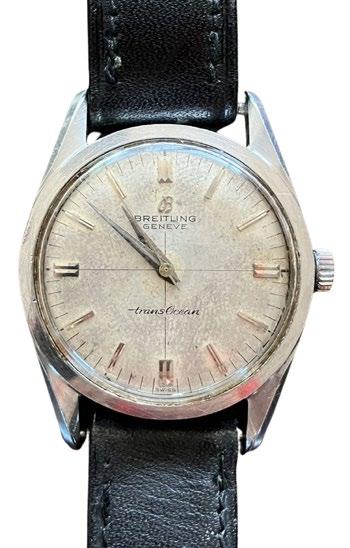


Breitling employees at a corporate volunteering day to support biodiversity in the Canton of


We respect natural resources across climate, water, and biodiversity to develop a regenerative approach to nature and take tangible action, including on reducing plastic. We align our efforts with key international frameworks including the Taskforce on Climate-related Financial Disclosures, the Taskforce on Nature-related Financial Disclosures and the Science Based Targets initiative, which has validated our greenhouse gas reduction targets which are aligned to the Corporate Net Zero Standard.

INDICATOR
Material topics addressed: E1 Climate change mitigation; E3 Water; E4 Direct impact drivers of biodiversity loss; S3 Community rights; E5 Resources inflows, including resource use; E1 Climate change adaptation
Achieve Carbon Disclosure Project (CDP) A list status in Climate by end FY28 and end FY30 for Water and Forests
Achieve 100% renewable energy for electricity globally by end FY26
Generate 0% mismanaged plastic waste across operations by end FY26
Transition to a fully electric fleet by end FY26
Reduce Scope 1 and 2 emissions by 80% by FY32 from an FY22 baseline (market-based)
Reduce Scope 3 emissions by 46.2% by FY32
Climate: B Water: NA Forests: NA
Climate: D (FY22) Water: FY25 Forests: FY25 Climate: on track Water and Forests: Baseline forthcoming
(FY22) On track: Increased uptake of renewable energy in key global markets through energy attribute certificates
– FY23)
On track: The target has been revised to specify mismanaged plastic waste to ensure that no waste is improperly handled. It applies to our global operations activities.
7, 8, 9, 12, 13, 14, 15
(FY22) On track: Emissions reduced by 21.6% in the reporting cycle due to the uptake of renewable energy in key markets facilitated by energy attribute certificates
On track: Emissions increased due to a change in the methodology and the emissions factor, but roadmaps are in place with supply chain partners and the Breitling carbon fund is supporting transformation
Establish Science Based Targets for Nature across the value chain by end FY26
SCIENCE BASED TARGETS INITIATIVE (SBTI): VALIDATED CORPORATE NET ZERO STANDARD TARETS ACROSS THE VALUE CHAIN FOR CLIMATE ACTION
TASKFORCE FOR CLIMATE-RELATED FINANCIAL DISCLOSURES (TCFD): ALIGNMENT COMPLETED
TASKFORCE ON NATURE-RELATED FINANCIAL DISCLOSURES (TNFD): EARLY ADOPTER AND FIRST REPORT ISSUED

We recognize the intrinsic link between our business and nature. The preservation of natural resources is essential for the resilient continuation of our business given the numerous ways the topics of the loss of biodiversity, water scarcity, resource depletion, and climate change materially impact our business.
One of the most obvious dependencies on nature of our business is the water needed in the production of some of our key raw materials such as gold or leather. At the same time, our nascent efforts to realize a regenerative approach to nature can enhance our core brand value of sustainability and demonstrate our commitment to high-quality craftsmanship that considers an inclusive approach across ecosystems as being a vital contributor to the quality and durability of our products.
Our approach to environmental governance is unified and holistic, addressing both climate and nature-related issues comprehensively, understanding that these are nexus topics occurring in interrelated and dependent systems. The governance framework established for climate-related topics, which has proven effective in guiding our sustainability efforts, is likewise applied to our nature-related initiatives. This alignment ensures consistency in our environmental accountability and decision-making processes across the organization.
Our ESG committee of the board of directors oversees both our climate and nature-related strategies. This integration of climate and nature strategy oversight enables us to align our responses to climate change with our commitment to biodiversity and ecosystem preservation and water conservation, a process which reflects our holistic view of Earth System Boundaries. By employing a unified governance approach, we ensure that our environmental objectives and actions are interdependent and mutually reinforcing, driving comprehensive action throughout our operations along our value chain, and our sphere of influence.
Part of this unified governance approach is also the consideration of human rights in how we approach our impacts upon nature, which ultimately impacts local communities and stakeholders across our value chain.
While our assessment of our human rights impact is fully detailed within the people chapter of this report, it is important to reference herein that the human rights issue areas that are particularly impacted by our approach to climate- and nature-related strategies are community impacts of raw material production, environmental impacts of raw material production and end of life and occupational health and safety (OHS). Full details of this assessment are available in the People chapter of this report. Oversight of all these areas is provided by the ESG committee of the board of directors.
Environmental impacts directly affect human rights, particularly for communities with a yet higher reliance on environmental services. For this reason, we are also committed to respecting and implementing the guidance contained within the UN Declaration on the Rights of Indigenous Peoples, ILO Convention 169, the Convention on Biological Diversity; and The UN General Assembly Resolution 76/300 on rights to a healthy environment.
We are now also extending our climate-related risks framework to include nature-related risks. Recognizing the interconnectedness of climate, water and biodiversity, we are enhancing our risk assessment processes to capture the full spectrum of environmental risks facing our operations and our supply chain. This expansion reflects our commitment to addressing the emerging challenges and opportunities associated with a regenerative approach to our engagement with nature, which is critical to our long-term business resilience and our impact on the environment.
Our risk management process involves the identification, assessment, and prioritization of risks, followed by the implementation of strategies to mitigate these risks.

Alongside our systemic approach to nature topics and key targets detailed on page 73-74-75 in this chapter, and in alignment with the TNFD guidance and tools and resources the initiative provides, we have started assessing nature-related risks and opportunities through the TNFD’s LEAP approach: Locate your interface with nature, Evaluate your dependencies and impacts, A ssess your risks and opportunities and Prepare to respond and report.
In FY24, we took the first step “Locate” by identifying and prioritizing potential nature-related issues and main business interfaces focusing on direct operations and most key raw material suppliers (gold, diamond, farmed alligator leather, watch components) mirroring the scope used for TCFD.
We collaborated with Baron Sustainability and employed several geospatial tools and resources to carry out the Locate phase effectively:
• The ENCORE (Exploring Natural Capital Opportunities, Risks, and Exposure) tool and SBTN (Science-Based Targets Network) materiality screening tool to conduct dependency and impact screening.
• The Ecoregions tool to understand our interface with ecosystems.
• The World Resources Institute (WRI) Aqueduct Risk Atlas to assess physical water risks and understand potential sensitivity of locations.
• IBAT (Integrated Biodiversity Assessment Tool) to assess the biodiversity importance which incorporates data from Protected Areas (a clearly defined geographical space, recognized, dedicated and managed, through legal or other effective means, to achieve the long-term conservation of nature with associated ecosystem services and cultural values) and Key Biodiversity Areas (sites contributing significantly to the global persistence of biodiversity) to understand our interface with ecologically sensitive locations.
• The WWF Biodiversity Risk Filter (BRF) and Water Risk Filter (WRF) to assess high ecosystem integrity, rapid decline in ecosystem integrity and Ecosystem service delivery importance to further understand potential sensitivity of locations. Key outcomes include an understanding of our moderate and high nature-related dependencies and impacts along the value chain, and a list/or map of ecologically sensitive locations.

Key outcomes include an understanding of our moderate and high nature-related dependencies and impacts along the value chain, and a list/or map of ecologically sensitive locations:
Moderate and high dependencies and impacts are found within the upstream segment of the value chain as highlighted in the above heatmaps. Dependencies are primarily connected to water resources, which are crucial for operations, particularly in our supply chain. The impacts extend to various pressures associated with gold mining and farmed alligator leather production. Within this detailed review, we can see the importance of pollution in these particular, limited aspects of our upstream value chain.
Following the LEAP guidance, we have analyzed all sites within our own operations (headquarters offices, manufacturing sites, subsidiaries, warehouses, internal boutiques) as well as the sites associated with moderate and high dependency and impact value chains beyond our own operations, namely gold mining and farmed alligator leather production. 79% of our own sites are considered as sensitive, while 40% of our artisanal gold and 100% of our farmed alligator leather production sites are sensitive.
These sensitive locations are defined by several key criteria. Only one criterion of the following needs to be met to constitute a sensitive location:
Very high materiality rating
High materiality rating
Medium materiality rating
Low materiality rating
Very low materiality rating
• Biodiversity importance refers to areas that are essential for the conservation of species, habitats, or ecosystems, including regions recognized for their global, national, or local significance.
• High ecosystem integrity denotes locations where ecosystems are largely undisturbed and function in a natural, healthy state, maintaining their ability to support diverse species and ecological processes.
• Rapid decline in ecosystem integrity highlights areas where the health and function of ecosystems are deteriorating quickly and at risk of ecological tipping points, often due to pressures like deforestation, pollution or climate change.
• High physical water risk encompasses areas facing significant risks related to water availability, flooding or water quality.
• Ecosystem service delivery importance indicates areas that are crucial for the provision of ecosystem services essential for the realization of human rights (water regulation soil fertility, pollination, etc.), and include areas traditionally owned, occupied, or used by Indigenous Peoples and Local Communities, as well as areas of biocultural importance.

To the best of our knowledge, the gold mines we operate in Peru are not located within Indigenous communities. However, we recognize that our understanding is limited by a lack of comprehensive data, not only in gold mining but across all areas of our operations. We are aware of our connection to Indigenous communities through our engagement with raw materials sourcing and, in certain areas, retail operations. We are committed to improving our data collection analysis and stakeholder engagement and consultation. This will help us to better understand our impact on Indigenous Peoples and local communities, our role in local systems and to duly integrate nature-
Criteria for sensitive locations identification
Biodiversity importance
High ecosystem integrity
Rapid decline in ecosystem integrity
High physical water risks
Ecosystem service delivery importance
and community-based approaches developed by these stakeholder groups.
In addition to the sensitive locations identified, two of our headquarters sites in Switzerland, seven of our subsidiaries (four in Asia, one in Europe, one in North America, one in Latin America), and one gold mining sites will be added to this list. While these locations are not classified as sensitive, they have been recognized as having significant potential dependencies, impacts, risks, and opportunities related to nature. This applies to the headquarters and subsidiaries for their financial relevance, and to the gold site because of its high

nature-related impact and dependency. This entire set of locations represents to date our priority locations, which will undergo further assessment in accordance with the subsequent steps of the LEAP approach and TNFD framework, preparing us for the recommended disclosure under TNFD Strategy D: “Disclose the locations of assets and/or activities in the organization’s direct operations and, where possible, upstream and downstream value chain(s) that meet the criteria for priority locations.“
These findings and list of priority locations will guide our subsequent steps in the LEAP approach in FY25. Currently, this is foreseen to include stakeholder consultations and development of a comprehensive nature-related risk assessment and scenario analysis to ensure a well informed and effective response to
nature-related risks and opportunities. Also moving forward, our assessment will expand to encompass additional supply chain materials, including bovine leather, paper-based packaging, and wooden furniture.
We are currently developing specific targets, which will be refined based on the findings from our finalized nature-related risk assessment and scenario analysis. Our commitment includes submitting science-based targets for nature (e.g. biodiversity and water targets) within the next two years.
The Donau-Auen National Park in Vienna and Lower Austria is biodiverse floodplain of the Danube. The team of Breitling Austria participated in and organized garbage collection campaign to clear the banks of the Danube and its backwaters of washed-up rubbish.


We are committed to addressing climate related topics across our operations and our supply chain, including through the implementation of the recommendations from the Taskforce on Climate-Rerated Financial Disclosures (TCFD), the benchmark framework for reporting on physical and transition climate risks. As a part of this, we have conducted an assessment focusing on identifying our climate-related risks and opportunities and quantifying the related financial impact. Related topics and a review of our approach may be referenced in our 2023 Sustainability Mission Report and is referenced in the summary table on page 78-79.
In this reporting cycle we have made significant progress in aligning with the TCFD recommendations by validating our science-based near-term and net-zero targets and enhancing our scenario analysis with a focus on 1.5°C (SSP1/RCP2.6) and 4°C(SSP5/RCP8.5) scenarios. We have selected these scenarios in order to understand the potential impacts of different climate futures on our business: one in which we are able to collectively address climate change and limit warming to a threshold indicated to avoid the worst effects of climate change, and another one, more severe, in which effects are not limited in order to appreciate the severe consequences which would be faced as a result of insufficient measures being taken.
For the first time we have financially quantified for 2030 and 2050, using 1.5°C and 4°C scenarios, our risk exposure and refined our adaptation plan accordingly. In the process, we conducted a detailed assessment of our operations (Including our headquarters in Switzerland and all our subsidiaries worldwide), key boutiques (internal and external boutiques representing 60% of FY23 revenue), and key supply chain sites (including Switzerland-based own operations and suppliers, artisanal and small-scale
gold mining in Peru, lab-grown diamonds in India and farmed alligator leather in the United States, representing 87% of FY23 direct procurement spend) for both physical risks (such as extreme weather events) and transition risks (such as increasing climate-related regulations), where we identify our highest climate risk exposure. Please see tables Physical risks analysis and Transition risks analysis for further details.
To manage climate-related risks, we are committed to working on our mitigation and adaptation plan within our sphere of influence, navigating towards our transition plan and achieving our Science Based Targets initiative (SBTi) targets which were validated in December 2023 (Carbon accounting and targets) and measures in the value chain to reduce our exposures to risks (Physical risks analysis and Transition risks analysis). To assess performance in managing climaterelated risks and opportunities, we will continue to closely follow progress made towards our targets and regularly refresh our assessment of our overall climate risk exposure.
To incentivize our transition plan, we have since 2022 placed a voluntary price on carbon on all measured emissions of 40 CHF per ton of carbon dioxide equivalent (tCO2e), following the minimum pricing guidance of the Carbon Pricing Leadership Coalition. This carbon pricing mechanism supports our investments in emission reduction initiatives and helps internalize the cost of carbon in our business operations. We have quantified scope 1 and 2 financial requirements at HQ level in order to reach our near-term science-based targets by FY32 and we will cascade this approach to our markets as well as to scope 3.

RISK NAME (risk/opportunity)
Type of risk
Value chain
Time horizon
Finacial exposure
Description of risk
Methodology
Actions for negative risk mitigation or positive risk realization
* Note:
Financial exposure is considered low as it is a small share of the revenues and based on climate risk events within a 100-year return period.
Increased direct and indirect costs (risk)
Acute and Chronic risk (flood, precipitation, heat waves, drought, extreme wind events) with a 100-year return period
Operational, direct suppliers, and key supplier sites (including Switzerland-based suppliers, artisanal and small-scale gold mining and processing sites, lab-grown diamonds, and farmed alligator leather) could be particularly affected by extreme weather, which could result in physical damages, reduced supply and/or higher prices
2030 and 2050
The financial exposure, projected on a yearly basis, is low* (risks are well-managed or insignificant). Less than 40MCHF for both 2030 and 2050
Physical damage on own assets (direct vulnerability), business interruption (indirect vulnerability)
EarthScan, a climate risk intelligence software from MITIGA, uses geospatial coordinates, climate models and provided indicators to identify and analyze two types of vulnerability translated into financial impact via asset value at risk and business days interruption:
- Direct vulnerability: Refers to the direct consequences resulting from extreme weather events. It is measured in terms of material losses, repair costs.
-Indirect vulnerability: Refers to extended consequences of climate change that impact activities (revenues from internal/external boutiques or procurement), or operational disruptions (supply cost).
We work to consider climate risk in the supplier risk assessments to reduce our vulnerability to risks including delivery delays due to extreme climate events
To address the issue, we work on the integration of climate risk adaptation measures within our facility and infrastructure strategy
We work with our supply chain partners to establish climate resiliency through dedicated projects including the review of production practices
We will implement a business continuity plan for high-risk locations
VULNERABILITY FINANCIAL SCALE

TRANSITION RISKS ANALYSIS
RISK NAME (RISK/OPPORTUNITY)
Carbon price mechanisms (opportunity)
Energy price volatility (opportunity)
DETAILED DESCRIPTION OF FINANCIAL IMPACT
The rising cost of carbon emissions in energy production and material manufacturing presents Breitling with the opportunity to invest in sustainable solutions, reducing long-term expenses.
* Note: The financial exposure is aligned with the double materiality assessment quantitative methodology. ** Note: As an hypothesis, FY23 financial performance is used for 2030 and 2050 quantitative analysis. *** Note: Risks and opportunities below 0.5MCHF have been quantified, and actions have been considered, though they are not listed here.
TIME HORIZON & THEORETICAL FINANCIAL EXPOSURE*
2030: < 5MCHF 2050: 10 - 25MCHF
QUALITATIVE FINANCIAL EXPOSURE
2030: Slight benefits
2050: Medium benefits
METHODOLOGY LEVEL OF CONFIDENCE
The carbon cost is calculated by multiplying the projected GHG emissions by the carbon price per location, scenario, and time horizon, considering sources such as NGFS (Network for Greening the Financial System), CORSIA (Carbon Offsetting and Reduction Scheme for International Aviation), and IMO (International Maritime Organization), and includes sectorial coverage and supplier pass-through. The savings come from comparing the costs of business as usual with the costs when Breitling meets its Science-Based Targets.
High level of confidence
ACTIONS FOR RISK MITIGATION / OPPORTUNITY REALIZATION
Based on our SBTi validation, we have our own emission reduction action plan in place.
Since 2022 We have placed a voluntary price on carbon of 40 CHF/ton of carbon dioxide equivalent (upgrading our initial price of 30 CHF/ ton established in 2020), following the minimum pricing guidance of the Carbon Pricing Leadership Coalition. This in turn supports investment in emission reduction projects within and beyond our value chain.
Increase in CAPEX at related to energy consumption reduction measures (risk)
Energy price volatility allows Breitling to diversify its energy sources by adopting renewable energies, thereby stabilizing long-term costs and enhancing resilience to market fluctuations.
2
2050: < 5MCHF
2050: Slight benefits
There is a risk of CAPEX increase associated with investments necessary for energy savings measures at HQ.
< 5MCHF Minimal threatened
Projected energy consumption multiplied by the projected energy price per location, type of energy, scenario Net Zero 2050. Sources: NGFS data. The savings come from comparing the costs of business as usual with the costs when Breitling meets its Science-Based Targets.
High level of confidence
Sum of initiatives to be financed at HQ in the coming 5 years related to energy consumption reduction measures.
Medium level of confidence
By implementing our plan to reduce scope 1 and 2 emissions plan working on energy efficiency, energy avoidance and clean energy transition.

RISK NAME (RISK/OPPORTUNITY)
Adapting product supply to evolving customer demand for low-carbon and animal-free products (opportunity)
DETAILED DESCRIPTION OF FINANCIAL IMPACT
Adapting product supply to meet evolving customer demand for low-carbon and animalfriendly products can drive revenue growth and market differentiation, leading to increased long-term profitability.
Increase in employer attractiveness for committed luxury brands (opportunity)
TIME HORIZON & THEORETICAL FINANCIAL EXPOSURE*
QUALITATIVE FINANCIAL EXPOSURE
5 - 10MCHF Minor benefits
Obligation to comply with EU Deforestation Regulation (risk)
Implementing sustainability measures can significantly enhance employer attractiveness, attracting top talent and increase productivity and reduced attrition cost.
> 50MCHF High benefits
METHODOLOGY LEVEL OF CONFIDENCE
Products containing animal materials considered to be exposed to a shift in consumer preference. Corresponding sales multiplied by % share of potential shift by consumer (hypothesized at 3%/year).
Low level of confidence
Attrition cost: Turnover estimated to be reduced to up to 50% thanks to robust ESG commitment and reputation of the brand. Attrition cost estimated to correspond to roughly 50% of average employee salary leaving the company. Increased productivity thanks to meaningful increase in employee well-being through the existence of the sustainability strategy estimated up to 10%.
Low level of confidence
ACTIONS FOR RISK MITIGATION / OPPORTUNITY REALIZATION
Work in progress to use alternative materials.
Better access to financing as a result of investor interest in Breitling’s sustainability ambitions and their link to value creation (opportunity)
The obligation to comply with the EU Deforestation Regulation may result in increased compliance costs and potential financial penalties.
Breitling’s proactive stance in addressing investor demand for sustainability initiatives enhances its ability to secure financing, supporting long-term financial growth.
5- 10MCHF Little threatened
Robust ESG strategy and brand reputation to reduce turnover. Sustainability efforts lead to increased employee well-being and productivity.
< 5MCHF Slight benefits
Non-compliance penalty fine estimated at up to 4% of total turnover in the EU.
Medium level of confidence
Decrease of interest rate (0.1%) linked to annual sustainability targets met, in addition to having more attractive financing conditions (interest margins) from investors.
High level of confidenceI
Work in progress to address these measures.
Breitling is aligning its efforts to key objectives of the financial community and has tied its performance in key areas related to climate to a sustainability-linked loan.

Disclose the organization’s governance around climate related risks and opportunities.
RECOMMENDATIONS (all have now been implemented)
Describe the board’s oversight of climate related risks and opportunities.
Describe management’s role in assessing and managing climate-related risks and opportunities.
REFERENCE IN BRETILING REPORTING AND ESRS REFERENCES
2023 Mission Report p. 32
CDP Question: C1.1a
2023 Mission Report p. 32
CDP Question: C1.2
Strategy
Disclose the actual and potential impacts of climate related risks and opportunities on the organization’s businesses, strategy, and financial planning where such information is material.
Risk management
Disclose how the organization identifies, assesses, and manages climate-related risks.
Describe the climate-related risks and opportunities the organization has identified over the short, medium, and long term.
Describe the impact of climate-related risks and opportunities on the organization’s businesses, strategy, and financial planning.
Describe the resilience of the organization’s strategy, taking into consideration different climate-related scenarios, including a 2°C or lower scenario.
Describe the organization’s processes for identifying and assessing climate-related risks.
Describe the organization’s processes for managing climate-related risks.
Metrics and targets
Disclose the metrics and targets used to assess and manage relevant climate related risks and opportunities where such information is material.
Describe how processes for identifying, assessing, and managing climate-related risks are integrated into the organization’s overall risk management.
Disclose the metrics used by the organization to assess climate-related risks and opportunities in line with its strategy and risk management process.
Disclose Scope 1, Scope 2, and, if appropriate, Scope 3 GHG emissions, and the related risks.
Describe the targets set by the organization to manage climate-related risks and opportunities and performance against targets.
2023 Mission Report p. 32–34
2024 Mission Report p. 79-80-81
CDP Question: C2.1 & C2.2
2023 Mission Report p. 34
2024 Mission Report p. 79-80-81
CDP Question: C3.1 & C3.2
2023 Mission Report p. 30–32
2024 Mission Report p. 79-80-81
CDP Question: C3.2a
2023 Mission Report p. 34
2024 Mission Report p. 78
CDP Question: C2.2 & C2.2a
2023 Mission Report p. 34
2024 Mission Report p. 78
CDP Question: C2.2b
2023 Mission Report p. 57–58
2024 Mission Report p. 78
CDP Question: C2.2c
2023 Mission Report p. 34 and 58
2024 Mission Report p. 78-79-80-81
CDP Question: C4.1
2023 Mission Report p. 32–33
2024 Mission Report p. 82-83
CDP Question: C6.1, C6.3 & C6.5
2023 Mission Report p. 24 and 37
2024 Mission Report p. 82-83
CDP Question: C4.2 & C4.2a

In December 2023, our greenhouse gas reduction targets (near-term and long-term) aligned to the Corporate Net Zero Standard were validated by the SBTi. Our plan outlines our mission to achieve net-zero greenhouse gas emissions across the value chain by FY50, using FY22 as our baseline year (Carbon accounting and targets). As in each reporting cycle, we transparently detail developments in our climate impact across all scopes and categories,
FY24 GREENHOUSE GAS FOOTPRINT ACROSS BREITLING’S VALUE CHAIN
Direct emissions in our own operations (Scope 1) Science Based Targets initiative (SBTi) Corporate Net-Zero
in our own operations (Scope 2)
Indirect emissions along the value chain (Scope 3)
&
noting key updates in each area. Restatements for prior years are reflected herein. Where relevant, original figures are archived in the report version in which they first appeared.
As in each year, we clearly outline our consumption of key materials driving our environmental impact, in a singular approach to transparency in our industry. We

continue to offer further transparency on our precious materials sourcing through our publicly available Sourcemap and to the purchasers of Origins Label watches in their enhanced traceability NFT.
To provide transparency in our sourcing practices, we have established our own reporting metrics focusing on the sourcing of gold, tungsten, tin, and tantalum (3TG) minerals, platinum group metals (PGM),
gemstones, and other key materials. While this subject is not a part of the European Sustainability Reporting Standards disclosures and represent a small share of Breitling materials, conflict minerals are an important topic with important implications for environmental and social impacts (further related details are also available in the people section of this report).
Decrease due to a reduction in the use of company vehicles Avoided demand and increased renewable energy and electrification
Switch to biogas for Headquarters. Increase due to greater number of boutiques
Energy Attribute Certificates purchased for USA, United-Kingdom and Japan subsidiaries
Increase due to greater number of boutiques
Restatement has been made for FY23 due to methodology update for sapphire consumption and increased consumption of platinum. Increase in FY24 due to an update in coefficients for gold mining, now based on primary data
Decrease due to an update in methodology now mostly based on primary data
The emission increase is linked to a higher number of travels and the integration of the emissions related to hotels, trains and cars business travels
The emission increase is linked to a higher number of employees
The emission increase is linked to the additional boutiques
Energy efficiency, avoided demand, and increased renewable energy share
458 (80% reduction)
Investing in supply chain insetting, especially for gold sourcing, prioritizing, and incentivizing sustainable forms of transportation, sourcing recycled and upcycled materials, energy efficiency and increased renewable energy at franchises
10’373 (46.2% reduction)
2’157 (90% reduction)

The ASM gold we have sourced in this reporting cycle has originated from a pool of mines accredited by the Swiss Better Gold Association. In the current reporting cycle, the pool consisted of segregated scrap generated from our prior use of gold from the Touchstone mine in Colombia and the MYSAC mine in Peru. For mass balance purchases of gold, we continue to provide a discretionary contribution of USD 0.50 per gram to mines meeting Step 1 criteria of the Swiss Better Gold Association (further details are available in the people chapter). These funds are reinvested to support social, environmental, and technical assistance activities approved by local stakeholders and by the Swiss Better Gold Association.
In the current reporting cycle, we worked with the following refiners for the production of gold and platinum group metals: Argor-Heraeus (accredited by the London Bullion Market Association [LBMA] as a Referee and Good Delivery Refiner and the London Platinum and Palladium Market as a Referee and Good Delivery Refiner, Swiss Better Gold Association cofounding member); Metalor (accredited by the LBMA as a Referee and Good Delivery Refiner, Swiss Better Gold Association cofounding member); PX Precinox (accredited by the LBMA as a Good Delivery Refiner, Swiss Better Gold Association member); and Varinor. Each refiner holds a Responsible Jewellery Council Chain of Custody and Code of Practices certification.
Our disclosure of these value chain partners is a key aspect of our transparency measures. At the same time, we actively engage with our gold-refining business partners to assess due diligence measures and develop mutual exchanges on how we can optimize our shared efforts related to responsible sourcing including on topics positively related to social and environmental impact and traceability.
Tungsten, which is used in our oscillating weights, has been sourced from three suppliers which apply key frameworks of the Responsible Minerals Initiative, such
as reporting according to the Conflict Minerals Reporting Template (CMRT) and applying key RMAP principles. We work with the three suppliers to ensure annual disclosures according to the CMRT and to assess due diligence conducted along the supply chain. Additionally, a trace amount of tantalum can be found in our quartz movements and a trace amount of rhodium is added in the production of some components. To our knowledge, no tin is contained in our products. Further platings of precious metals and metals used in the production process might not be accounted for in the volumes reported below.
Breitling suppliers of mined diamonds have confirmed that all of them have been procured in accordance with the Kimberley Process Certification Scheme and the World Diamond Council System of Warranties. Dialogue has started within our colored gemstone supply chain, present in a very limited range of our collection, with current and potential suppliers to identify means for traceability in line with our objectives established in the sourcing of other minerals and gemstones. All labgrown diamonds purchased have been produced by suppliers accredited under the SCS-007 Jewelry Sustainability Standard – Sustainability Rated Diamonds. Our current colored gemstones suppliers is a member of the Responsible Jewellery Council and is working to complete their Code of Practices certification in the ongoing reporting cycle.

MATERIAL (VOLUME)
Lab-grown diamonds (cts) 2’449.3
Mined diamonds (cts)
gemstones (cts)
FY24 NOTES
All suppliers of lab-grown diamonds are certified according to the SCS-007 Jewelry Sustainability Standard – Sustainability Rated Diamonds.
Use of mined diamonds occurs for replenishment of products developed and first produced prior to our transition in 2022. In line with our overall business planning, this transition remains on track with the timeline issued in our last report of March 2026.

To contribute to our Scope 2 emissions reduction, this year we purchased Energy Attribute Certificates (EACs) for our subsidiaries in the United States, the United Kingdom and Japan, reducing our market-based emissions by 499 tons. Thanks to our efforts, we have a clearer understanding of our carbon accounting, which now stands at 29’008 tCO2e (market based), reflecting a 34% increase from the 21,574 tCO2e recorded two years ago.
At the same time, we have also updated emission coefficients for gold mining following an assessment based on primary data, filling data gaps on materials used in watches, and the higher volume of platinum utilized. This enhanced understanding allows us to establish our emission reduction strategy more
precisely, aligning with our reduction targets for FY32 and FY50, while resulting in a near term increase due to the integration of this higher quality data.
We will continue to drive forward efforts to reduce our climate impact in line with this alongside maintaining a voluntary price on carbon. The Breitling Carbon Fund is based on a price placed on each ton of carbon equivalent emissions calculated during each reporting cycle. Currently, this price is set at 40 CHF per ton of CO₂ equivalent (tCO₂e), following the minimum pricing guidance of the Carbon Pricing Leadership Coalition. The Breitling Carbon Fund finances high-quality climate protection projects that reduce, avoid, or capture carbon emissions, including along our value chain. All these efforts align with our strategy and remain on track. INDICATOR
Carbon fund disbursed for internal carbon management activities related to emissions management and reduction

Solar panels installed on-site at a supplier of lab-grown diamonds in Gujarat, western Inda, with a financial contribution by the Breitling Carbon Fund

Following a recent double materiality assessment, ESRS E2, which focuses on pollution impacts including air, water, and soil contamination, has been determined as nonmaterial for our organization. Nonetheless, our dedication to pollution management remains robust, notably through our active participation as early adopters of the Taskforce on Nature-related Financial Disclosures (TNFD). This underscores our commitment to evaluating and addressing pollution concerns along our supply chain.
With our ongoing voluntary engagement in the TNFD process, we are intensifying our focus on water stewardship. Efforts include consideration to minimize water usage, to adopt water-efficient technologies, and to implement water recycling systems. In this reporting cycle of FY24, we have measured the water withdrawal volume for our headquarters, representing 8.6 ML. In our next reporting cycle, we will mark a significant milestone as we embark on our inaugural water footprint assessment using the globally recognized Water Footprint Network (WFN) methodology. This approach comprehensively evaluates the footprint across three key categories of water: Green (precipitation on land that does not run off or recharge the groundwater but is stored in the soil or temporarily stays on top of the soil or vegetation), blue (consumption of fresh surface or groundwater), and grey (volume of freshwater that is required to assimilate the load of pollutants based on natural background concentrations and existing ambient water quality standards) throughout our supply chain, complemented by our inaugural water questionnaire disclosure to the Carbon Disclosure Project aimed at strengthening our water management strategy.
We are also working to promote water stewardship across our supply chain. Collaborative efforts with suppliers are integral to our strategy. Our forthcoming plans include preparing to implement our gold value chain water conservation project, where the topic is particularly important.
Our commitment extends to engaging in water-related community investment initiatives that positively impact local communities. This includes investments in community water projects along our historical gold value chain in Colombia and partnerships with organizations (such as the Surfrider Foundation) that is further detailed in the prosperity chapter of the report.
Safe and just Earth System Boundaries is a framework for understanding the Earth system, particularly its stability and resilience and linkages with human well-being. It is comprehensive in scope, representing the major components of the Earth system including the atmosphere, hydrosphere, geosphere, biosphere and cryosphere along with the interlinked carbon, water and nutrient cycles, The presentation of impacts on people expressed in the framework is a key distinguishing feature. By referencing three justice criteria – interspecies justice, intergenerational justice, and intragenerational justice among countries, communities and individuals – it reflects the multidimensionality required to assess and act upon the conditions we collectively encounter on earth.
Presently, six of the eight ESBs are considered to have been breached, with only aerosols and climate excluded. For both cases, the just boundaries are stricter than the safe boundaries, referring to the circumstance that more harm would be experienced by people before the earth system itself experiences destabilization. None, however, are functioning within a safe and just corridor or within an access foundation, which means enabling access to resources for all.

It is important to raise awareness about ESBs and to understand that we can take action to find together new ways to live and thrive within these boundaries. In so doing, it is important to consider this from a systems perspective, understanding how different parts of our environment are interconnected and that our actions in turn have diverse impacts.
It is imperative that we take action to live within the ESBs. This requires collaborative efforts to innovate and implement sustainable practices that protect and restore the Earth’s systems. By doing so, we can ensure a just and equitable future for all species and generations. An important ongoing aspect of this work is our assessment of animal rights in view of our limited consumption of animal-based materials in our products and points of sale. We have already begun to reduce our use of leather, most notably in our watch packaging, and will continue to assess means to do so which
maintain product durability and consider full-scope environmental impact assessments, keeping in mind the potential harms of materials used in some leather alternatives, such as polyurethane. In support of this, we have amended our ESG Policy guidance on this topic with the support of Collective Fashion Justice, and are also in the process of amending our Supplier Code of Conduct in the ongoing reporting cycle.
In the future, we will continue to reference the Earth System Boundaries (ESB) framework, which integrates environmental stability with human well-being through justice criteria and consider how it may be used in our reporting processes.
PHOSPHORUS NITROGEN
AEROSOLS (subglobal)
FUNCTIONAL INTERGITY

Healthy ecosystems are crucial for our economic prosperity, and the fight against climate change. In view of this, and our own values, we are working to develop our approach to regeneration in ecosystems across our sphere of influence. To tackle the interconnected challenges of biodiversity loss and climate change, we have set science-based decarbonization targets across our value chain (see climate chapter). We are now at work to replicate this approach to address the full scope of our nature impact.
Our goal is to establish clear targets with specific, transparent, and recognized metrics by the end of FY26, or March 2026. We are working on implementing
standardized methodologies for assessing corporate impacts on water and biodiversity and as early adopters of the TNFD we are working on assessing and managing the associated risks. We will continue to raise awareness through the TNFD process, submit our inaugural CDP forestry and water reports, identify value chain investigation activities, and plan for biodiversity mapping. We also aim to set sciencebased targets for nature to mitigate biodiversity impacts in our supply chain, particularly in gold and diamond mining areas, around our HQ operations, and in our urban retail locations. We will issue annual biodiversity reports aligned with TNFD and the Carbon Disclosure Project and develop these efforts with the following objectives.
Include the voice of silent stakeholders
Calculate our impact
Collaborate with key partners
We include representatives of silent stakeholders, such as species or soil, to speak on their behalf. This involves referencing relevant data, including their input in our materiality assessment and other key strategic processes, to ensure their needs and perspectives are incorporated into our decision-making.
We create accounting frameworks to assess and report on our environmental impact. These frameworks are used to provide comprehensive reports to relevant bodies, ensuring transparency and accountability in our sustainability efforts.
We collaborate with partners along our value chain to achieve impact. Our focus will be on acting in line with the key targets of the Global Biodiversity Framework to enhance our collective impact on biodiversity.
Regenerate biodiversity along our value chain
Next page:
We will concentrate on regeneration efforts, particularly in gold and diamond mining areas, around our HQ operations, and in our urban points of retail. These initiatives are aimed at nature regeneration and the promotion of sustainable practices across our sphere of influence.
A wildlife crossing at he Touchstone mine in Colombia, from which Breitling sourced from 2021 to 2023, at which point its operations closed. The Better Gold Fund continues to support education activities, including environmental sensitization, in the local community.


In keeping with its pioneering spirit and matching our own, Breitling closed a 12-year portfolio agreement and became the first luxury watchmaker to remove CO2 with us.
ADRIAN SIEGRIST CLIMEWORKS’ CHIEF COMMERCIAL OFFICER
The world needs carbon removal to reach net zero. In 2023, the average global temperature approached 1.5° Celsius above pre-industrial levels, which is not just the symbolic number of the Paris Agreement but a real climate planetary boundary. To avoid further breaching the 1.5° limit, drastically reducing CO2 emissions is no longer enough. Climate scientists and policymakers agree that CO2 also needs to be actively removed from the atmosphere, which is why Breitling and Climeworks joined forces in 2024.
Climeworks has been pioneering direct air capture, one of several methods to remove CO2 directly from the air, for fifteen years. What had long been deemed science fiction became a reality in 2021, when we launched Orca, the world’s first direct air capture and storage plant. Three years later, we switched on Mammoth, which is currently the largest plant of its kind worldwide.
We have transformed an idea born in Switzerland into real-life machines in Iceland that remove thousands of tons of CO2. All carbon removal services that we deliver from Orca are independently certified by puro.earth, fostering trust in the ambitious scale-up journey that lies ahead. Our next-generation technology, which will boost our leap toward megaton capacity, will be

In his previous role as VP of CDR Solutions, he initiated and launched Climeworks Solutions
deployed from 2026 onwards in one of the largest Direct Air Capture Hubs supported by the U.S. Department of Energy.
Climeworks’ direct air capture technology is one of the highest-quality carbon removal solutions, but it is not a silver bullet. We need to foster a portfolio of naturebased and engineered carbon removal approaches to build a flourishing industry that removes gigatons of CO2 from the air. While we have always been outspoken about this fact, we once again turned ideas into reality when we launched our portfolio offering, Climeworks Solutions. It is our answer to making high-quality carbon removal more easily accessible for those who want to take the first steps in this rapidly evolving market.
Climeworks Solutions marks a milestone in our company’s history that we were proud to begin with Breitling. In keeping with its pioneering spirit and matching our own, Breitling closed a 12-year portfolio agreement and became the first luxury watchmaker to remove CO2 with us. Its climate strategy thus exemplifies the approach needed for reaching true net zero, namely combining emissions reduction with carbon removal.
The long-term commitment is a testament to Breitling’s mission to push boundaries, keep exploring, and deliver

on sustainability commitments for the benefit of the climate and communities. Together, we can hopefully inspire many others to turn their bold ambitions for a sustainable future into tangible action. The long-term commitment is a testament to Breitling’s mission to
push boundaries, keep exploring, and deliver on sustainability commitments for the benefit of the climate and communities. Together, we can hopefully inspire many others to turn their bold ambitions for a sustainable future into tangible action.
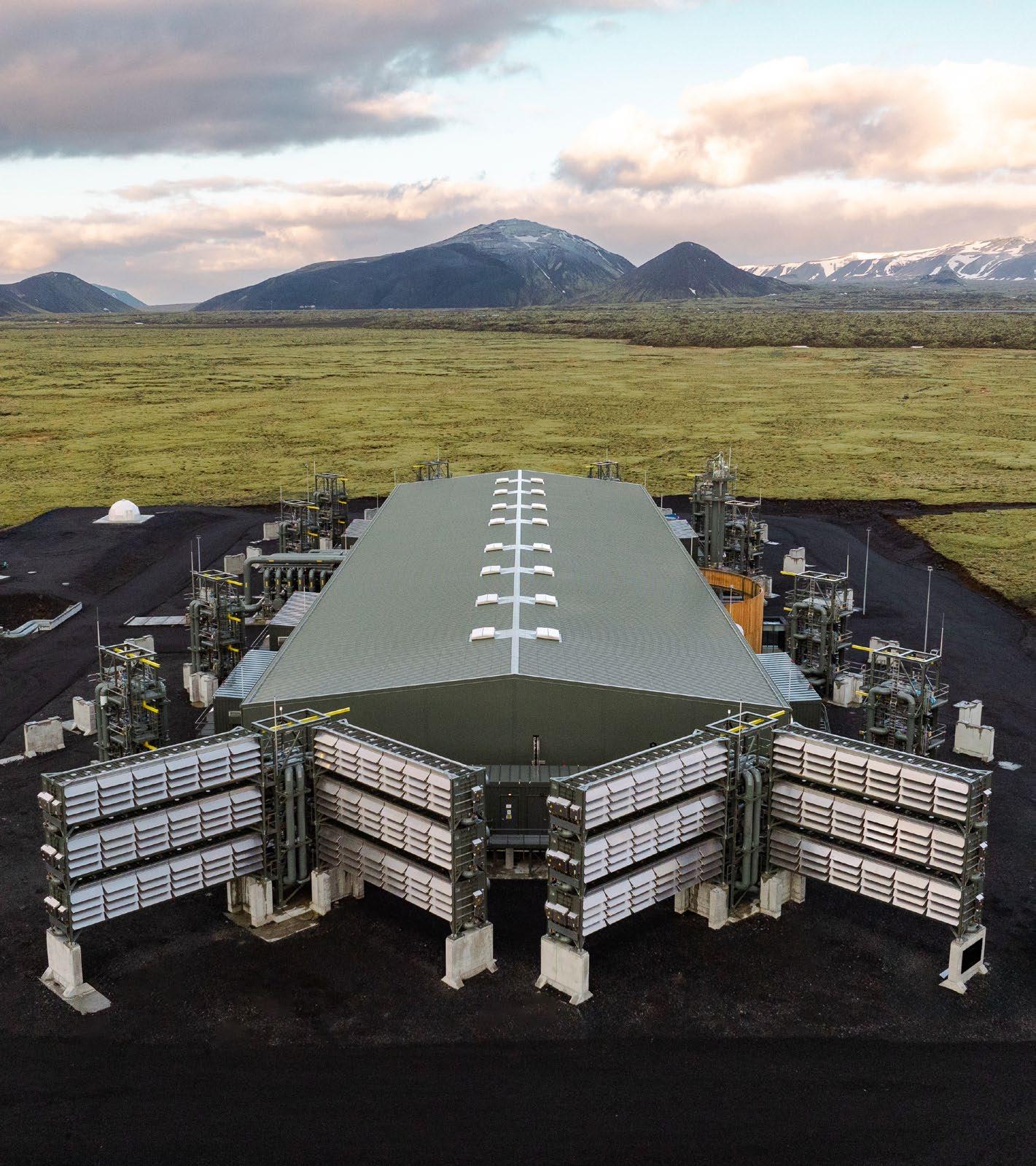

In this reporting cycle, we have made good progress towards reducing plastic waste across our operations (which includes our production, global after sales service, facility and logistics for watches distributed from our headquarters). This was achieved through removing and recycling plastic in addition to properly managing the waste that remains. Of total waste generated the plastic in this reporting cycle, the following treatment methods have applied:
• 50% was properly managed: plastic materials effectively collected, sorted, and processed through appropriate disposal methods, minimizing environmental impact.
• Sanitary landfill: A controlled disposal site for waste where trash is compacted, covered with soil daily, and designed to minimize environmental contamination and health risks.
• Incineration for energy recovery: The controlled combustion to generate heat and convert it into energy, reducing the volume of waste and producing usable heat or electricity.
• 39% was recycled: Plastic material processed after initial use to be reused in new products within the watch industry or elsewhere.
• 7% was removed: Through collaboration with the quality, production, logistics, and after sales departments, we identified and eliminated unnecessary plastic materials, while maintaining the quality of our processes and our products.
• 3% remaining considered mismanaged waste: Plastic materials that are improperly handled, disposed of, or left untreated, leading to environmental pollution, health hazards, and negative impacts on ecosystems. This can occur primarily in the two manners following.
• Leakage to soil and freshwater: The unintended release of plastic waste, into the ground and freshwater systems, posing risks to soil quality, water sources, and aquatic ecosystems.
• Leakage to oceans: The unintended release of plastic waste, into oceanic environments, contributing to marine pollution, ecosystem harm, and broader environmental challenges.
Among the most impactful changes to our processes were the installation of plastic waste sorting bins in each production and after-sales service workshop in Switzerland. The sorting is carried out by workshop personnel, and the waste is then collected by a Swiss company that specializes in giving these materials a second life, notably by reprocessing them into raw materials for watch components packaging , thereby facilitating a circular flow. Additionally, a workshop was organized with the support of Let‘s Talk Waste, attended by operational managers (51 participants). The goal was to raise awareness on plastic waste and collaborate on our activities and explore how to reduce our plastic waste generation.
The plastic footprint calculation of each plastic waste management was conducted with Earth Action, a specialized company which has created the foundational framework for plastic footprint assessments. Earth Action is recognized globally as a leader in plastic accounting, reduction development and footprint calculation.
To reach our target we will continue identifying further recycling opportunities where removal is not yet possible due to quality constraints. We are committed to increasing the share of plastic waste removed from our operations while maintaining efficient and processes across the supply chain. Additionally, we aim high quality to engage global markets driving efforts to remove and recycle waste on a broader scale. In parallel, we are dedicated to actively engaging our employees, with a focus on reducing waste from food and beverage consumption.

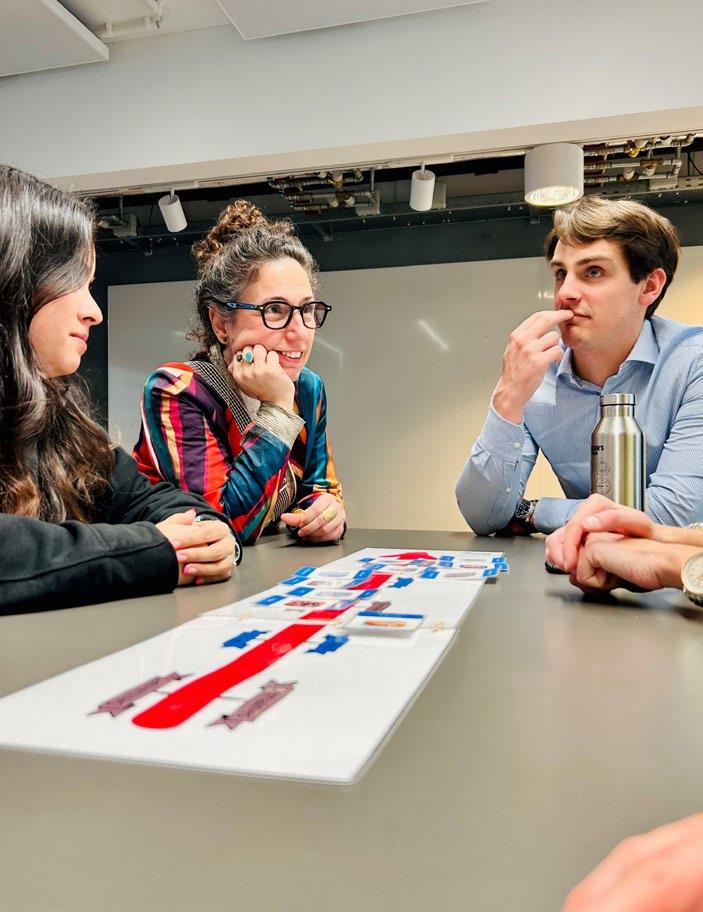
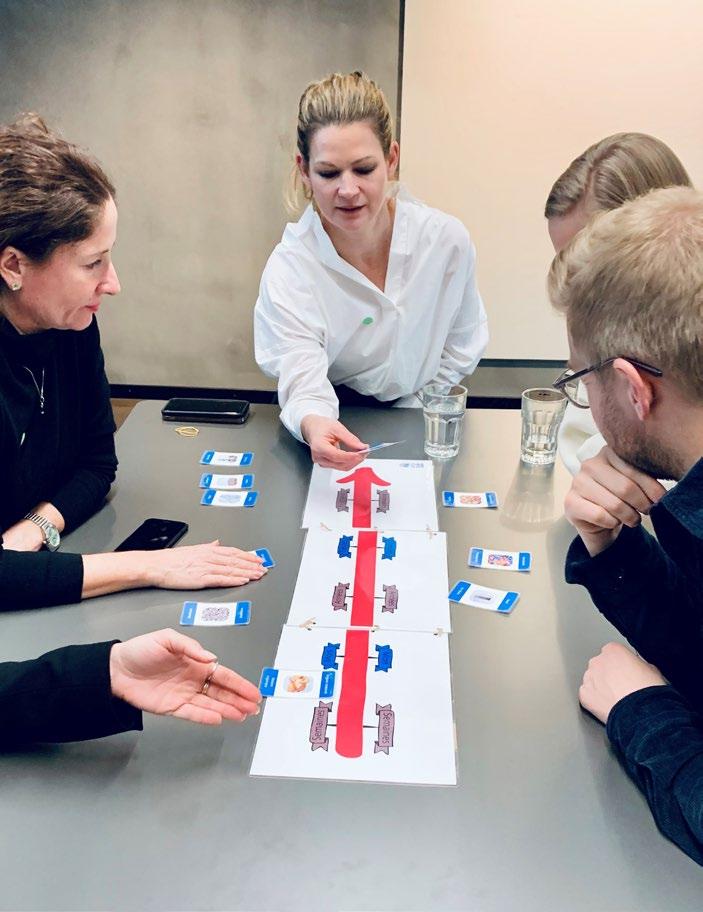


Sarah Perreard and Julien Boucher, Co-founders and Co-CEOs of Earth Action
Not a week goes by without a new scientific report raising attention of the threats plastic pollution poses to human health and ecosystems. While the impact of plastic debris on marine ecosystems is welldocumented, we are just beginning to understand the consequences of microplastics in the air we breathe, the water we drink, and the food we eat. These microplastics are linked to health issues such as fertility problems, obesity, and cancers. The additives in plastics, which can mix and create unknown reactions during recycling, pose further health risks.
At Earth Action, we build science, solutions, and spaces for sustainable transformation and lasting impact. Our recent Plastic Overshoot Day report calls attention to the fact that almost a third of global plastic production will be mismanaged in 2024. This will directly impact nature, where nearly 70 million tons of plastic will end up as a result of this plastic mismanagement, with negative consequences for ecosystems, species diversity, water integrity, and ultimately humanity.

The urgency to reduce plastic usage and invest in effective plastic waste management could not be clearer. In response to these threats, civil society has initiated a mandate for the UN to negotiate a legally binding instrument on plastic pollution, known as the Plastic Treaty. Although the treaty’s exact ambitions are still uncertain, its translation into national and local regulations will significantly impact companies. In Europe, the Corporate Sustainability Reporting Directive (CSRD), mandatory in 2025, pressures companies to assess environmental and financial risks associated with plastic leakage. As the plastic debate evolves, companies face numerous questions on how to prepare and pivot to avoid risks.
For its part, EA Earth Action identified a gap in assessing the plastic footprint of products, companies, and countries. This led to the development of the Plastic Leak Project, which evolved into the Plastic Footprint Network, the launch of the Plasteax waste management data platform, and the ongoing development of the Corporate Accountability Framework for Target Setting and Mitigation.

These solutions are now available for companies to adopt. Companies must first understand their plastic footprint by quantifying the plastic entering the environment across their value chain. Next, they must evaluate the effectiveness of mitigation actions both within and outside their value chains and assess investments that contribute to achieving zero pollution by 2040.
As these new impact assessment tools are developed, Earth Action is proud to collaborate with pioneering companies like Breitling. By piloting and implementing these solutions, Breitling exemplifies how the corporate world can be a force for good in reshaping our approach to plastic and driving towards a future without plastic pollution.
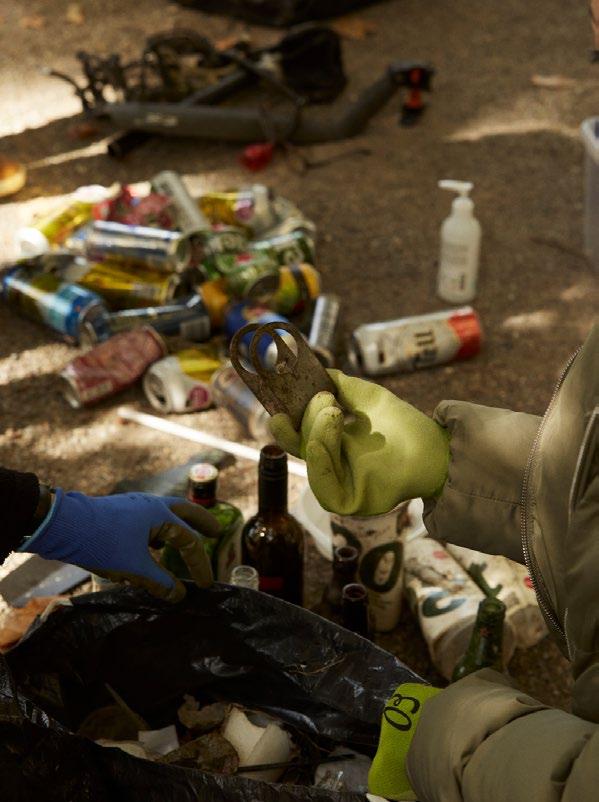
” “
By piloting and implementing these solutions, Breitling exemplifies how the corporate world can be a force for good in reshaping our approach to plastic and driving towards a future without plastic pollution.

These activities are complemented by a range of activities led by our stakeholders, including our employees globally which will be fully featured in our next reporting cycle - stay tuned!
Carbon offsetting project –Direct Air Capture (FY24):
Direct Air Capture - Climeworks
We are investing in projects that offset carbon emissions through direct air capture and storage technology. Partnering with Climeworks, a leader in this field, we support innovative solutions that capture CO2 directly from the air and safely store it underground.
Grant agreement between Breitling and Swiss Better Gold (FY23):
Climate action - Colombia
In partnership with the Touchstone mine, we repaired electrical grid lines to reduce emissions from electricity production.
– Cordillera Azul
National Park REDD+ Project (FY23):
Forest conservation – Peru
The project avoids emissions by supporting all efforts to avoid deforestation and forest degradation in Cordillera Azul National Park.
Carbon insetting project – Climate, biodiversity, and water nexus projects (FY24):
Climate, biodiversity, and water action – Peru
In cooperation with the Swiss Better Gold Association and our gold suppliers, we are developing projects that address the climate, biodiversity, and water nexus in the gold supply chain.
Carbon insetting project –Sustainable aviation fuel (FY23 & FY24):
Sustainable aviation fuelSwiss International Airlines
In cooperation with SWISS, International Airlines, we purchase Sustainable Aviation Fuel to cover the fuel use estimated for our business travel.
Carbon insetting project –Electric charging station (FY24):
EV charging - Switzerland
We have installed electric vehicle charging stations at our headquarters. These charging stations provide convenient access to clean energy for employees and visitors, encouraging the use of electric vehicles.
– The Blue Carbon Project Gulf of
Forest conservation – Colombia
The Blue Carbon Project Gulf of Morrosquillo is the first REDD project in Colombia to be developed with mangroves. GHG are avoided through activities that allow the identification, prioritization, and execution of actions for the adequate management of mangroves, the strengthening of local governance, and the promotion of alternative productive activities, while contributing to the protection of high values of community conservation and biodiversity.

SOUTHPOLE – Safe Community Water Supply (FY23):
Water supply – Uganda
This project aims to break the cycle of poverty, reduce pressure on Ugandan forests, improve the health of the local population, and cut greenhouse gases by distributing clean water filters to families across the country.
MYCLIMATE – Biogas for Rural Households in India (FY23):
Cookstoves – India
Installation of household biodigesters that represent clean and sustainable energy sources for India. Biogas generated from cattle manure replaces fuels used for domestic energy needs such as wood, kerosene, and liquefied petroleum gas.
SOUTHPOLE – Delta Blue Carbon Project (FY23):
Afforestation – Pakistan
The Delta Blue Carbon Project is rooted in 350,000 hectares of tidal wetlands on the south-east coast of Sindh in Pakistan.
This incredibly rich and diverse landscape embodies potential to help contribute to climate change mitigation through its multifunctionality, coupled with the critical ecosystem services it provides. These intertidal wetlands also provide fertile ground for sequestering and storing vast amounts of atmospheric carbon. The protection, restoration, and sustainable management of this natural resource is being led by Indus Delta Capital in partnership with the government of Sindh.
Carbon insetting project –Renewable energy Certificates (FY24):
We have purchased energy attribute certificates (EACs) to cover the electricity needs of our subsidiaries in Japan, the USA, and the UK. These EACs ensure that the electricity consumed by our operations in these regions is matched with an equivalent amount of renewable energy generated and added to the power grid.
Carbon insetting projectOn-site supplier solar PV panel installation (FY23):
Renewable energy uptake – India
We contributed a minority share of financing for the installation of on-site solar PV panels at a producer of lab-grown diamonds for Breitling.

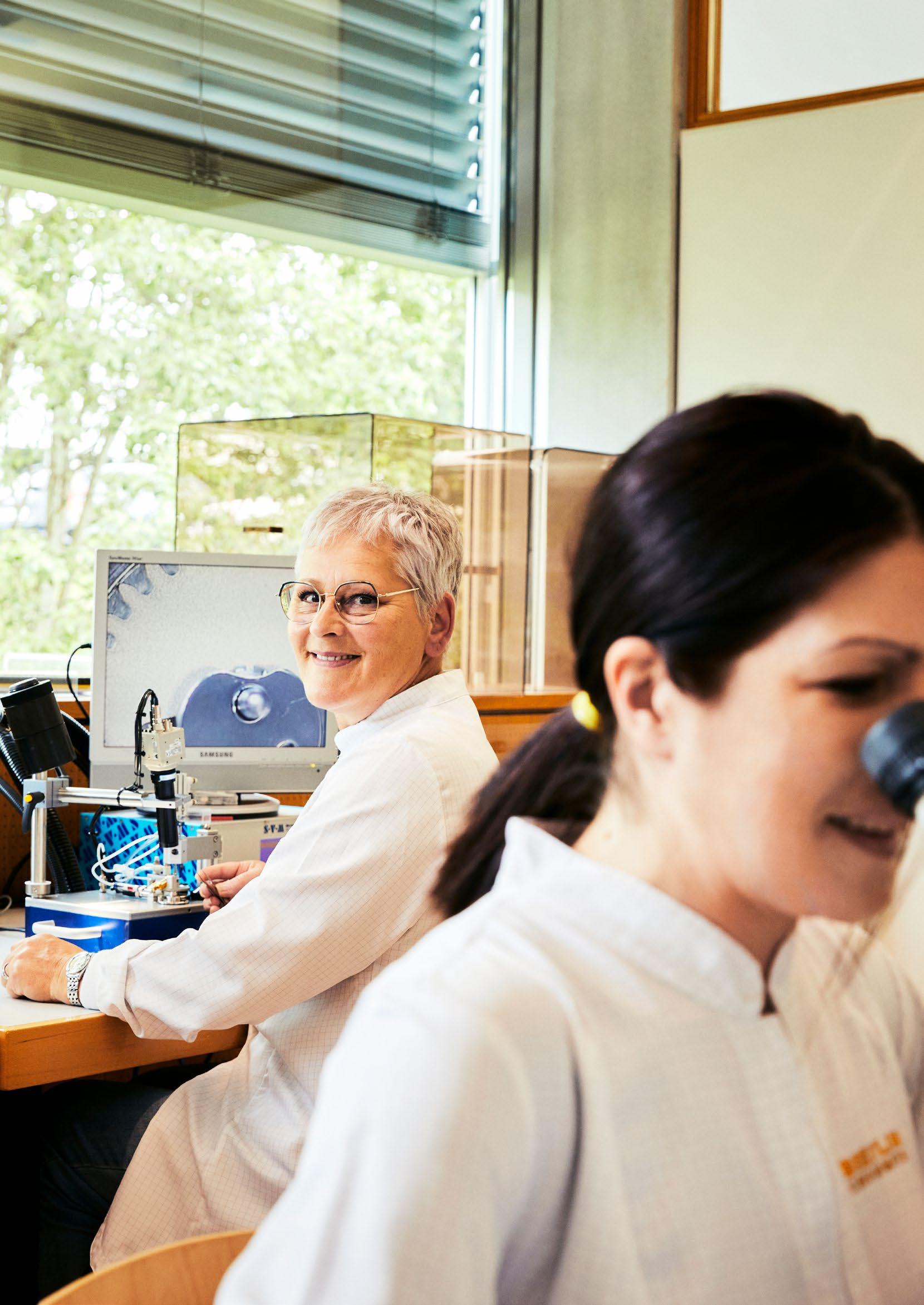

We engage people to take action for sustainability and support personal development to empower resilient transformation. We address material impacts affecting stakeholders across our value chain, from our supply chain partners to our employees, our customers and communities across the globe. We are recognized as a Best Employer in Switzerland by Handelszeitung.


SUPPLIERS: SUPPORT AND PARTNERSHIP FOR CAPACITY BUILDING
COMMUNITIES: ENGAGEMENT AND IMPACT AT A GLOBAL SCALE

SQUAD ON A MISSION TO DO BETTER WE ENGAGE PEOPLE TO TAKE ACTION FOR SUSTAINABILITY AND SUPPORT PERSONAL DEVELOPMENT TO EMPOWER RESILIENT TRANSFORMATION

EMPLOYEES: EDUCATION AND EMPOWERMENT FOR SUSTAINABLE TRANSFORMATION
CUSTOMERS: TRANSPARENCY AND ENGAGEMENT FOR AWARENESS AND BRAND VALUE


Breitling is committed to respecting and supporting the protection of internationally proclaimed human rights. Our commitments are set out in our ESG Policy, our Employee Code of Conduct, and our Supplier Code of Conduct, all of which are publicly available. They reflect the importance Breitling places on respecting human rights, such as labor rights, and engaging with people in our own operations and throughout the value chain as well as our customers to address freedom of association, forced labor, and child labor, among other topics.
Breitling adheres to all relevant employment, labor and human rights laws, industry standards, and international norms across our business activities and operations including with regard to our customers to the extent they apply to our interface. Breitling is committed to monitor compliance with the UN Guiding Principles on Business and Human Rights, ILO Declaration on Fundamental Principles and Rights at Work, ILO No. 138 and 182 on child labor and the OECD Guidelines for Multinational Enterprises.
We bring these values to life by engaging our stakeholders to understand the supply chains with which we work, especially in sourcing materials like gold or diamonds. This ensures our workforce, subsidiaries, business partners, and value chain workers uphold the same commitment to the protection of human rights and are not complicit in human rights abuses.
In our Supplier Coder of Conduct, we address the safety of workers, precarious work, human trafficking, and the use of forced labor or child labor through the adherence of chapters “A. Labor”, “B. Health and Safety” and “D. Ethics” of the Responsible Business Alliance (RBA) Code of Conduct which is applicable to all industries globally. The RBA Code of Conduct is derived from the most important international human rights standards, including the ILO Declaration on Fundamental Principles and Rights at Work and the UN Universal Declaration of Human rights. All aforementioned policies are underpinned by the annual Breitling Sustainability Mission Report and the Breitling Strategic Plan, both of which are subject to the board of directors’ approval, in the case of the former through review in the board ESG committee. The policies are regularly reviewed to
ensure the uptake of all relevant instruments and remain an ongoing reflection of the values of Breitling. Necessary amendments are considered in consultation with internal and external stakeholders who are subject matter experts in relevant fields and ultimately approved by the management, including the CEO of Breitling. The policies clearly indicate the expectations of relevant stakeholders and external actors. Operational procedures embedded in our business activities are duly communicated to those concerned.
To address any potential human rights impacts or concerns about compliance with any of our policies, employees, suppliers, and affected stakeholders along our value chain, including our customers, are encouraged to report these via our reporting line, SpeakUp. Currently, the availability of the SpeakUp platform is publicly communicated to our suppliers through our website and shared internally to employees through our internal communications platform. Breitling publicly shares access to its SpeakUp-Line and the FAQ to expand the reach of availability to key stakeholders and is continuing to review means to promote its availability and assess the trust held by our stakeholders in this process as a way to raise their concerns or needs and have them addressed.
All reporting coming in through the SpeakUp platform (phone line or website) will be transmitted to a group composed of persons from Legal, Compliance, Human Resources and sustainability functions (Global Compliance). Once received, Global Compliance will evaluate and assess the information and determine the appropriate course of action. This will, in most cases, result in the responsibility for next steps being assigned to the most appropriate persons. Global Compliance will

provide a high-level anonymized report to the group esg, compliance & risk committee of the group board of directors quarterly and to the group board of directors once a year on all reported cases. This reporting line is currently open for our employees, suppliers and affected stakeholders along our value chain.
Through the abovementioned processes we duly and fully adhere to the non-judicial grievance mechanisms outlined in the UN Guiding Principles on human rights.
Our human rights policy commitments detailed above regarding the ESG Policy are applicable to the treatment of our own workforce, suppliers, affected communities, consumers, and end-users. They are also applicable to employees who interface with value chain operations both as outlined in the ESG Policy and in the Supplier Code of Conduct. We monitor compliance with these principles in our own workforce through ongoing engagement on the part of HR business partners to closely follow relevant practices, and through speak-up measures including both the hotline and regular, anonymous assessments among employees. In our value chain, we do so through regular interaction with external counterparts, review of documentation and site visits, particularly to sourcing areas with particularly high risk for human rights abuses, as outlined elsewhere in this chapter. These visits include direct engagement with value chain workers at the worksite in order to understand conditions on the ground and hear their direct perspective about improvements that can be made, and potentially supported by Breitling for implementation.
Should we identify that we have caused or contributed to adverse impacts, we commit to take reasonable action to remediate in a fair and equitable manner. In the case of identification of adverse impacts that have occurred to which we have not caused or contributed to, but which are directly linked to our operations, products or services by a business relationship, we will assess on a case-by-case basis whether it is opportune to voluntarily engage in remediation.
Our policies with regard to value chain workers are aligned with internationally recognized instruments relevant to value chain workers, including the United Nations (UN) Guiding Principles on Business and Human
Rights, particularly the corporate responsibility to protect human rights. We do so by working to prevent and mitigate the occurrence of these, including by changing our sourcing methods and working extensively with key value chain partners to implement mitigation measures, particularly for populations that require special attention, as outlined in other sections of this chapter. To date, no cases of non-respect of the UN Guiding Principles on Business and Human Rights, the International Labour Organization (ILO) Declaration of on Fundamental Principles and Rights at Work, the Organisation for Economic Co-operation and Development (OECD) Guidelines for Multinational Enterprises or other severe human rights issues have been definitively confirmed regarding value chain workers.
Consumers and end-users are a key group of our affected stakeholders and are covered by the same policies and processes as our employees, suppliers and other affected stakeholders with regards to respecting human rights. Our approach is informed by the interest, views, and rights of our customers, including respect for human rights, as determined by the inclusion of customer views in the double materiality assessment, which was carried out in addition to ongoing exchanges with our customers on different platforms.

In line with our values, stakeholder expectations, and ongoing evolution in the regulatory landscape (and more specifically the counterproposal to the Responsible Business Initiative (RBI) in Switzerland), Breitling has conducted a human rights gap and risk analysis. The aim of this exercise was to expand and deepen our awareness and understanding of actual or potential existing risks in our approach to ensure practices that meet our values and regulatory requirements with regards to human rights due diligence (HRDD) along our value chain ranging from the extraction of raw materials to sales staff. Hereby, the focus of the gap and risk analysis rested not only on risks related to our direct actions, but rather on the human rights impact of all our suppliers and stakeholders along the entire value chain, i.e. from the extraction of the relevant metals to the transport and manufacture of the end product through to sale and the end of the product life cycle. Following a legal scoping, Breitling complies with the Swiss law by making use of the exception (CO Art. 964j Para. 4) and applies international standards in their entirety as listed in Annex 2 of the ordinance on due diligence and transparency.
Grievance and remedy
What is needed for an effective grievance mechanism? How can a company use it to identify human rights issues and provide effective remedy?
Track and communicate
How does a company monitor the effectiveness of its measures? How does it communicate transparently about its actual and potential impacts and how it deals with them?
Embedding respect for human rights
How can a company successfully embed and integrate HRDD into existing business processes?
The human rights gap and risk analysis was conducted with the support of focusright, which works with companies to embed responsible business practices and human rights due diligence throughout their business and supply chains. The Breitling Legal & Compliance and Sustainability team formed the core project team while other internal subject matter experts, particularly from human resources and procurement, were consulted at various stages of the assessment.
The assessment in its entirety was conducted in line with the UN Guiding Principles on Business & Human Rights (UNGPs), the OECD Guidelines for Multinational Enterprises and related international standards on HRDD. As can be seen in the graphic below, the key elements of HRDD include policy commitment; human rights risk / impact assessment; cease, prevent or mitigate adverse human rights impacts; embedding respect for human rights; track & communicate, and grievance & remedy. Building on this framework a set of methods such as self-assessments, workshops, and desk research were applied to ensure a high-quality assessment.
Policy commitment
How does a company credibly express its commitment to respect human rights?
Human rights risk and impact assestment
How can a company identify human rights risks and impacts?
Risk-based measures
How does a company identify, prioritize and implement effective risk-based measures to cease, prevent or mitigate negative impacts?

The first part of the assessment consisted of the human rights gap analysis including an assessment of the current implementation status of the 33 criteria alongside the six key elements of HRDD listed above with the aim of identifying opportunities to close gaps and integrate human rights aspects into existing policies and processes. Based on a self-assessment questionnaire completed by Breitling and in-depth workshops together with focusright, each element was assessed on a scale from 0 (no measures in place) to 5 (maximum). This resulted in the graphic below indicating the current level
of maturity per HRDD element for Breitling. Overall, the assessment showed that the implementation across the key elements is advanced, as shown by the level of implementation ranging from reactive management to strategic integration. While this is a positive starting point which can be credited to the actions, we have already taken to re-shape our approach to procurement and supplier engagement, we are committed to increasing our maturity across the six key elements and will continue to report on the actions taken along the way in our annual Sustainability Mission Report.

Following this assessment, we conducted a high-level risk analysis by developing a value chain map together with focusright including key activities and potentially affected groups combined with desk research to identify human rights-related risks along the value chain. A value chain map was created including the levels of the value chain starting from raw material extraction to end of life covering own operations and third-party operations which were mapped against human rights topics . This map was established, reviewed and validated during a workshop with the Breitling core team. Each human rights topic was evaluated according to severity and likelihood per value chain element resulting in a heat map creating the basis for a qualitative risk analysis. As for evaluating the impact materiality per ESRS guidance, the severity of human rights topic per value chain element was assessed according to scale, scope and remediable character and was ranked from a 1 to 3 with 3 signifying a high severity due to significant negative impact on human rights, high number of people affected and/or impossibility to remedy the situation. Likelihood was assessed on a scale from 1 to 3 by defining the probability of a risk materializing while considering
the nature of the business activity, relevant business relationships, the operating context and presence of groups vulnerable to impact as well as existing mitigation measures in place.
Based on the assessment of severity and likelihood of each human rights topic per value chain element, clusters were formed creating salient human rights topics. With a threshold set at a score of 2.5, the assessment resulted in the identification of seven salient human rights issues across the value chain. Breitling applies a risk-based approach by identifying the most important human rights issues along the value chain in order to identify which groups of people and stages of the value chain need to be targeted with issue-specific measures. As a result of the high-level risk analysis, recommended key actions have been identified to address the most significant risks along the value chain and a human rights action plan is being developed as a result of the work undertaken with focusright. We are working on implementing these recommendations in the ongoing reporting cycle, among others by including the topic of child labour into our ESG Policy.
Child rights / child labor
Community impacts of raw material production
Discrimination and harassment
Environmental impacts of raw material production & end of life
Labor rights of workers in the value chain
Living wage / income
Occupational health and safety
Raw material extraction / processing
Raw material extraction / processing
All value chain elements including our own activities
Raw material extraction / processing
Workers in the value chain
Workers in the value chain
All value chain elements including our own activities

Value chain workers are a key stakeholder group affected by our business activities. This is one important reason why we make efforts to work with value chain partners with whom we can develop a direct relationship and foster an open, action-oriented exchange on topics such as human rights, community engagement and environmental impact, among others. In so doing, we can contribute to larger, systemic processes which materially impact value chain workers and others affected through their livelihood.
As a potential spillover effect, these efforts may inform larger sectoral or regional shifts, including through the development of learnings and best practices that may be replicated, or the establishment of norms to which others work to adhere. At the same time, failing to act in a manner described above, could likewise result in opposite effects that could be detrimental to workers in the value chain.
The impacts, risks and opportunities identified related to this are connected to our strategic business models, particularly our traceability- and community-based value chains, in which we work directly with upstream supply chain partners and strive to support social development and environmental protection in the operations from which we source. A key aspect in this respect is our transition to artisanal and small-scale gold (ASGM) sourcing, which enables traceability to specific operations, and at the same time is linked to a number of potential material topics including working conditions, environmental impacts that can ultimately impact local communities, and a range of other factors.
The shift to traceability- and community-based value chains by Breitling was prompted by the need to directly engage with the social and environmental impacts that occur in our value chain. The range of impacts, risks, and opportunities inherent in key value chains for our industry, such as the gold and diamond supply chains, and the risk of a number of detrimental impacts, including, but not limited to human trafficking, forced labor, child labor, environmental degradation, corruption, money laundering, conflict, violence, and others, drove our value chain transformation. This has fundamentally reshaped our strategy and business model.
This ongoing transformation process from commodities-based to communities-based value chains presents both risks and opportunities to the company. On the one hand, it allows us to develop deeper, values-based relationships with one another that lead to greater trust, higher development possibilities for both sides as a result of our resourcesharing in terms of both knowledge and financialbased resources, and other factors. At the same, it creates greater dependencies upon one another, and the nature of our relationships. This highlights the importance of our ongoing mutual investments to increase resiliency across our supply chains to support social development abd environmental protection, among other factors. This transition is only one way in which we take into account social and environmental criteria for the selection of suppliers, which is done increasingly across business operations, with the strongest advances to date in direct procurement for watchmaking, and in development for indirect procurement related to commercial activities beyond watchmaking.
This dependency needs to be acknowledged and mitigated by establishing suitable mechanisms to build shared resiliency. We have accordingly established key funding mechanisms, for example the Better Gold and Better Diamond fund, in addition to the Breitling Carbon Fund, all of which are deployed in order to support shared supply chain resiliency and contribute to meaningful community investment locally.
In order to address the material risks and opportunities arising in relation to value chain workers, including dependencies therein, Breitling regularly engages with value chain workers to understand material risks.

In order to mitigate material risks arising from impacts and dependencies on value chain workers, we implement a number of actions. This includes regular exchange with suppliers, including on-site, to understand potential root causes of negative and positive risk (opportunity) and to co-create means to address these with suppliers, who have already been pre-selected with these considerations in mind. These activities will continue, along with the ongoing consideration of how we can best balance business demands and impacts on value chain workers. These ongoing exchanges will continue to be used as one important opportunity to track the effectiveness of our efforts. In the case of negative impacts, our ESG Policy outlines the conditions for remedy.
The traceability and community-based business models which Breitling is implementing require substantial coordination and investments both within Breitling and among external stakeholders. This is a key aspect of the management of material impacts related to workers in the value chain. Oversight on key topics related to operations, financial, and governance aspects are delegated internally at the highest level to the Chief Operations Officer, Chief Financial Officer and Chief Administrative Officer, respectively in addition to the Chief Sustainability Officer. Numerous responsible colleagues at the management and implementation level further work on addressing related topics with relevant counterparts, with a total of nine colleagues across the functions mentioned above being in charge of specialist topics. They are responsible for implementing practices with value chain partners and relevant industry collaboration activities.
In this reporting cycle, we have committed to support our gold sourcing counterparts to advance within two years to achieve Step 2 accreditation from Swiss Better Gold, in the process improving technical, environmental and social practices. This commitment has been established based on discussion with value chain workers and their representatives concerning the most material impacts currently faced. To realize this commitment, the dialogue has been established with counterparties by whom concessions are owned and with insurance providers to develop relevant services. Having just been established, there is no further tracking to report at this time or lessons or improvements established to date.
We continually engage with our suppliers in order to assess and where relevant, contribute to their efforts to achieve positive impact across the supply chain and proactively mitigate risks. By conducting annual EcoVadis assessments, we are able to independently assess and have a common understanding upon which to advance progress. Through regular meetings occurring approximately on a quarterly basis, we jointly review our progress, share best practices, and exchange resources. The outcome of our collaboration is documented in our EcoVadis assessments for both Breitling and our suppliers, which continuously improve: the average EcoVadis score of our suppliers has risen more than ten percent, from 51 in 2022 to 58 in 2023. This approach has further our efforts on sustainable sourcing, which is in turn reflected in our EcoVadis sustainable procurement score, of 80/100.
Our target to improve the overall EcoVadis performance for suppliers by 15% in turn address all aspects of supplier sustainability, given the full-scope nature of this independent assessment. It is thus a key target for us to assess material impacts, risks and opportunity related to value chain workers and through improvement in performance, indicative of the measures taken, including our collaboration with suppliers. This is further supported by targets tailored to specific parts of our supply chain, most notably in our gold supply chain. In setting these targets, we have engaged directly with workers in the value chain, for example directly at the mine site, or with representatives and credible proxies, for example in the conduct of our human rights risk assessment that is detailed herein.
The scale and scope of sustainability requires as well collaboration within our industry. This is why we are grateful to be able to contribute to, and benefit from specific industry collaboration initiatives that have been underway for the last two years to drive key aspects related to supplier engagement, supply chain management, environmental impact assessment and other important factors. We will continue to be present and engaged in relevant industry forums to be sure that we are able to benefit from these collaborative engagements.
As part of our commitment to achieving material positive impacts, we have undertaken several activities

aimed at enhancing resilience in several key aspects of our supply chain. We consult with our suppliers to share best practice guidance on the full scope of topics within environmental, social, and governance considerations and to extend awareness of one anothers practices including on material sourcing, traceability and environmental action. We support our suppliers, also financially, to uptake best practices for social and environmental sustainability. We have also engaged our suppliers in other key targets that we have established, such as plastic waste reduction. In collaboration with our quality, production and retail departments, we engage with our direct suppliers in Switzerland and our boutiques worldwide to co-create and implement initiatives to reduce plastic and develop our shared approach to circularity. This allows us to continually deepen our collaboration and work in a targeted manner to achieve results together, an endeavour that has been complemented by a steady increase in resources for sustainability among several of our key suppliers.
Through our engagement with value chain workers, we have placed greatest emphasis upon developing an understanding of conditions for workers in contexts which are at greater risk of harm. Within the value chains in which we engage, this particularly concerns workers in the gold value chain.
In order to develop this understanding, key Breitling staff with operational responsibility for supplier sustainability engagement, namely the Chief Operations Officer, Chief Sustainability Officer and Sustainability Manager, participated in this reporting cycle in a multi-stakeholder visit to the operations from which Breitling sources in Peru. The visits included each of the operations from which Breitling currently sources or intends to source. These visits are conducted with Swiss Better Gold and complement their own site visits conducted according to the SBG sourcing strategy, upon which each artisanal and small-scale gold mining operation from which Breitling sourced, is assessed on a regular basis.
Where possible, site visits by responsible Breitling staff occur before the commencement of the business relationship (this is the case for all new operations identified in the reporting cycle) and continue during the course of the business relationship. Visits by Breitling
itself currently occur approximately on an annual basis, while more frequent visits are made by further collaborators in the value chain, most often on a monthly basis in the case of sourcing counterparts at processing plants, or at least quarterly, if not more often in key periods, by Swiss Better Gold implementation teams.
During these visits, Breitling staff engage at the worksite directly with workers in the value chain in their place of work, experiencing first-hand the conditions in which they work, and developing a first-hand, human-level understanding of the risks and opportunities which exist. These visits then inform the priorities established by Breitling and its supply chain counterparts, by the workers in the value chain and by the local communities for ongoing improvements to be made in terms of working conditions, remediation measures, community investment and environmental impact mitigation projects. Outcomes of activities are then closely tracked by Breitling and relevant implementing partners and are reported in the annual Sustainability Mission Report.
In the course of the reporting cycle, these visits identified key projects that are now being developed with the support of the voluntary contributions that Breitling makes for Swiss Better Gold Step 1 material ($0.50 for each gram of gold sourced that is not attributed to Step 2 Swiss Better Gold sources). These currently focus on ensuring accreditation status for artisanal operators in the gold supply chain located in the community of Hatuncasa, in the Andean highlands above Arequipa, Peru. It is planned to support the provision of work accident insurance and the ongoing development of measures to improve safety at the mine site and to address material negative impacts related to health and well-being in the workplace, in addition to further objectives that will continue to be identified in the course of collaboration.
In the region of gold processing in Chala, also in Arequipa, along the coastal Atacama desert, the focus has been placed on the transition to a dry tailing, instead of wet tailing facility, to both support a reduction in water demand and a corresponding energy demand reduction due to reduced needs for pumping. The benefits of this planned engagement extend also to have local community impacts as these projects concern the conservation of groundwater. Importantly, the MYSAC mine in Yanaquihua, also in the region of Arequipa, was the site

of a multi-day visit. During this time, the focus in a multistakeholder dialogue was placed upon personally visiting the mine that has suffered a tragic accident that was reported upon in the 2023 Sustainability Mission Report, discuss the measures taken on-site to address the contributing factors, and the current status of distribution of benefits to dependents. Breitling has contributed to the voluntary funding made available to survivors in addition to all relevant government and company-based support mechanisms. This voluntary funding focuses on enabling education for all surviving dependents.
Breitling contributions to MYSAC from purchases to date will also support ongoing improvement measures directly at the mine site to remedy aspects identified in the course of site review of the Swiss Better Gold Association monitoring and verification teams. In this regard, the following measures have been taken by the Swiss Better Gold Association, as also detailed in their 2023 Impact Report. Immediately after the accident, SBG reinforced its presence on site to carry out its own checks as a double verification complementary to the Responsible Jewellery Council certification which the MYSAC own operations had already received. In close coordination with management and mine professionals, a continuous improvement plan has been put in place, carrying out an in-depth review of the mine‘s practices, with a special emphasis placed on aspects related to health and safety at work.
Following this incident, in October 2023, a multidisciplinary team of four SBG specialists conducted a new field evaluation on site. In February 2024, the SBG commissioned a specific health and safety on-site verification event conducted by a specialist Peruvian audit firm. This audit and findings of the resulting gap analysis then formed the basis of a continuous improvement plan now being followed on-site. Meanwhile, as part of its own continuous improvement, SBG has also reviewed its control instruments, particularly related to occupational health and safety. Indigenous Peoples are currently understood to be within affected communities with our gold supply chain in Peru. Policy provisions related to preventing and addressing impacts on Indigenous Peoples are outlined by the Breitling ESG Policy along with further processes and mechanisms which inform this. Indigenous practices continue to be practiced at mining operations, including in the seeking of permissions from gods and guardians for mining activities and caring for the earth in the process of
mining activities. In ongoing consultations with mining operations and the surrounding communities, their views, interests and rights shall continue to inform our shared strategy and the ongoing development of our business relationship.
Within these contexts, the types of communities subject to material impacts are seen to be those rural communities close to extractive and processing operations in our gold value chain where environmental and social impacts occur, and the broader local urban communities where our lab-grown diamonds are sourced, our products are made, and sold. We will continue to assess the scope of our engagement with affected communities in order to inform related efforts.
In our artisanal and small-scale gold mining (ASGM) value chain, we visit local communities in person, on visits occurring approximately on an annual basis, in order to understand the local context and how we can best contribute as a system participant. In Colombia, these visits occurred in the community surrounding the Touchstone mine, where Breitling sourced from in 2021 and 2022, and informed the development and funding of a remote, multi-generational local educational program to meet the needs determined by the local community. In Peru, we visited the local operations from which we currently source or intend to source. These involve long journeys to remote areas and are complemented by regular visits by local teams of the Swiss Better Gold Association and supply chain partners including processing plant and refiner representatives. Further details on objectives thus far established are also available under the section Workers in the Value Chain.

Breitling’s engagement in the responsible sourcing of raw materials is exceptional in an industry that has been slow at establishing responsible sourcing strategies. ” “
PROF.
DR. DOROTHÉE BAUMANN-PAULY DIRECTOR, GENEVA CENTER FOR BUSINESS AND HUMAN RIGHTS

ARTISANAL AND SMALL-SCALE MINING (ASM) FORMALIZATION: A KEY RESPONSIBLE SOURCING APPROACH FOR SUSTAINABLE DEVELOPMENT
In the gold supply chain, the prevalence of artisanal mining is particularly pronounced, employing 10-15 million workers globally and producing 20% of the world’s gold. As rising global temperatures will affect agriculture and fisheries, we can expect that even more workers will flock to artisanal gold mining sites to earn a living. If companies are serious about contributing to the 2030 Agenda for Sustainable Development, the formalization of ASM is a concrete example for how to support development, reduce global inequalities, and leave no one behind.
Supporting ASM formalization has a tangible impact for workers. At a site included in my research on ASM mining for cobalt in the Democratic Republic of the Congo, the formalized pilot site documented no fatal mining accidents, had higher productivity due to easier access to the ore, and it generated higher household incomes because both men and women were allowed to work on the extraction site. These positive effects of ASM formalization addressed root causes of child labor and enabled parents to send their kids to school.
While artisanal mining correlates with greater human rights risks such as mine safety issues and child labor,
it also offers a unique opportunity for companies to create decent jobs in communities where they are needed the most. Companies that support the formalization of ASM will be able to share measurable impacts beyond reporting on legally required compliance with human rights due diligence procedures.
For companies with precious metal supply chains, artisanal mining must be part of responsible sourcing strategies. Barriers to mainstreaming ASM formalization remain high but if there’s a will, there’s also a way. Downstream companies need to come together to promote responsible sourcing with ASM. Breitling’s leadership in sourcing and integrating traceable gold from the Swiss Better Gold initiative in its products will be key for driving change in the luxury goods sector.
Breitling’s engagement in the responsible sourcing of raw materials is exceptional in an industry that has been slow at establishing responsible sourcing strategies. The company’s firm commitment to source gold from formalized ASM is part of this engagement and it supports the objective to create positive socioeconomic benefits for communities through sourcing.

We also regularly interface with supply chain intermediaries in other settings, most notably in factories. Based on results from independent supply chain audits, Breitling has further engaged in follow-up measures in order to address necessary remediation measures. The one case of this occurred in a facility polishing dials made of mother of pearl, where it was necessary to ensure the application of standards related to the use of protective personal equipment. Visual evidence of remediation of the supplier was provided at the close of the intervention, though an on-site facility visit did not yet occur. Site visits are also conducted, approximately on an annual basis, to suppliers of lab-grown diamonds, complementing existing audit measures in place according to the SCS-007 Jewelry Sustainability Standard –Sustainability Rated Diamonds to ensure the presence of full-scope sustainability practices and traceability.
In addition to these measures, through regular and ongoing engagement with suppliers, Breitling is able to provide a positive influence on supply chain partners and make ongoing improvements for value chain workers. Breitling regularly follows up with suppliers and with implementing partners in order to track the application of measures to address material impacts and assess their effectiveness. This is done through remote reporting or during on-site visits.
We work to integrate the interests and views of value chain workers in our strategy and respect human rights through our actions. We do so both in the materiality assessment detailed herein and through site visits to a number of operations in order to assess the status of
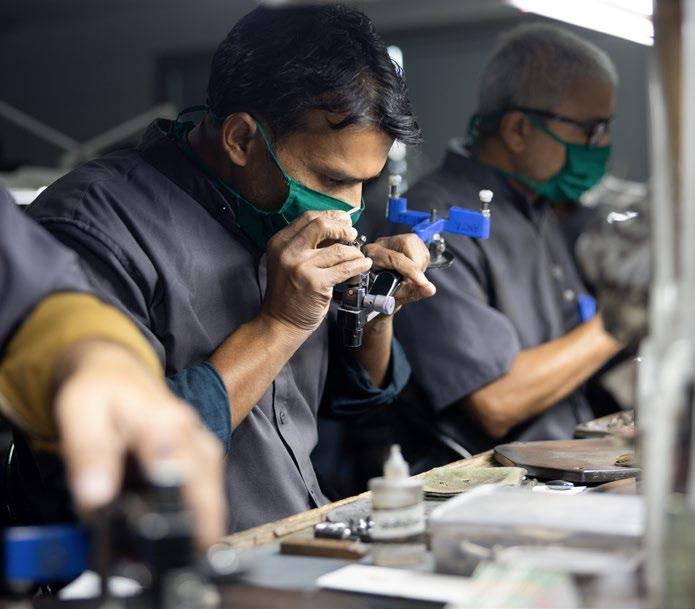
operations with greatest materiality first-hand. Our supply chain code of conduct applies to all suppliers, with broader applicability indicated therein to sub-tier value chain workers as well.
In addition to this, to address potential malpractice along our supply chain, our reporting line (SpeakUp) is accessible to our suppliers who wish to raise concerns about compliance with our Supplier COC and other policies. Reports can be submitted anonymously through either phone or a web interface. Reporting concerns through SpeakUp is safe and confidential. All concerns are treated seriously and processed promptly.

The views, interests and rights of affected communities have been considered in the definition of the Breitling strategy and business model through the conduct of an inclusive materiality assessment, detailed in the progress section of this report. It is important to take these perspectives into account because they allow us to better understand the local context of the systems in which we are engaging, and in the case of local investments, to best tailor these for the needs determined by the community.
The traceability and community-based business models which we espouse enable us to have this direct and valuable contact and be able to engage with and learn from these systems in which we are present.
These strategies are considered to be an origination of the positive impacts identified in our materiality assessment and our local engagement. This informs and contributes to the adaptation of our strategy and business model. The specific ways it does so is in strategic decisions surrounding sourcing and brand communications. As a result, our material risks and opportunities related to affected communities are also a key aspect of our strategic development, which in turn shapes the resulting impacts upon communities through our ongoing shared engagement.
Given our reliance on these regions for the sourcing of key materials, there is both a risk involved in the concentration of our efforts and an opportunity, given the chance we have to crowd-in our resources in order to support and contribute to the development objectives determined by community members which we support financially and through other knowledge-based support mechanisms.
Through site visits to selected value chains and stakeholder consultations taking place in-person and remotely over time, Breitling further takes into account the perspectives of affected communities. Currently, this is actively done for the ASGM and lab-grown diamond supply chains in which Breitling is active and where material topics are seen to be of greatest relevance, our own operations in Switzerland, the local communities in which our products are sold, and within the broader communities we engage with through
partnership activities detailed in the prosperity chapter of this report. Meanwhile, other communities in which supply chain operations exist are seen as within scope, while noting that efforts have been prioritized based on our current understanding of materiality.
Resources to contribute to positive impact for affected communities include the allocation of senior management time, accounting for a substantial portion of the responsibilities of the Chief Sustainability Officer along with other subject matter experts, and through the establishment of funds including the Breitling Better Diamond Fund, Better Gold Fund and Carbon Fund. Further details regarding this can be found in the prosperity chapter.
To our understanding to date, the communities with particular characteristics that may be at greater risk of harm concern those related to gold sourcing, particularly extractive activities, and less so processing activities, along with the local producing communities in Switzerland, which in some cases are heavily reliant upon the watchmaking industry.
Our engagement with affected communities is governed by the principles outlined in our ESG Policy, which is applicable to all relevant areas of engagement. Further relevant governance topics are outlined therein according to ESRS 2 MDR-P Policies. During the current reporting cycle (FY24) and continuing into the ongoing reporting cycle (FY25), we have updated our ESG Policy to reflect best practices and our intention to achieve these in our actions. These include the following:
Our engagement with local communities in the areas and scope described above occur directly with

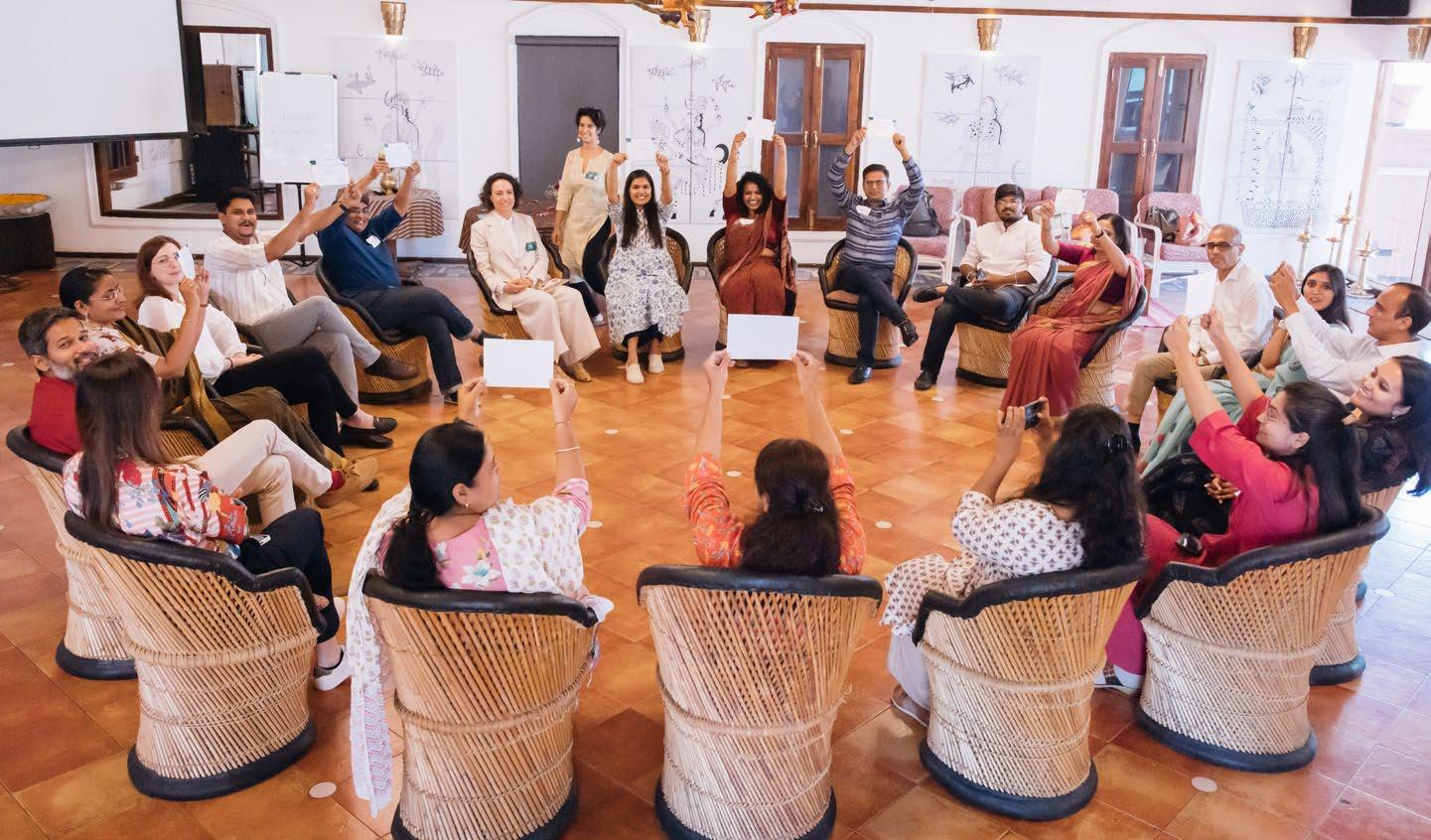
community members and with collaborating partners who are familiar with the community context through repeated visits and engagement with representative portions of the community population.
Engagement occurs almost always before any local business relationship commences, and continues over the course of the business relationship, most typically at a frequency of at least annually for on-site visits and approximately monthly for remote engagements. Such engagements consist of visits and discussions seeking to ensure a current understanding of local conditions and developing together approaches to address community-defined development objectives. The function and most senior role within Breitling that has operational responsibility for ensuring this engagement happens and inform Breitling strategy is the Chief Sustainability Officer.
Within the affected communities in our sphere of influence, we particularly consider vulnerabilities facing specific groups, including women and girls. In our lab-grown diamond sourcing communities in western India, education for social impact leaders
supporting women’s economic empowerment, childhood education, environmental protection and other areas, is a key aspect of our local engagement that will continue to be developed in the coming years. In the gold mining supply chain, we are also reviewing means to address this topic in view of local cultural and social traditions.
To assess the effectiveness of engagement, dedicated monitoring and evaluation methods are established according to the specific context of the intervention. This is done on an ongoing basis throughout the course of our activities.


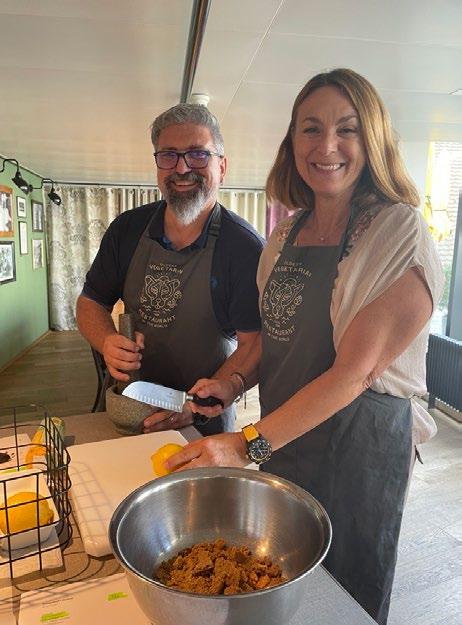
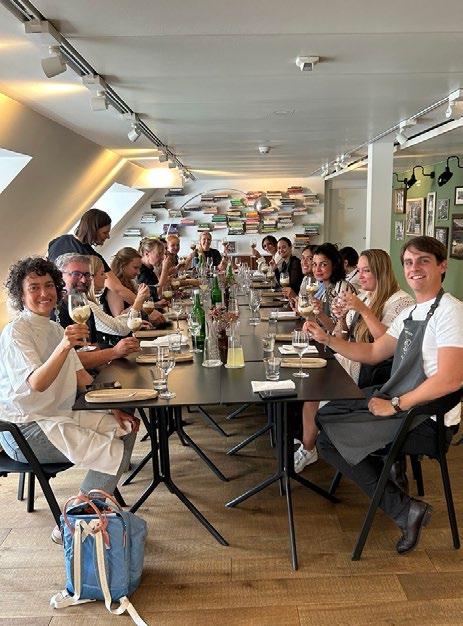
In our lab-grown diamond supply chain which is centered in the state of Gujarat in western India, we have made substantial efforts to engage with the affected communities since our business relationships commenced in 2022. On three separate occasions, Breitling staff, including in various delegations the Chief Operations Officer, Chief Sustainability Officer and Chief Product Officer have engaged with local community members and NGOs to best understand how Breitling can make a valuable contribution as a member of the local system.
In so doing, Breitling was able to inform the development of the social impact leader training program it is conducting in collaboration with the Amani Institute and which has welcomed nearly 40 participants to date, with impacts extending to their stakeholders which represent a diverse range of individuals in the affected communities. Further details are available in the Prosperity chapter.
With regards to actions taken or underway to mitigate material negative impacts onto affected communities, this consists primarily of the provision of training to workers in the gold value chain. This impacts affected communities as the miners are often originating from these areas, and impacts upon them would be felt in the community. The standard metric is that one artisanal miner typically supports five further people who may
often themselves be community members. This is supported by further initiatives of benefit to the affected communities. For example, the provision of education and economic diversification activities as has been done in Colombia surrounding the Touchstone mine addresses the potential for economic dependency on gold mining, or the development of projects to mitigate the environmental impact of gold mining and processing activities in Peru.
These measures, particularly those related to training of value chain workers, and those that can contribute to resiliency in affected communities, are a key aspect of our efforts to mitigate both the material impacts and risks that communities may face as well as those to which we are exposed in our reliance upon them through our interdependencies.
When identifying a necessary and appropriate action in response to an actual or potential negative impact, we rely on assessments conducted by specialists with close contact to the affected communities and input from community members. In order to assess the effectiveness of processes established in response to a negative impact, we work with local implementing partners to establish relevant monitoring and evaluation protocols.

In our own local communities surrounding our operations in Switzerland, we support local initiatives related to social and environmental activities. As part of our stakeholder sustainability engagement activities, we organized a variety of events across the country to mark Climate Week, where we spend time in nature with the purpose of learning about the importance of preserving the richness of our surroundings.
This year, these encompassed city clean-ups, a plantbased cooking class spotlighting environmentally friendly recipes, WWF night runs focused on safeguarding endangered species, and a nature day in collaboration with WWF aimed at bolstering local biodiversity. These initiatives not only facilitated team bonding but also heightened awareness of how to practically make a positive impact across a large variety of topics. Our stakeholder sustainability engagement activities go beyond our headquarter-led initiatives and include various activities across our markets including, but not limited to, clean-ups in Dubai (UAE), Besançon (France), and Chiba (Japan) engaging over 130 employees and stakeholders providing insights into waste collection and treatment in local settings.
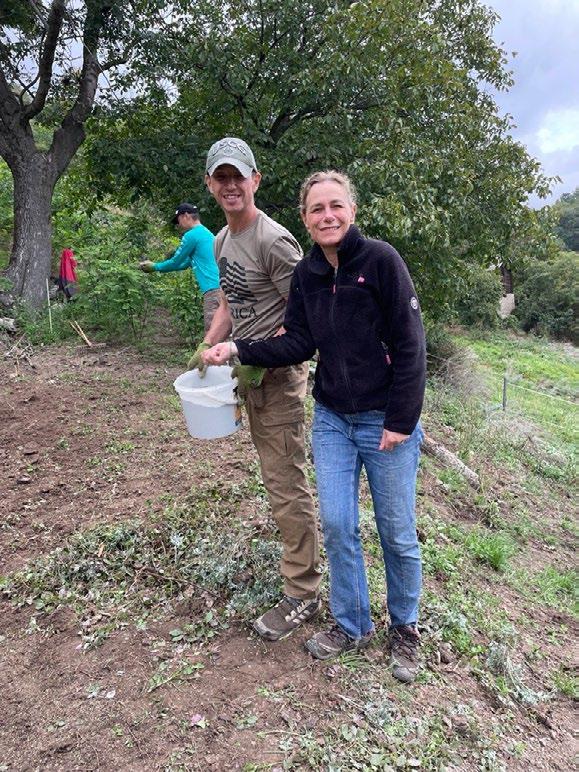
At the start of 2024, we began a fundamental stakeholder engagement initiative at our headquarters, launching a sustainability house tour covering over 200 employees across our manufacturing sites in Switzerland. With the objective of engaging our employees, developing department-level action plans and maturing the sustainability theory of change at Breitling, we facilitated workplace dialogue sessions in small groups. During these sessions, we were able to raise awarenessacross an array of sustainability topics, gain insights on the understanding of sustainability, and more importantly, co-create proposals on how to improve sustainability on a workshop, department and company level. So far, we have collected 180 proposals showing the great interest of our squad members in participating in our mission. Each proposal is addressed, and feedback is provided on the progress of each proposal being implemented. By conducting this fundamental engagement, we are able to continue our efforts towards an inclusive and holistic approach to sustainability. We are working to expand this effort globally within the ongoing reporting cycle.


When reporting on impacts, risks and opportunities related to our own workforce, we consider the entire Breitling squad, as well as our value chain, including those consuming our products and services, and with whom we have our business relationships. No material risks have been identified with regards to our own workforce, and
impacts and opportunities are described in the sections that follow. Our own workforce constitutes 1,894 Squad Members, a significant increase of 200 from the previous year as we continue to expand and diversify our workforce of over 70 nationalities.
Our worldwide Squad is active in 27 countries
Our worldwide Squad by type of role
In the reporting cycle, we have been able to achieve several positive impacts for our own workforce community. Our efforts to do so have been reflected in key external benchmarks. Over the past three years, we‘ve climbed the ranks in the Handelszeitung and PME
- Statista surveys, securing the first position as the Best Employer in Switzerland and within the Watches and Jewellery industry. This milestone is a testament to our collective efforts as a Squad and our commitment to creating a great workplace. We’re also proud to have

maintained our status as a Top Employer in Switzerland for 2024, reflecting our dedication to fostering a positive workplace environment. This certification evaluates organizations across key human resources topics, including people, strategy, work environment, talent acquisition, learning, diversity, equity and inclusion, and well-being.
Several of our shared efforts that have contributed to being an employer of choice and allow us to manage our material impacts, risks, and opportunities are detailed in the following paragraphs. The resources to manage our material impacts consists of a dedicated team of human resources professionals, in some limited areas of overlap complemented by engagement with the sustainability team, and investment in selected programs that accordingly address these topics, also detailed below. Our objectives related to these are further outlined in the targets declared at the start of this chapter and which were developed in consultation with subject matter experts at Breitling in the human resources and sustainability departments, while consulting the results of current and past materiality assessments and feedback to employee surveys. In tracking performance against these targets, we transparently disclose this to all stakeholders, including our employees and who are consulted in relevant surveys and other formats in the process.
We conduct an annual pay gap analysis to ensure equal pay across all levels of our organization. This thorough review helps us identify and address any disparities, reinforcing our commitment to equitable compensation practices. We aim to align our base salaries with the market median, ensuring competitive compensation. To achieve this, we regularly benchmark our compensation against industry peers using reputable third-party surveys. Our compensation packages reflect industry standards, considering factors such as company size, location, and job function to maintain competitiveness. In addition to this, every employee worldwide is covered for unemployment, parental leave, retirement, sickness, injury, and acquired disability under the respective laws of their country. To continue cultivating a diverse, inclusive and equitable workplace, we are committed to developing a training on unconscious bias to ensure that we are able to
address this foundational concern at all areas of relevance within the company, from recruiting onwards. This is only one aspect of our commitment to providing continuous education and promoting a culture of continuous improvement and resilience through a range of initiatives that provide opportunities to expand our employees knowledge, skills, and mental wellness. Our comprehensive program includes personalized coaching journeys for team leaders, project supervisors, and managers, guided by dedicated personal coaches. Additionally, our partnership with getAbstract provides unlimited access to a diverse library of condensed knowledge resources. Through Coursera, our team gains access to flexible and careerfocused online courses. Additionally, mental health being a key concern for us, we offer full access to the Calm app, which provides relaxation resources and mindfulness exercises to reduce stress and anxiety. In Switzerland, we also offer a counselling platform with Movis to help our people navigate through professional and personal challenges confidentially and free of charge.
In addition to these efforts to support our existing employees, we are also continuing to invest in the future and advance our Young Talent initiatives. We are currently training two watch operator apprentices and will increase this to four by August 2024. We also have six apprentices in our boutiques and commercial departments at our head office, with plans to increase apprenticeships in all these areas. Meanwhile, our internship programs have expanded to accommodate seven professional training interns (apprentices completing their studies full time at school). Additionally, we now host eight master’s students in our digital design department and watch production team.
Internationally, our UK division sponsors a watchmaker attending a school affiliated to the WOSTEP Foundation, an independent watchmaking institution supported by members of the Swiss watchmaking industry. In France, we host one finance apprentice and two professional retail and marketing interns. In Germany, we have three apprentices completing their watchmaker training. These forward-looking partnerships for growth at our headquarters and internationally are essential to continue to foster a diverse workforce while staying

aligned with market and academic trends. They support our goal to attract, develop, and retain tomorrow’s talent, further positioning Breitling as a leader in the dynamic educational and industrial landscapes.
Similarly, on our annual Swiss National Future Day, we extend an invitation to children in the fifth through seventh grades to join us in exploring the Breitling universe. Through interactive activities, they not only gain insights into our company culture but also discover potential career paths, fostering a connection with our brand from an early age. These engagements reflect our ongoing commitment to inspiring and empowering the next generation.
While education is essential for us to support our stakeholders, we do not use educational attainment in an exclusionary manner and remain open to hiring outside of our industry. Furthermore, we offer remote work to support inclusive practices for different employee groups.Meanwhile, we are conscious of the ways in which we may contribute to exclusivity through hiring practices. An important topic in this regard is unpaid internships, which can essentially pre-select candidates on a socio-economic basis. For this reason, we do not offer unpaid internships, unless they are under four weeks and occurring at a secondary education level. We also regularly complete objective benchmarking to eliminate bias, evaluate roles based on defined criteria for gender-neutral job grading, and cultivate equity. Through this, we’ve confirmed an adjusted pay gap in favor of women of less than 1% of the adjusted pay gap in favor of women, earning in course the “Universal Fair Pay Analyst” award from the FPI Fair Pay Innovation Lab, a recognition marking Breitling as the first in the watch industry to receive this accolade on a global level.
In order to continually manage ongoing and potentially material impacts, risks, and opportunites related to our own workforce, we work to implement the principles in our employee code of conduct which is also available online, and which covers all of our Breitling workforce and also covers topics including discrimination and harassment, equal opportunities, the advancement of diversity and inclusion. In addition to this, we firmly count on both our culture of listening and of speaking
up to ensure that we are able to advance together as a squad on our shared objectives.
That‘s why we conduct our “Open Up“ Employee Engagement Survey every year, giving everyone a chance to share their thoughts. Last September, we achieved a response rate of 77% and maintained our high engagement score of 75%. The overall feedback highlighted areas where we‘ve made significant improvements, such as providing more learning opportunities, fostering empowerment, and supporting new ways of working. While we‘ve made progress, we acknowledge the need for further improvement, especially in communication and decision-making within teams. To help us lead these changes, we have created dedicated focus groups with selected employees who volunteered to be the change makers. Our squad plays a crucial role in driving positive changes within our organization, as they voice their opinions and contribute to shaping our workplace environment.
We directly engage with employees on sustainability, including all employees in vulnerable or marginalized groups, to seek their input to this survey, and to our double materiality assessment which is available to each employee worldwide to complete which in turn informs decisions and activities aimed at managing actual and potential workforce impacts. We seek employee input at the start of sustainability strategy and decision-making processes, during implementation and after the fact assessments. Engagement occurs through a number of means, including surveys, feedback rounds, or dedicated meetings, with the frequency depending upon the nature of the engagement concerned and often using our internal communication platform, Workvivo, to which all employees have access, to seek this interaction. We track and monitor issues raised in the course of assessing progress on key materials topics. The effectiveness of the channels and of the engagement is assessed based on engagement rates and progress made on key performance indicators (KPIs) established in this chapter.
More general inputs are sought at a minimum on an annual basis with targeted reviews occurring on a

semi-annual basis, approximately. We further complement these exchanges that occur directly with our employees with interaction with relevant industry representatives, including the Association patronale des industries de l’Arc horloger (APIAH). The most senior roles with responsibility for ensuring this engagement happens are the Chief Administrative Officer, the Chief People Officer and the Chief Sustainability Officer. We assess the effectiveness of our engagement with our own workforce through the surveys we conduct and other feedback rounds.
Our transition plans for reducing negative impacts on the environment and achieving greener and climate neutral operations will require us to engage and where relevant, upskill our employees to ensure that they can be a part of this transition. We see this as an opportunity in terms of upskilling, and do not foresee any impacts or risks related to restructuring or employment loss as a result of our transition.
This year we were able to build upon our dedication to cultivating our listening and speak-up culture with the launch of our upward feedback initiative which allows
all employees to provide direct insights to their line managers. Through valuable feedback on their strengths and areas for improvement, we foster an environment where managers can thrive and feel empowered.
We also support our speaking up culture through our international Speak Up line which is available for all employees worldwide, in addition other stakeholders including suppliers, to raise their concerns and report any misconduct. Upon reporting either via phone line or website, the employee will receive a unique case number, which they can use to follow up on their concern through the platform without interference of a human operator and choosing anonymity if desired. The report is translated and shared immediately with the Global Compliance group, which consists of Legal, Compliance, Human Resources and Sustainability functions at our headquarters operations. A response is shared back with the employee through the initial touch-point. The Speak Up line is an important input to reinforce the values we have established in our Employee Code of Conduct and to allow stakeholders to report any infringements to this.

Headcount of employees by geographical areas
Total number of employees by head count, and breakdowns by gender and by country for countries in which the undertaking has 50 or more employees representing at least 10% of its total number of employees
EMEA: 1242
APAC: 377 AMR: 270 NA -
Total HC is 1889 (Switzerland 712, USA 237, UK – 120, Germany – 97, Japan – 96, Shanghai - 95, France 94, Others – 438.
EMEA: 1242
APAC: 377
AMR: 270
Female: 902
Male: 987
Non-binary: Not Recorded
Total number by full time equivalent (FTE) of permanent employees, and breakdown by gender
Total number by full time equivalent (FTE) of temporary employees, and breakdown by gender
Total number of employees who have left the undertaking during the reporting period and the rate of employee turnover in the reporting period
1827.8 FTEs Female: 857.1 Male: 970.7
Non-binary: Not Recorded
69.4 FTEs Female: 37.2 Male: 32.2
Non-binary: Not Recorded
205 voluntary leavers (198.9 FTEs)
Employee turnover rate: 11.2%
Employee turnover rate: 19.5% (FY23)
All countries with 50 employees and more were included.
As non-binary and further genders are not yet offered as an automated selection option in the software platform used by Breitling, these are not yet recorded (please note: this applies to all metrics concerning gender).
Number of voluntary leavers divided by average FTE of the reporting period. Voluntary leavers are defined as employees who hand in their resignation on their own will. This excludes all company-induced termination. 8
Total number of non-employees 128 NA -

The percentage of employees in the EEA covered by collective bargaining agreements
The percentage of employees outside the EEA covered by collective bargaining agreements
Gender distribution in number and percentage at top management level
30% Male: 70% 34.5% in mngt positions (FY23) Ratio of women in management positions to the total of management positions.
Distribution of employees by age group <30: 355 30-50: 1142 50<: 392 - <25: 4.7%
25–34: 28.5%
35–44: 25.7% - 45–54: 27.6%
55–64: 13.0%
>65: 0.6% (FY22)
Age groups adapted to respond to ESRS disclosures 8,10
Percentage of employees that participated in regular performance and career development reviews
Average number of training hours per employee and by gender
It is in Breitling’s annual objectives and processes that 100% of its employees participate in at least two performance and career development review cycles, one at half and one at full financial calendar year.
This is an important topic for Breitling and tracked through the following metric which can be found at the beginning of the chapter: 31% of the Breitling workforce are active learners by end of FY24. 4
Percentage of our employees covered by the health and safety management system based on legal requirements and/or recognized standards or guidelines

Number of fatalities as a result of work-related injuries and work-related ill health.
Number and rate of recordable work-related accidents
Rate: 8.9 recordable accidents for 1’000 employees
Number of days lost to work-related injuries and fatalities from workrelated accidents, work-related ill health and fatalities from ill health
Percentage of employees entitled to take family-related leave
Adjusted global pay gap 0.8% (in favor of female employees)
(FY22)
Regression analysis, which shows the average % difference in compensation that a female employee can expect, after accounting for all objective factors driving compensation at Breitling, as included in the model. The objective factors: The analysis took into account factors such as country of employment, job grade, and tenure in the job.
of the highest paid individual to the median annual total remuneration for all employees (excluding the highest-paid individual)
Number of complaints filed through channels for own workforce to raise concerns (including grievance mechanisms)
Total amount of fines, penalties, and compensation for damages as a result of the incidents and complaints

From
production to after-sales service,
I always enjoy working on our movements, in the same spirit of inclusivity that
accompanied our first development efforts 15 years ago.
LIONEL OUDOT WATCHMAKER
”

As a young watchmaker at Breitling in 2009, I was chosen to assemble the company‘s first “B01“ caliber. This was a historic step forward for the company, as this launched our premier in-house automatic, or self-winding, chronograph movement.
At the time, there were only two of us working on the assembly of this caliber, myself and Sylvie Binetruy (currently in charge of watch setting at La Chaux de Fonds).
Together, we embarked on the first step in our mission: sourcing the over 300 components that would form this revered movement. Thereafter, we were involved in all phases of the decision-making process, both in solving design problems and in integrating the movement with the new dedicated assembly line. Our opinion was taken into account, debated and explained in cooperation with the lead management of Breitling.
With the design of this caliber, we realized the importance of working in collaboration with all the workshops involved before and after the production phase. This encapsulates innumerable processes, all of which are critical to the proper assembly of this highly complicated movement and its eventual certification, a standard uniformly applied by Breitling to all its watches.
One of the objectives was to design a movement that would meet the exacting quality requirements of one of the watchmaking industry‘s benchmark companies,
and the level of rigor expected was very high. Since then, it has set the standard at Breitling. Each movement is scrutinized in detail. The slightest damaged bridge, scratched screw or particle is sent for repair. As a result, not only does the movement meet high operating standards, it‘s also beautiful.
At the time, our ambition was to produce a movement capable of passing the stringent COSC, or the Official Swiss Chronometer Testing Institute, the guarantor of the Swiss watchmaking tradition of precision, criteria without any dynamic retouching of the setting. After the first movements came off the line, we waited for the movement to be evaluated by various watchmaking professionals.
This historic achievement has continued to be complemented by yet more. Since the creation of this movement which was well received by the market, I have personally witnessed the various evolutions of the caliber, including its “little brothers and sisters” such as the B04, B05, as well as limited series such as the B14 for the anniversary of Breitling‘s first single-pusher chronograph.
From production to after-sales service, I always enjoy working on our movements, in the same spirit of inclusivity that accompanied our first development efforts 15 years ago.



Customers are a vital stakeholder group for Breitling. As detailed in the progress section of this report, customers were included in our double materiality assessment process, informing the development of strategy related to sustainability and broader business strategy. Consumer market studies are also reviewed and help inform the development of our corporate strategy and business model.
All consumers and/or end users likely to be materially impacted by our own operations, our value chain, and our business relationships, are included in the conceptualization of disclosures. Actual and potential impacts on Breitling consumers and end-users have been a key consideration in our full-scope double materiality assessment and thereby inform business strategy. Among other things, results of this assessment will be used to shape the Breitling five-year strategic plan. They have also shaped products and services, for example, most prominently in the development of products with the Origins label.
Feedback provided through these processes and thereby the perspectives of consumers and/or end users informed activities that address potential impacts, risks and opportunities. Engagement occurs directly with consumers as well as proxies such as industry representatives and benchmark reports. Engagement occurs through the double materiality assessment process which will be conducted at least on a biennial basis, through ongoing exchanges with consumer groups in dedicated strategy sessions and through board representation especially focused on consumer engagement aspects. The Chief Executive Officer is the most senior person within Breitling responsible for ensuring that customer feedback is informing our business strategy. Outcomes and results are then further assessed in the same forums mentioned above and assessment of the success of implementations based on such guidance in the marketplace.
Material risks and opportunities are indicative of the importance of consumers and end-users to our business model. The results of the full-scope assessment reveal the ongoing necessity of maintaining high service standards for our customers in order to meet their expectations and earn their business while ensuring that any potential negative impacts, risks or opportunities to consumers are mitigated and potential positive impacts are enhanced. At the same time, it raises the importance of the potential or real shift in consumer demands towards products and services with greater sustainability attributes.
In order to inform consumers about material impacts, Breitling communicates in a variety of ways. This includes this annual Sustainability Mission Report in addition to product and consumer-relevant communications which inform consumers of relevant material impacts. Efforts are made to communicate relevant information in a variety of forms to make it accessible and relevant and to contribute to greater awareness among consumers and end-users of relevant topics related to sustainability. To do so, corporate resources are allocated particularly from the sustainability and communications departments, and the activities in which they are engaged.
In the ongoing reporting cycle, we are engaging more and more with our consumers and end-users and look forward to reporting on these activities in the 2025 Sustainability Mission Report.

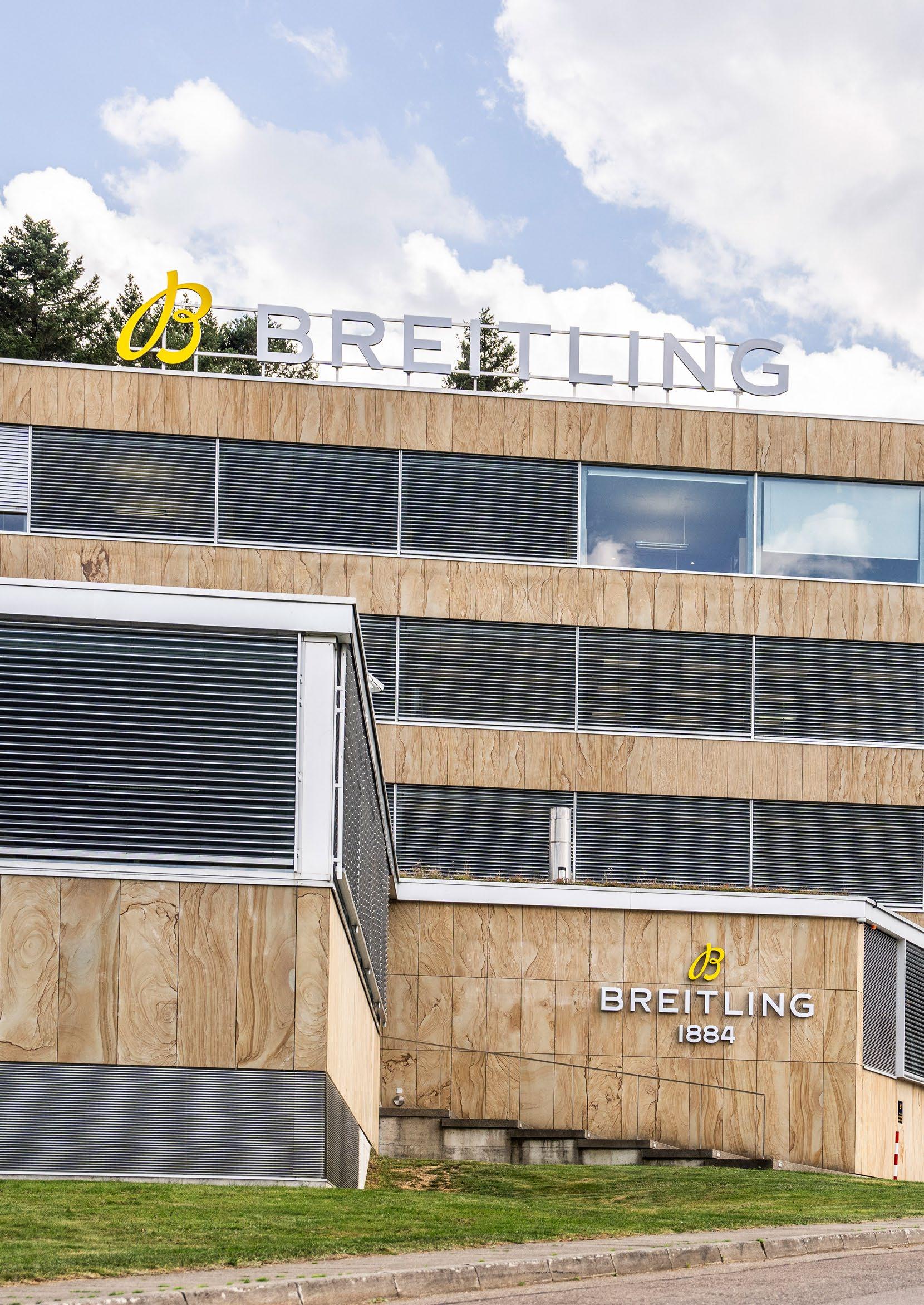

We conduct our business and engage with our stakeholders with the highest ethical standards and securing their privacy. We proactively manage sustainability at Breitling, guiding our efforts at the highest management level. Our actions are guided by a full-scope suite of policies publicly available on our website.

AUDIT & RISK COMMITTEE
INTERNAL AUDIT
BREITLING’S GOVERNANCE MODEL WITH FOCUS ON SUSTAINABILITY
SHAREHOLDERS AND GENERAL MEETINGS
BOARD OF DIRECTORS
CHIEF EXECUTIVE OFFICER
ESG COMMITTEE
NOMINATION & COMPENSATION COMMITTEE
EXECUTIVE MANAGEMENT
EXECUTIVE MANAGEMENT MEMBERS ACROSS BREITLING CONTRIBUTE TO FULL-SCOPE SUSTAINABILITY EFFORTS ACROSS THE PRODUCT, COMMERCIAL, MARKETING, OPERATIONS, FINANCE, DIGITAL & TECHNOLOGY, PEOPLE, AND ADMINISTRATION FUNCTIONS.
CHIEF ADMINISTRATIVE OFFICER
CHIEF SUSTAINABILITY OFFICER AND SUSTAINABILITY DEPARTMENT
INTERNAL BREITLING SUBJECT MATTER EXPERTS, EXTERNAL EXPERTS, SUPPLIERS, STANDARD AND CRITERIA SETTERS, VERIFICATION PROVIDERS, AND FURTHER AFFECTED GROUPS

Breitling commits to the highest standards of ethical conduct and corporate governance in our conduct of business and in all our interactions with our stakeholders. We frequently engage our employees in speaking up, providing feedback and sharing experiences with each other to support a positive corporate culture. We stay compliant with all regulatory and contractual obligations and refrain from any acts of corruption and anticompetitive behavior. Our decision-making processes and strategic oversight of our business are fostered by our mature corporate governance bodies and processes.
Our majority shareholder, since May 4, 2023, is Partners Group (PG), a leading global private markets firm. PG is invested alongside with our previous majority shareholder, CVC, a leading global private markets manager focused on private equity, secondaries, credit and infrastructure.
PG has a strong commitment to sustainability. Creating lasting positive impact is one of the core principles of PG’s charter and one that applies to all PG’s activities as a firm. It guides its investment activities, its corporate activities, and its daily interactions with all of its stakeholders.
At PG, oversight of ESG & sustainability lies with the most senior levels of its organization. Its board of directors is responsible for the overall strategy and direction, at portfolio and corporate level. It also sets ESG targets. Implementation is then delegated to PG’s executive team, led by its co-head Investments for portfolio-level and its CFO for corporate-level activities. PG’s executive team mandates its investment and group finance & corporate development teams to execute its sustainability strategy at portfolio and firm level, with oversight from PG’s chairman of sustainability, who acts as a bridge between PG’s executive team and its operational teams. To maintain high levels of risk management, value creation, and reporting standards across the platform, PG’s sustainability governance and control framework integrates ESG into the investment process and its enterprise risk management framework and assures independent monitoring of risks.
PG’s three portfolio sustainability focus areas are (i) climate change strategy for its environmental focus, creating long-term value by both investing in the low carbon economy and leading assets on their path to net-zero emissions; (ii) stakeholder benefits program for its social focus, building companies which employees desire to work for; reinvesting substantially into development, financial or well-being initiatives for staff; and (iii) sustainability at scale for its governance focus, developing its assets with an entrepreneur’s mindset, advancing sustainability and focusing on positive impact for all stakeholders.
CVC is committed to maximizing returns through the creation of sustainable value for its stakeholders. CVC believes that by considering material sustainability topics within its own operations, as well as in its investment approach, it can make more informed decisions and build businesses that are stronger and more resilient. Ultimately, CVC believes this contributes to the long-term success of the business and the investments it makes. CVC has four strategic priorities with respect to sustainability: (i) investing responsibly for long-term growth (ii) attracting, developing and retaining talent, (iii) building climate resilience and (iv) ensuring robust governance and accountability.
With respect to investing responsibly for long-term growth, this involves considering material sustainability topics as part of CVC’s investment thesis and due diligence, and working with portfolio companies to enhance their sustainability programs and make improvements during the holding period. CVC uses its value creation framework to help ensure a consistent approach to engaging and partnering with portfolio companies and investments on sustainability topics. Recognizing each investment opportunity is unique, CVC has a structured approach to help companies determine, and then focus on, what is most material to them with the objectives of building better businesses and creating sustainable value for stakeholders.
The company, headquartered in Switzerland, holds and controls directly or indirectly all the operational and manufacturing entities of the group. The group’s

Alfred Gantner
Daniel Pindur
Valérie Bessolo Llopiz
Gordon Bowen
Luisa Deplazes de Andrade Delgado
Andreas Holzmüller
Morin Oluwole
Yichen Shen
Can Toygar
manufacturing as well as other group key operations, such as design and product development, commercial, marketing, digital & technology, finance, administrative office (sustainability, legal, compliance, human resources, health, safety, and environment and facilities) as well as after sales operations, are headquartered in Switzerland.
Our group’s parent operating entity, Breitling SA, is overseen by our board of directors, which approves Breitling’s global strategy and major business initiatives and investments. The board of directors is responsible for the overall direction, development, and supervision of the group and its management, and decides on the group’s key policies, control and audit matters, risk management and significant operational matters.
New directors are selected based on specific criteria and further to a thorough search to gather the relevant skills within the board of directors. The aim of this exercise is to ensure that the board of directors is continuously in a position to provide leadership, strategic oversight and guidance and contribute to setting ambitious targets for the group and meeting long-term value creation objectives. When selecting candidates to the board of directors, the company considers the professional experience, qualifications, areas of expertise, age, gender and national background as well as leadership style, so
that at all times, the board of directors and its committees have the required competences.
The skills sought by the group for its board of directors include experience in strategy and business development, commercial, marketing and digital areas, finance and banking, experience in executive leadership and in the fashion and luxury goods industry, mergers and acquisition, risk management, environmental matters, governance and compliance as well as social matters and corporate culture, covering all material topics, as reflected below.
The board of directors considers the following criteria to determine the directors’ respective independence:
• The director has no conflict of interest which the board of directors determines as impacting their independence;
• The director has not served for more than 12 consecutive financial years as member of the board of directors;
• The director does not exercise nor has exercised an executive role or operational management tasks for the group within the last five years;
• The director is not a representative of a shareholder owning or controlling directly or indirectly more than 10% of the group;
• No family member of the director has been in the past

three years or is currently employed by the group;
• Neither the director nor a family member has received directly or indirectly any payments from the group (other than as a board remuneration);
• The director has not been employed by the group’s external auditor during the last three years;
• The director is not acting directly or indirectly as an advisor or consultant to the group;
• The director is not affiliated with a significant customer or supplier of the group, nor with a non-profit entity receiving significant contributions from the group;
• The director has no significant business connection with the group.
As of March 31, 2024, the board of directors was made up of four shareholder representatives and four independent board members, all of whom are nonexecutive. Women made up 33% of the board of directors, and 44% of board members were between 30 and 50 years old, with 56% above 50 years of age. Employees are not directly represented in the board of directors or the executive management by a dedicated employee representative.
On March 31, 2024, the board of directors was constituted of the following individuals with related functions:
Alfred Gantner, chairman of the board of directors since May 4, 2023 and board member since December 17, 2021, previously vice-chairman from December 17, 2021 until May 4, 2023 (master’s degree in business administration and management from the Brigham Young University Marriott School of Management, Swiss, 55, male), is the co-founder of Partners Group, and an executive member of the board of directors of Partners Group Holding AG (as well as a member of the corporate development committee and investment oversight committee) with previous positions as executive chairman and CEO as well as chairman of the global investment committee of Partners Group, and at Goldman Sachs (other current board membership at Esentia Energy Systems; former board memberships include Universal Security, VAT, USIC and PCI Pharma Services).
Dr. Daniel Pindur, vice-chairman of the board of directors since May 4, 2023, previously chairman from December 17, 2021 until May 4, 2023 and vice-chairman from 2017 until December 17, 2021, and chairman of nomination and compensation committee (PhD in finance, German, 46, male), is a managing partner at CVC Advisers (Germany) GmbH with previous positions at Goldman Sachs and at Sunrise Communications as CFO (other board memberships include Douglas, Sunday Natural, The Quality Group, DKV Mobility Services, and chairmanship at Tipico).
Valérie Bessolo Llopiz , board member since March 1, 2024 (master’s degree in international business administration, French, 52, female) is the senior vice president and international director of ELLE & ELLE DECORATION.
Gordon Bowen, board member since May 4, 2023 (bachelor’s degree in English literature from the University of Utah, United States of America, American/English, 73, male) is the founder of McGarryBowen, and global chairman/creative at dentsu. He previously held creative leadership positions at Y&R, McCann, and Ogilvy and was the creative director of the Salt Lake City Winter Olympics 2002 (other current board memberships at Utah Symphony, Ballet West and Saint Peter for Humanity).
Luisa Deplazes de Andrade Delgado, board member since April 27, 2022, chair of ESG committee (master’s degree in law, LLM and postgrad diploma in European studies, Swiss/Portuguese, 57, female, is an entrepreneur and investor with extensive international executive and board experience as CEO of Safilo Group, executive board member and CHRO at SAP, and local CEO Nordic and CHRO Europe at Proctor & Gamble, and a previous board member at, among others, AO World and ARYZTA (other current board memberships include chair at Swarovski and Schleich, vice-chair at Barclays Bank [Switzerland] and board membership at Ingka Holding [IKEA], DIA Group, Telia, and Fortum).
Andreas Holzmüller, board member since May 4, 2023, chairman of the audit committee since June 21, 2023 (master’s degree in accounting and finance from the University of St. Gallen [HSG], Swiss/German, 41, male) is a managing director at Partners Group (EU) GmbH since 2008 (other current board memberships at Schleich GmbH and Techem GmbH).

Omorinsola Yewande Oluwole (board member since March 1, 2024, bachelor and master degrees in human biology from Stanford University, Palo Alto, California, United States of America, and master’s degree in public health business management from Columbia University, New York, United States of America, American/Nigerian, 39, female) is the founder and CEO of MO Brand Consulting and former Global Head of Luxury at Meta (other current board membership at Biologique Recherche).
Can Toygar (board member since 2017, master’s degree in business administration and management, German, 41, male) is a managing director at CVC Advisers (Germany) GmbH and was previously with J.P. Morgan (other current board memberships at Douglas, Sunday Natural, The Quality Group, Tipico and Syntegon).
Yichen Shen (board member since June 22, 2023, master’s degree in business administration, Chinese, 35, male) is an executive director at Primavera Capital and was previously with KKR and Goldman Sachs.
A change was made to the board of directors’ composition after March 31, 2024 consisting in the resignation of Luisa Deplazes de Andrade Delgado.
The board of directors has established the following three committees composed of members appointed by and among the members of the board of directors: the audit & risk committee, the ESG committee, and the nomination and compensation committee.
The audit & risk committee as of March 31, 2024 is chaired by Andreas Holzmüller. This audit & risk committee aims to support the board of directors in its duties in relation to financial reporting and internal controls. Such duties include consideration of the appropriateness of accounting policies, the adequacy of internal controls, risk management and regulatory compliance. It exercises oversight over the major risks identified by the board of directors (including cybersecurity). The audit & risk committee is responsible for the supervision and approves the framework governing the work of the internal and external auditors of the group, each of which provides regular reports to this committee on findings arising from their work. In addition, our internal audit function is independent of our administrative management struc-
tures, and enhances, protects and advises on the organizational value by providing risk-based and objective assurance, advice, and insight on, among other things, our core processes, governance, risk management, control, and IT security. The chairman of the audit & risk committee reports regularly to the board of directors on the relevant findings, reporting and actions.
The ESG committee as at March 31, 2024 is chaired by Luisa Deplazes de Andrade Delgado. The ESG committee plays an important role in supporting the Group to develop its sustainability targets and plans in order to act accordingly. The ESG committee oversees sustainability related issues that may affect the group and its customers, including reputational and non-financial risks and receives relevant reports from the executive management on impact, risks and opportunities concerning ESG matters. The chairman of the ESG committee reports regularly to the board of directors on the relevant findings, reporting, and actions.
The nomination and compensation committee as of March 31, 2024 is chaired by Dr. Daniel Pindur. The nomination and compensation committee assists the board of directors in the succession planning, selection and nomination of candidates to positions to the board of directors, in particular ensuring that all required competencies for the strategic business oversight and risk management, including sustainability related material topics, are represented. The nomination and compensation committee advises the board of directors on the contractual terms of the employment and remuneration of the CEO and of the other members of the executive management. This committee also determines the conditions of general employment conditions, pension schemes and any short-term and long-term compensation schemes offered by the entities of the group.
The board of directors and each aforementioned committee convene regularly scheduled meetings with additional meetings held as and when required. Board and committee members receive supporting documentation in advance of the meetings and are entitled to request further information from the executive management in order to assist them preparing for such meetings.

Our board of directors appoints our CEO and has delegated to the fullest extent possible the management of the group to him who fulfils all executive duties and functions and prepare and implement all the board of directors’ decisions with the support of the other members of the executive management. As at March 31, 2024, the executive management consists of:
Georges Kern, chief executive officer since August 2017 (degree in business administration from the University of St. Gallen, Swiss, 59, male), previous positions within the Richemont Group as Chief Executive Officer, IWC Schaffhausen, Head of Watchmaking, Marketing & Digital, and board Member.
Nasr-Eddine Benaissa, chief commercial officer since September 2017 (master’s degree in business administration from HEC Paris, French, 55, male), previous positions, among others, at Eastgate Capital Group as managing partner, McKinsey & Co as partner, and Tag Heuer as regional sales director.
Daniel Braillard, chief operations officer since February 2021 (civil engineering designer, Swiss, 58, male), previous positions, among others, at Baume & Mercier as chief operations officer, and Richemont Group as leader of brands development.
Dr. Lars Kästle, chief financial officer since December 2019 (master’s degree in business administration and mechanical engineering from the Technical University of Braunschweig, and a Ph.D. in business administration and general management, German, 51, male), previous positions at Premium Aerotec as chief financial officer and EADS/Airbus as head of group controlling.
Alexander Middelmann, chief of staff since August 2017 (MA in economics & management from the University of Oxford, an MSc in finance from Imperial College London and an MBA from Harvard Business School, German, 39, male), previous positions at Richemont Group as chief of staff, and Boston Consulting Group as project leader.
Dr. Dominik Rubli, chief administrative officer since September 2018 (master’s degree in law from the University of St. Gallen, and PhD in IP law from University of Zürich, Swiss, 52, male), previous positions at Sunrise Communications as chief administrative officer.
Our double materiality assessment forms the basis for identifying and prioritizing material topics. Material topics form the basis for our sustainability strategy and targets, which are then ultimately defined by the CEO and executive management and reviewed by the ESG committee of the board of directors. Our sustainability performance against established targets is measured with key performance indicators that are reviewed together with the progress on key ESG topics at least quarterly by management and the ESG committee, which in turn reports to the board after each meeting – these happen on a quarterly basis or more often as needed.
The chairperson of the ESG committee has responsibility for ESG topics, including climate change, at the board level, whereas the Chief Administrative Officer manages ESG topics on the executive management level. The Chief Sustainability Officer is a dedicated senior management position on the extended executive management team and responsible for formulating and implementing our sustainability road map and initiatives. The role is further supported in the department by a Sustainability Manager and a Sustainability Specialist, along with numerous horizontal collaboration partners across the organization.
We are actively monitoring and implementing compliance with a comprehensive set of sustainability regulations that are shaping our global operations. Key areas of focus include supply chain due diligence obligations, particularly the Corporate Sustainability Reporting Directive (CSRD) in Europe and the Counterproposal to the Responsible Business Initiative (RBI) in Switzerland, which require enhanced transparency and accountability. We are also aligning with traceability regulations, such as those concerning deforestation and new battery laws, to ensure the integrity of our supply chains. Additionally, we adhere to anti-waste and labelling laws, such as France‘s AGEC, and comply with regulations on permitted and harmful substances like REACH. Our commitment extends to complying with laws related to sanctions, such as those affecting diamonds, as well as adhering to greenwashing regulations to maintain truthful and accurate communications. Finally, we are vigilant in upholding employment laws, particularly those concerning equal pay and working conditions, to foster a fair and equitable workplace.

Our sustainability mission is supported by a robust framework of key policies designed to ensure ethical conduct and regulatory compliance across all aspects of our operations. Our overarching policy is the Environmental, Social and Governance (ESG) Policy, which is supported by numerous dedicated guidelines. These include our Employee and Supplier Codes of Conduct (establishing standards for ethical behavior and responsible business practices), the SpeakUp Policy (providing a confidential integrity line for reporting unethical behavior and made available to all our stakeholders through our website), and the Anti-bribery Policy (prohibiting bribery and corruption in all forms). Additionally, our Anti-competition Policy and Guidelines (ensuring fair competition practices), the Sanctions Policy (complying with international sanctions) and Tax Policy further reinforce our commitment to ethical business. We also prioritize data privacy through our Data Protection Policies and Guidelines, which safeguard personal data and sensitive information.
Breitling has zero tolerance for corruption. The Breitling Employee Code of Conduct and international Speak Up platform, Breitling’s key anti-corruption policy and procedure, are made available to all employees to prevent, detect, and address allegations or incidents of corruption and bribery. Each employee worldwide has been trained on both tools and provided with quick reference documentation. We periodically refresh communications through our internal platform, Workvivo, to ensure that all employees are aware of and informed
about these tools and policies. These resources are accessible to every employee online at all times.
Further proactive measures that Breitling takes in order to mitigate the risk of corruption include third-party due diligence and detailed processes for executing corporate deals and ensuring adherence to all sanctions lists. We also monitor the risk that our products are used by third parties for purposes of bribery and take appropriate actions. Any incident or allegations of corruption are rigorously and impartially investigated with the involvement of the legal & compliance team and are reported to the ESG committee.
The Breitling Group is dedicated to maintaining an effective anti-corruption compliance management system contingent on the outcome of risk assessments. In FY24, a targeted anti-corruption and fraud risk assessment was conducted and identified procurement and sales functions in specific countries as higher risk due to their interactions with external stakeholders. Consequently, an action plan was developed to mitigate these risks and uphold the highest standards of integrity and compliance.
Effectively managing cybersecurity risks is also a top priority for Breitling. We maintain robust cybersecurity protocols through ISO 27001 certification and continuous improvement measures, including regular mandatory global training sessions. A dedicated internal team ensures cyber security is managed globally and locally within our subsidiaries, with frequent updates and ongoing education to strengthen defenses.
Monetary losses as a result of legal proceedings associated with fraud, insider trading, anti-trust, anti-competitive behavior, market manipulation, malpractice or violations of other related industry laws or regulations (CHF)


This report was prepared in reference to the European Union Corporate Sustainability Reporting Directive’s European Sustainability Reporting Standards (ESRS) 1: General Requirements, released on 31 July 2023 by the European Financial Reporting Advisory Group (EFRAG). It furthermore integrates the guidance of the Task Force on Climate-related Financial Disclosures (TCFD) and the Taskforce on Nature-related Financial Disclosures (TNFD), and is also aligned with the Global Reporting Initiative (GRI) and Greenhouse Gas (GHG) Protocol standards.
As we transition to the ESRS reporting structure, we maintain some metrics of the World Economic Forum / International Business Council Stakeholder Capitalism Metrics, upon which we guided our reporting in the 2021-2023 reporting cycles. We do so to the extent that these remain related to material topics in order to maintain consistency as we continually develop our reporting approach.
Breitling selected these reporting principles to proactively adopt this preeminent reporting structure and forthwith ensure consistent and comparable non-financial reporting.
In case of any data errata, Breitling will reissue the corresponding report if the total figures are impacted by more than 5%. In case of metric value reassignments or updates to the underlying data based on new information, no report reissue will be made, but will be duly disclosed in the course of the subsequent reporting cycle.
Unless otherwise stated, the boundary of the Sustainability Report is Breitling SA. Financial statements are however consolidated and include reviews of Breitling Holdings and Breitling SA. The time frame the report assesses covers April 1, 2023, to March 31, 2024, as the fiscal year of the Breitling Group.
Comparative data from prior reporting cycles is provided where available. To provide current data going forward, Breitling intends to issue a sustainability report on an annual basis.
The contact point within Breitling concerning this report is:
AURELIA FIGUEROA Chief Sustainability Officer aurelia.figueroa@breitling.com

E1 - Climate change
Climate change adaptation
Risk – upstream Areas subject to extreme weather events
Areas that will be subjected to increased temperatures and rainfall in future. Conditions will be more variable, cycling between severe wet and dry periods. Changing weather patterns will lengthen dry periods, leading to increased drought risk. In contrast, weather systems which do arrive in the area will bring increased severe rainfall, which can be a proxy for pluvial flooding risk. By cycling through extremes, increased stress will be placed on infrastructure, transportation, and agriculture in the affected regions.
Risk – upstream Increase in leather prices Increase in leather prices due to yield losses due to heat and water stress, and hurricanes (especially in the USA).
Climate change mitigation
Opportunity – upstream, own operations, downstream
Meeting climate objectives
Risk – downstream Increased cost of alternative materials development
Negative impact – own operations (actual)
Negative impact – upstream, own operations (actual)
Breitling scope 1 and 2 GHG emissions
Meeting climate objectives (science-based targets to meet the targets of the Paris Agreement), and satisfying key stakeholders across the value chain like investors and customers.
Increased cost of development for alternative materials to reduce dependency on natural resources (lab-grown diamonds, alternative leather, recycled steel or aluminum)
We generate Scope 1 and 2 emissions primarily through mobile combustion (vehicle fleet) stationary combustion (natural gas for heating) and electricity usage for usage for manufacturing, offices and internal boutiques. The emissions associated with these activities have a negative impact on climate change.
Negative impact – upstream (actual)
Breitling Scope 3 GHG emissions
Negative impact - upstream (actual)
Breitling food, beverage, and entertainment business Scope 3 GHG emissions
Breitling watches and indirect procurement materials business Scope 3 GHG emissions
Positive impact – upstream, own operations (potential)
Reduction of Scope 3 GHG emissions
Our value chain generates Scope 3 greenhouse gas emissions, stemming from activities such as business travel, purchased goods and services, employee commuting, upstream logistics, franchises, and energy & fuel related services, administration and production premises/facilities. The emissions associated with these activities have a negative impact on climate change.
Our food, beverage, and entertainment business activities generate Scope 3 emissions. Upstream production of food, transportation of food, the construction of capital goods and production of furniture for the restaurants result in those Scope 3 emissions. The emissions associated with these activities have a negative impact on climate change.
Our watches and indirect procurement materials business generates Scope 3 emissions, particularly in the extraction and production of raw materials and the associated logistics. Upstream activities such as mining, transportation of materials, and manufacturing processes conducted by suppliers result in these scope 3 emissions. The emissions associated with these activities have a negative impact on climate change.
Breitling has the potential to generate a positive impact by actively pursuing initiatives to reduce Scope 3 greenhouse gas emissions. For instance, identifying lower impact sources of gold and supporting low carbon transition in the gold sector, funding ongoing investments in alternative fuel sources, sourcing high-quality recycled and alternative materials for the boutiques, and adopting recycled materials across the value chain.

ESRS 3 - Water and marine resources
Water
Risk – upstream Diamond mining activities
Negative impact – upstream (actual)
Negative impact – upstream (actual)
Disruption of natural water flow due to sedimentation in diamond sourcing
Disruption of natural water flow due to sedimentation in gold mining
Direct impact drivers on biodiversity loss
Opportunity – upstream Shift to lab-grown diamond sourcing
The extraction, processing, and dust suppression activities from diamond mining need substantial water resources, that may become scarce in water stressed areas.
Note: By transition to lab-grown diamonds, Breitling is mitigating this risk.
Sedimentation (deposition of sediment in bodies of water in diamond sourcing) disrupts the natural flow of water, causing changes in hydrological patterns that can harm aquatic ecosystems.
Sedimentation (deposition of sediment in bodies of water in gold mining) disrupts the natural flow of water, causing changes in hydrological patterns that can harm aquatic ecosystems.
Resource inflows related to products and services
Opportunity – own operations
Use of recycled materials
Resource outflow related to products and services
Positive impact – own operations (actual) Managing design and lifecycle of our watches
Lab-grown diamonds provide a sustainable alternative to traditional diamond mining. This strategic shift reduces the ecological footprint associated with conventional diamond extraction, addressing environmental consequences such as soil erosion, land degradation, and habitat disruption.
treatment and opportunities for all
Positive impact – own operations (actual) Commitment to salary benchmarking and unconscious bias training
Opportunity to move to the use of recycled materials in Breitling boutiques.
Managing the design and lifecycle of our products to promote quality assurance, safety, traceability, transparency and animal welfare.
Our commitment to salary benchmarking, equal pay surveys, and unconscious bias training demonstrates a proactive approach to maintaining fair compensation practices and fostering diversity and inclusion in the workplace.
Our commitment to salary benchmarking and the conduct of equal pay surveys demonstrates a proactive approach to maintaining fair compensation practices. Additionally, efforts to offer unconscious bias training for employees involved in hiring and succession processes signify our dedication to fostering diversity and inclusion in the workplace.

Positive impact – own operations (actual) D&I initiatives and continuous education
We actively promote a positive impact through robust diversity and inclusion initiatives, ensuring equal and non-discriminatory access to opportunities for education, training, employment, career development, and the exercise of power. Through comprehensive policies addressing gender, racial or ethnic origin, nationality, religion or belief, disability, age, and sexual orientation, Breitling actively cultivates a diverse and inclusive workforce.
Opportunity – own operations Training programs
Opportunity – own operations Employee engagement
Working conditions
Positive impact – upstream (actual) Lab-grown diamond sourcing
Negative impact – upstream (actual)
Negative impact -upstream (potential)
Negative impact – upstream (potential)
Gold sourcing
Providing training, development and wellbeing for employees and engaging them in our sustainability journey. Our training program includes Breitling apprenticeship programs, sales training, After-Sales-Service technician training, internal and external f2f training programs the Breitling eLibrary: Coursera, Calm, Get Abstract, Languages Courses and Coaching.
The creation of the Employee Engagement Survey platform fosters open communication and the exchange of information on matters of common interest related to employee policy, ensuring diverse perspectives are considered in decision-making processes.
Negative impact – upstream (potential)
Negative impact – upstream (actual)
Health and safety in the diamond value chain
Sourcing lab-grown diamonds enables traceability and allows us to confidently confirm that our lab-grown diamonds are produced free of human rights abuses.
The gold mining industry, as reported by the International Labour Organization (ILO), stands as one of the most dangerous professions globally. Despite comprising only 1% of the world‘s labour force, the industry contributes to 5% of on-the-job fatalities. Workers in gold mining face significant risks, including dangers such as rock falls, tunnel collapses, fires, and heat exhaustion.
Negative health and safety impacts on workers in the diamond value chain (mined diamonds), such as mining accidents, chemical exposure, risks of incidents with occupation hazards.
Forced labor in gold and diamond mines
Workers in the value chain
Child labor in the gold value chain
In some gold and diamond mines, adults and children have become victims of forced labor and human trafficking. Forced labor is understood as a situation where an individual works involuntarily and under “menace of penalty.” Those who attempt to leave may face violence and other abuse. Human trafficking occurs when a person is recruited or transported by force, threat, or deception for the purpose of exploitation.
Impacts on workers in the value chain through pressure on availability of adequate housing, as well as water and sanitation supply, as a result of operations.
Children work globally in artisanal and small-scale mining, in violation of international human rights law, which defines work underground, underwater, or with dangerous substances.

Negative impact – upstream (potential)
Child labor in the gemstones value chain
Child labor during the extraction and production of precious stones can be a prevalent issue. Children are employed in different stages of the mining process including digging, sifting through gravel, and sorting gemstones. They can also be involved in the cutting and processing of gemstones.
Note: Breitling is not currently sourcing colored gemstones, and is aware of no such prior issues in its supply chains, but includes this potential negative impact for the purpose of completeness.
Negative impact – upstream (potential)
Forces labor in the gemstones value chain
Workforces in the mining and production of gemstones can labor under exploitative conditions
Note: Breitling is not currently sourcing colored gemstones, and is aware of no such prior issues in its supply chains, but includes this potential negative impact for the purpose of completeness.
Negative impact – upstream (potential)
Positive impact – own operations (actual)
Local communities affected through mining activities
Promotion of wellbeing and economic development
Opportunity – upstream Commitment to community engagement
Negative impact – upstream (potential)
Mining-related activities
Negative impact on local communities due to mining companies and governments abusing the rights of local residents when clearing land for exploration and mining.
Note: No such issues are known within Breitling supply chains, but this potential negative impact is included for the purpose of completeness.
Positive impact on affected communities by promoting wellbeing and economic development of communities affected by our business activities, preventing exploitation and contributing to inclusive growth.
Opportunity for greater product storytelling on our commitments to community engagement, leading to higher brand engagement.
Mining-related activities, encompassing both gold and other materials, contribute to social conflicts in the region. Mining and trade could help finance violent and abusive armed groups, including through money laundering. The absence of legal recognition for Indigenous Peoples as owners of their lands exacerbates vulnerabilities. In instances where mining leases are granted, Indigenous communities face the threat of eviction, leading to social unrest. This lack of legal protection perpetuates an unjust cycle, with Indigenous populations disproportionately affected by the consequences of mining activities.
Note: No such issues are known with Breitling supply chains, but this potential negative impact is included for the purpose of completeness.
Negative impact – upstream (potential)
Violation of rights of Indigenous Peoples in mining operations
Mining operations can cause violations of the rights of Indigenous Peoples, by for example failing to secure free, prior, and informed consent from Indigenous communities before doing exploration, which in violation of international human rights standards.

ESRS E4 – Consumers and end-users
Information-related impacts for consumers and/or end-users
Opportunity – downstream Transparency
Opportunity – own operations
Customer engagement
Opportunity – downstream Brand awareness through sustainability initiatives
Opportunity – downstream
Sustainability education
Opportunity – downstream Gain understanding of customer needs and wants
Corporate culture
Opportunity – own operations
Cultivating positive corporate culture
By being transparent, Breitling builds trust among our customers leading to increased engagement with the brand including through sales and net-promotion.
Ensuring customer satisfaction through prioritizing privacy, security and attentive service while engaging responsibly in public relations, lobbying, marketing and advertising.
Potential to gain entirely new customers for the brand who learn about it through headline sustainability initiatives.
Sustainability education to be more receptive towards sustainability related topics increases acceptance and demand for our USP in this area.
Listening to customers on sustainability related matters leads to a better understanding of customer needs and wants.
Protection of whistle-blowers
Positive impact – own operations (actual)
Positive impact – upstream, downstream (actual)
Animal welfare
Grievance mechanism in own operations
Grievance mechanism in the value chain
Risk – upstream Leather production
Cultivating a positive corporate culture at Breitling, characterized by integrity, transparency, and ethical business practices, serves as a strategic opportunity. This alignment with strong values and a clear code of conduct enhances employee morale, engagement, and a sense of purpose within the organization.
By using Speak Up, we encourage our employees to be an active part of a culture that is confident to raise concerns in a productive and safe manner. This allows the leadership team to intervene as early as possible to protect its employees, stakeholders, and society.
An effective whistleblowing protection program encourages our employees and suppliers to raise concerns in a productive and safe manner. This allows us to intervene as early as possible to protect our employees, stakeholders and society.
The production of leather, particularly through traditional methods like cattle farming, raises significant concerns about animal welfare. This could result in rising costs and new regulations in the supply chain.
Management of relationships with suppliers including payment practices
Positive impact – own operations (actual)
Trace compliance
We place emphasis on trade compliance in the employee code of conduct and ESG policy, adhering to export controls, embargoes, sanctions, and customs regulations.

Positive impact – upstream, own operations (potential)
Positive impact – own operations (actual)
Positive impact – own operations (actual)
Supplier engagement
By establishing and maintaining effective, transparent, and mutually beneficial interactions with suppliers, Breitling fosters a collaborative environment built on trust and openness. Fair payment practices ensure that suppliers receive timely and equitable compensation for goods and services provided.
Addressing ethical and legal issues
Fostering positive corporate culture
Addressing ethical and legal issues including internal controls, transparent management practices, and ensuring no fraud, corruption, bribery, or anti-competitive behavior.
We actively foster a positive corporate culture by emphasizing the avoidance of situations involving personal interest or conflicts. The CoC is part of our onboarding.

The following tables provide guidance as to where to find information related to all ESRS disclosure requirements of material topics.
Disclosure requirements without page indication are currently not included in the report. Further adherence to ESRS will be disclosed upon in future reporting cycles.
General basis for preparation of sustainability statements
BP-2 Disclosures in relation to specific circumstances
GOV-1 The role of the administrative, management and supervisory bodies
GOV-2 Information provided to and sustainability matters addressed y the undertaking’s administrative, management and supervisory bodies
GOV-3 Integration of sustainability-related performance in incentive schemes
GOV-4
GOV-5
SBM-1 Strategy, business model and value chain
SBM-2 Interests and views of stakeholders
SBM-3 Material impacts, risks and opportunities and their interaction with strategy and business model
IRO-1
IRO-2 Disclosure requirements in ESRS covered by the undertaking’s sustainability statement
MDR-P
MDR-A Actions and resources in relation to material sustainability matters
MDR-M Metrics in relation to material sustainability matters 12-14, 20-29
MDR-T Tracking effectiveness of policies and actions through targets 20-29

ESRS E1 CLIMATE CHANGE
ESRS 2, GOV-3 Integration of sustainability-related performance in incentive schemes -
E1-1 Transition plan for climate change mitigation 82-83
ESRS 2, SBM-3 Material impacts, risks and opportunities and their interaction with strategy and business model 72-81
ESRS 2, IRO-1
Description of the processes to identify and assess material climate-related impacts, risks and opportunities
E1-2 Policies related to climate change mitigation and adaptation
E1-3 Actions and resources in relation to climate change policies
E1-4 Targets related to climate change mitigation and adaptation
E1-5 Energy consumption and mix
35-38, 43-44, 72-81
Further information to be found in the ESG Policy
12-13, 25, 71, 82-86
12-13, 25, 71, 82-86
E1-6 Gross scopes 1, 2, 3 and total GHG emissions 82-83 Metric source: Greenhouse Gas (GHG) Protocol Corporate Standard
E1-7 GHG removals and GHG mitigation projects financed through carbon credits 86, 98-99
E1-8 Internal carbon pricing 77, 82-86
E1-9 Anticipated financial effects from material physical and transition risks and potential climate-related opportunities 77-81
ESRS E2 POLLUTION (MANDATORY DISCLOSURE REQUIREMENTS IRRESPECTIVE OF MATERIALITY)
ESRS 2, IRO-1
Description of the processes to identify and assess material pollution-related impacts, risks and opportunities
35-38, 43, 72-76
ADDITIONAL COMMENTS

ESRS 2, IRO-1
Description of the processes to identify and assess material water and marine resources-related impacts, risks and opportunities
43-45, 88-90
E3-1 Policies related to water and marine resources - Information to be found in the ESG Policy
E3-2
E3-3
E3-4
ESRS 2, SBM-3
ESRS 2, IRO-1
E4-6
ESRS 2, IRO-1 Description of the processes to identify and assess material resource use and circular economy-related impacts, risks and opportunities 35-38. 43, 45, 66-67, 94-95
E5-1 Policies related to resource use and circular economy 66-67 Further information to be found in the ESG Policy
E5-2 Actions and resources related to resource use and circular economy 94-95
E5-3 Targets related to resource use and circular economy 12, 25, 71, 94-95
source: GRI standard 301, disclosure 301-1

E5-4 Resource inflows
E5-5 Resource outflows
E5-6 Anticipated financial effects from resource use and circular economy-related impacts, risks and opportunities -
66-67, 94-95
66-67, 94-95
ESRS S1 OWN WORKFORCE
ESRS 2, SBM-2 Interests and views of stakeholders
PAGES ADDITIONAL COMMENTS
39-41, 103, 104-108
ESRS 2, SBM-3 Material impacts, risks and opportunities and their interaction with strategy and business model 13, 26, 45, 102, 119-122
S1-1 Policies related to own workforce 104-105, 122
S1-2 Processes for engaging with own workers and workers’ representatives about impacts 104-105, 122
S1-3 Processes to remediate negative impacts and channels for own workers to raise concerns 122
S1-4 Taking action on material impacts on own workforce, and approaches to mitigating material risks and pursuing material opportunities related to own workforce, and effectiveness of those actions
S1-5 Targets related to managing material negative impacts, advancing positive impacts, and managing material risks and opportunities 13, 26, 102
S1-6 Characteristics of the undertaking’s employees
S1-7 Characteristics of non-employee workers in the undertaking’s own workforce
S1-8 Collective bargaining coverage and social dialogue
S1-9 Diversity metrics
S1-10 Adequate wages
S1-11
S1-12 Persons with disabilities
S1-13 Training and skills development metrics
S1-14 Health and
S1-15
S1-16
and total compensation)
S1-17 Incidents, complaints and severe human rights impacts
26, 102

ESRS S2 WORKERS IN THE VALUE CHAIN
ESRS 2, SBM-2
Interests and views of stakeholders 39-41, 103-108
ESRS 2, SBM-3 Material impacts, risks and opportunities and their interaction with strategy and business model
S2-1 Policies related to value chain workers
S2-2 Processes for engaging with value chain workers about impacts
S2-3 Processes to remediate negative impacts and channels for value chain workers to raise concerns
S2-4 Taking action on material impacts on value chain workers, and approaches to managing material risks and pursuing material opportunities related to value chain workers, and effectiveness of those action
13, 26, 45, 102, 109-114
S2-5 Targets related to managing material negative impacts, advancing positive impacts, and managing material risks and opportunities 13, 26, 102
ESRS S3 AFFECTED COMMUNITIES
ESRS 2, SBM-2
ESRS 2, SBM-3
Interests and views of stakeholders 39-41, 103108, 115-117
risks and opportunities and their interaction with strategy and business model
Further information to be found in the ESG Policy
115
S3-1 Policies related to affected communities 104-105, 115
S3-2 Processes for engaging with affected communities about impacts 116-117
S3-3 Processes to remediate negative impacts and channels for affected communities to raise concerns 104-105
S3-4 Taking action on material impacts on affected communities, and approaches to managing material risks and pursuing material opportunities related to affected communities, and effectiveness of those actions 116-117
S3-5 Targets related to managing material negative impacts, advancing positive impacts, and managing material risks and opportunities - Targets are in development in consultation with affected communities and following the guidance of ESRS 2 MDR-T

ESRS S4 CONSUMERS AND END-USERS
ESRS 2, SBM-2 Interests and views of stakeholders
ESRS 2, SBM-3 Material impacts, risks and opportunities and their interaction with strategy and business model
S4-1 Policies related to consumers and end-users
S4-2 Processes for engaging with consumers and end-users about impacts
S4-3 Processes to remediate negative impacts and channels for consumers and end-users to raise concerns
S4-4 Taking action on material impacts on consumers and endusers, and approaches to managing material risks and pursuing material opportunities related to consumers and end-users, and effectiveness of those actions
S4-5 Targets related to managing material negative impacts, advancing positive impacts, and managing material risks and opportunities
129 Further information to be found in the ESG Policy
Targets will be developed in consultation with stakeholder group representatives and following the guidance of ESRS ESRS G1 BUSINESS CONDUCT
ESRS
GOV
ESRS 2, IRO-1 Description of the processes to identify and assess material impacts, risks and opportunities

Mission Control 19 Figures related to operating costs, payments to providers of capital, payments to government, and financial assistance received from the government are not disclosed due to confidentiality reasons.
Mission Control 19 Consists of prototype costs, direct R & D and product development expenses, staff costs, and depreciation.
Employment and wealth generation: economic contribution GRI 201-1, GRI 201-4
Planet 77 This is a disclosure provided in addition to the WEF IBC Stakeholder Capitalism Metrics
Planet 85 This is a disclosure provided in addition to the WEF IBC Stakeholder Capitalism Metrics
Shadow carbon price (CHF/tCO2E)
Recommendations of the TCFD; CDSB
R01, R02, R03, R04, and R06; SASB 110; SBTi
Consumption of key materials GRI 301-1
Note: Any reference made to GRI concerns the GRI standards of 2016 unless otherwise specified. This index and its content have been reviewed for accuracy and reflect that which will be published in the Breitling Sustainability Mission Report to be released in September 2024.


Grenchen Independent practitioner's limited assurance report on selected Greenhouse Gas Emission, Plastic Waste and Water Withdrawal indicators in the Sustainability Mission Report 2024 to the Management
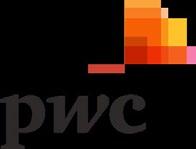

on selected Greenhouse Gas Emission, Plastic Waste and Water Withdrawal indicators in the Sustainability Mission Report 2024 to the Management of Breitling AG Grenchen
We have been engaged by Management to perform assurance procedures to provide limited assurance on the attached Sustainability Mission Report of Breitling for selected Greenhouse Gas Emission, Plastic Waste and Water Withdrawal indicators for the period ended 31 March 2024.
Scope and subject matter
Our limited assurance engagement relates to the following subject matters published in the Sustainability Mission Report 2024:
• Greenhouse Gas Emissions “FY24” in the table “Carbon accounting and targets” on pages 82-83:
o Scope 1 GHG emissions (CO2-eq); HQ mobile combustion, HQ stationary combustion, internal boutiques stationary combustion; subsidiary mobile combustion and subsidiary stationary combustion;
o Scope 2 GHG emissions (CO2-eq); HQ purchased electricity, internal boutiques purchased electricity and subsidiary purchased electricity;
o Scope 3 GHG emissions (CO2-eq); External boutique stationary combustion, external boutique purchased electricity, logistics, employee commuting, business travel, purchased goods, energy and fuel related emissions;
• Plastic Waste reduction on page 95:
Specific KPI on the plastic waste as described as the amount (expressed as a percentage) of: (Y-X) / Y where “X” means the actual plastic waste that results from the operations of Breitling AG (measured by weight) and “Y” means the estimated plastic waste that results from the operations of Breitling AG (measured by weight) as estimated and assuming no initiatives for reducing plastic waste are implemented;
• Water Withdrawal volume for headquarters measured in megaliters on page 88
Our assurance procedures on the subject matters described above exclusively covered quantitative statements for the selected indicators in the Sustainability Mission Report 2024 of Breitling AG in line with the criteria as specified below
The Greenhouse Gas Emission, Plastic Waste and Water Withdrawal indicators were prepared by Management of Breitling AG based on the following criteria (“suitable Criteria”):
• Greenhouse Gas (GHG) Protocol Corporate Standard (Revised edition);
• GRI standard 301, disclosure 301-1;
• GRI standard 303, disclosure 303-3
Inherent limitations
The accuracy and completeness of the selected Greenhouse Gas Emission, Plastic Waste and Water Withdrawal indicators in the Sustainability Mission Report 2024 (including the GHG statement) are subject to inherent limitations given
PricewaterhouseCoopers AG, Birchstrasse 160, Postfach, 8050 Zürich, Switzerland Telefon: +41 58 792 44 00, www.pwc.ch
PricewaterhouseCoopers AG is a member of the global PricewaterhouseCoopers network of firms, each of which is a separate and independent legal entity.


their nature and methods for determining, calculating and estimating such data. In addition, the quantification of the selected Greenhouse Gas Emission, Plastic Waste and Water Withdrawal indicators is subject to inherent uncertainty because of incomplete scientific knowledge used to determine factors related to the selected Greenhouse Gas Emission, Plastic Waste and Water Withdrawal indicators in the Sustainability Mission Report 2024 and the values needed to combine e.g. emissions of different gases. Our assurance report will therefore have to be read in connection with the suitable Criteria used by Breitling AG as published in the Sustainability Mission Report 2024.
Management’s responsibility
The Management of Breitling AG is responsible for preparing and presenting the selected Greenhouse Gas Emission, Plastic Waste and Water Withdrawal indicators in the Sustainability Mission Report 2024 in accordance with the suitable Criteria. This responsibility includes the design, implementation and maintenance of the internal control system related to the preparation of the selected indicators that are free from material misstatement, whether due to fraud or error. Furthermore, the Management is responsible for the selection and application of the suitable Criteria
Independence and quality management
We are independent of Breitling AG in accordance with the International Code of Ethics for Professional Accountants (including International Independence Standards) issued by the International Ethics Standards Board for Accountants (IESBA Code). We have fulfilled our other ethical responsibilities in accordance with the IESBA Code, which is founded on fundamental principles of integrity, objectivity, professional competence and due care, confidentiality and professional behaviour.
PricewaterhouseCoopers AG applies the International Standard on Quality Management 1, which requires the firm to design, implement and operate a system of quality management including policies or procedures regarding compliance with ethical requirements, professional standards and applicable legal and regulatory requirements.
Practitioner’s responsibility
Our responsibility is to perform an assurance limited engagement and to express a conclusion on the selected Greenhouse Gas Emission, Plastic Waste and Water Withdrawal indicators in the Sustainability Mission Report 2024. We conducted our engagement in accordance with the International Standard on Assurance Engagements (ISAE) 3000 (Revised) ‘Assurance engagements other than audits or reviews of historical financial information’ and the International Standard on Assurance Engagements 3410, Assurance Engagements on Greenhouse Gas Statements ('ISAE 3410'), issued by the International Auditing and Assurance Standards Board. Those standards require that we plan and perform our procedures to obtain limited assurance whether anything has come to our attention that causes us to believe that the selected Greenhouse Gas Emission, Plastic Waste and Water Withdrawal indicators in the Sustainability Mission Report 2024 were not, in all material aspects, prepared in accordance with the suitable Criteria
Based on risk and materiality considerations, we performed our procedures to obtain sufficient and appropriate assurance evidence. The procedures selected depend on the assurance practitioner’s judgement. In a limited assurance engagement under ISAE 3000 (Revised)/ISAE 3410 is substantially less in scope than in a reasonable assurance engagement in relation to both the risk assessment procedures, including an understanding of internal control, and the procedures performed in response to the assessed risks. Consequently, the nature, timing and extent of procedures for gathering sufficient appropriate evidence are deliberately limited relative to a reasonable assurance engagement and therefore less assurance is obtained with a limited assurance engagement than with a reasonable assurance engagement.
We performed the following procedures, among others:
• Inquiries of the relevant stakeholders for the selected indicators in the Sustainability Mission Report 2024;
• Inspection of relevant documents supporting the Sustainability Report;
• Sample-based testing of underlying data;
• Reconciliation of data sources with carbon accounting data and other underlying records;
• Reperformance of relevant calculations;
• Analytical procedures.
We believe that the evidence we have obtained is sufficient and appropriate to provide a basis for our conclusion.
3 Breitling AG | Independent practitioner's limited assurance report


Conclusion
Based on the work we performed, nothing has come to our attention that causes us to believe that the selected Greenhouse Gas Emission indicators on pages 82-83, Plastic Waste indicators on page 95 and Water Withdrawal indicator on page 88 in the Sustainability Mission Report 2024 of Breitling AG for the period ended 31 March 2024 are not, in all material respects, prepared in accordance with the suitable Criteria
Restriction of use and purpose of the report
This report is prepared for, and only for, the Management of Breitling AG, and solely for the purpose of reporting to them on the selected Greenhouse Gas Emission indicators on pages 82-83, Plastic Waste indicators on page 95 and Water Withdrawal indicator on page 88 in the Sustainability Mission Report 2024 and no other purpose. We do not, in giving our conclusion, accept or assume responsibility (legal or otherwise) or accept liability for, or in connection with, any other purpose for which our report including the conclusion may be used, or to any other person to whom our report is shown or into whose hands it may come, and no other persons shall be entitled to rely on our conclusion.
We permit the disclosure of our report, in full only and in combination with the suitable criteria, to enable the Management to demonstrate that they have discharged their governance responsibilities by commissioning an independent assurance report over the selected Greenhouse Gas Emission indicators on pages 82-83, Plastic Waste indicators on page 95 and Water Withdrawal indicator on page 88 in the Sustainability Mission Report 2024, without assuming or accepting any responsibility or liability to any third parties on our part. To the fullest extent permitted by law, we do not accept or assume responsibility to anyone other than the Management of Breitling AG for our work or this report.
PricewaterhouseCoopers AG
Thierry Troesch
Zürich, 26 September 2024
Alexander Schmidt
‘The maintenance and integrity of Breitling AG’s website and its content are the responsibility of the Management; the work carried out by the assurance provider does not involve consideration of the maintenance and integrity of Breitling AG's website, accordingly, the assurance providers accept no responsibility for any changes that may have occurred to the reported selected Greenhouse Gas Emission, Plastic Waste and Water Withdrawal indicators in the Sustainability Mission Report 2024 (including the GHG statement) or the suitable criteria since they were initially presented on the website.
4 Breitling AG | Independent practitioner's limited assurance report

